
The Passport Kids
Adventure Family Travel

African Safari with Kids: Things I Wish I Knew Before
In: Africa , Blog , South Africa by Nicole Last Updated: January 25, 2021
Sharing is caring!
An Africa safari with kids was on our bucket list to experience as a family, and it was honestly one of the best things we could have done in South Africa. We explored Kruger National Park with the kids, saw the Big 5 animals, spent days on safaris and had an experience that was beyond expected in Africa. There is something truly amazing about this country and I left my heart in Africa on our 1 year trip around the world .

Taking the kids on a safari had always been on the shortlist of experiences we wanted to do as a family. But when we first set out on planning the safari I had so many questions and concerns I didn’t know where to start or things to consider when arranging an African safari. So many misconceptions or things I felt really clueless about. We knew of a few people that had been on a safari but none with kids.
So I have decided to pull together all the questions that I had to help others take their kids on a safari. Basically… all the questions I had nobody to ask. So here they are:
What you need to know before you go on an African Safari:
Can children go on safari.
Yes, they most certainly can go on a safari! Kids love to see and watch animals in their natural habitat, so why wouldn’t they be able to go on a safari?! I know, I had the same question and I’m not sure where the preconceived notion came from but YES kids can go on a safari. Our kids were 5 and 8 when we went.

What is the minimum age for safari?
It all depends on the camps that you are lodging at. My best advice is to read the details or contact the lodge for clarification on age restrictions. Some can accommodate babies, toddlers, kids, and some consider 12 year olds to be adult age.
Some camps will have restrictions on open-air vehicles or bush walks with kids and some are adults only camps. Each of the camps has their own restrictions so depending on the safari experience you want, be sure the lodge can provide it for your family needs.
We found, in gen eral, more kid-friendly options for camps for kids age 6 and above. But, we found a camp that could accommodate our daughter who was 5 and son 8 in an open-air traditional land rover vehicle. They also had a junior ranger program and very kids focused camp. They may have been the only kids at the camp the few days we were there, but the lodging was very welcoming of kids!
Where is the best African safari?
We debated on a few different areas in Africa but decided on Kruger National Park in South Africa for a few reasons.
- Price of Flights: We got a fantastic price to get to Cape Town on flights as compared to some of the other areas in Africa.
- Time of Year: We wanted to go in October, so the climate was a good fit for safari timing in Kruger National Park .
- Immunizations: Due to the shortage of Yellow Fever immunization we ruled out a few countries (ex. Kenya).
- This was our first African country and overall we felt most comfortable with going to South Africa.
We looked into other safaris in Kenya, Tanzania, Namibia, Botswana and other areas in South Africa. Honestly, I think any safari experience will be amazing so try not to get overwhelmed, because I know I was. Look through the remainder of the questions below and it should narrow down your search criteria.
Next on our list would be Botswana or Namibia, just to try somewhere new.

How to decide on Safari lodging?
We booked our safari lodging only 5 weeks before we arrive. We also ended up coming during a school break, so we stayed longer in Cape Town and honestly started to look for any lodging that was available and would meet the minimum age restrictions. Look further down to what we would do differently… this is one of them!
Now that I know a bit more, choose your lodging based on the animals you want to see. So if you are wanting to see lots of elephants you should stay at a lodge that has plenty full in that area, etc. But, if all else fails this method worked and got us to a safari. Next time, we will book earlier and book based on animal experience.

Is it safe to take children on a safari?
In my opinion, yes it is safe to take children on a safari. Otherwise, I wouldn’t have taken my kids! There is some danger for anyone on a safari, regardless of age. Safety with animals, driving or other factors. We listened and asked lots of questions from our hired guide and rangers from the camps for the common sense safety tips when on a safari. With our youngest being 5 at the time, the ranger did advise us at the beginning of every game drive just to ensure the kids were sitting at all times, but that may have been from more of the driving versus the animal danger. At no point did I feel unsafe or in danger on our safaris or in our camps.

Did you need to take malaria pills?
Yes, we chose to take malaria pills for our family. Mosquitos are in Kruger National Park and carry the disease, so there is a risk. Malaria Monday’s was medication day for our family, one week prior to entry into the region and four weeks following. It was the first time the kids had to take actual pills (no chewable ) but well worth the opportunity to see these animals.
What is the difference between the safaris?
Basically, there are 3 different types of safaris that you can take.
Lodge Safari
The first and most likely vision you have in your mind is the open vehicle safari. These are typically arranged and included in with the lodges that you book . So you will most likely go out in the early mornings and late afternoon for open-air safari. A ranger and animal tracker will accompany you on the game drives around the lodges private (or shared) land. If it is private land, the vehicle can go off-roading and not be contained to the roads. This can sometimes allow you to get closer to the animals.

Hired Driver/Guide Safari
Another kind of safari is where you can hire a local to drive you (either an open-air vehicle or closed vehicle) and drive you around the Kruger National Park. These are typically all day events but can be shorter if you arrange with the hired driver. A hired driver is a local who knows the areas of the parks, can gauge the type of animals you are interested in seeing, educate you about the park etiquette and allow you to look for animals versus driving.
Self-Drive Safari
As the name precludes, this is where you drive yourself around Kruger National Park. So just as the locals do with their families, you can pay an entrance fee into the park and have a day pass to explore the park on your own. There are some rules and guidelines that need to be followed but this gives you the freedom to explore on your own.
We did all three of these types of safaris, and each has their uniqueness to the experience so just consider what you are looking for in your safari. I do suggest though in this order first a hired driver (to learn a bit about the area), then self-drive (feel like a local) and lastly lodge safari (up close with the animals).

How long should you go on a safari?
We spent 1 week in the Kruger National Park area. 4 nights in one lodge and then 2 nights in another lodge. My suggestion would be to split it up between lodges, maybe 3 days of safari, especially if you are on a private lodge. After 2 nights in the private lodge, we were ready to move onto another and see a different area. With the private lodge, you are usually restricted to their routine – breakfast, lunch and supper served, game drives and activities all on a pre-scheduled time so freshness from another lodge after a couple of days is recommended. The one lodge we spent 4 nights at was more of a camp where we had to arrange our days, so we spent days not only on safaris but visiting a few things in the area too. Hoedspruit Endangered Species Centre , Reptile Centre , etc.

What is the best time of year to visit Kruger National Park?
The best time to go to Kruger is at the beginning or end of the region’s dry season, which falls between April and September. This also coincides with the peak season in Kruger National Park , but look for the shoulder seasons for some deals. We ended up going in mid-October, the weather was comfortable for touring around. Some cooler mornings in the open-air vehicles with some rain, but also sunny warmer days too.
Think about looking for animals with your timing, this was a reasonably easy time of the year to see animals because there was minimal greenery and foliage for the animals to camouflage into.
What is the best African Safari tours?
We looked into a full 10-day tour of Kruger National Park with an African safari tour and decided against a pre-arranged tour. These are the ones where your entire 10 days are booked with food, what to do, transportation, etc. These tours were extremely expensive for us and we prefer to book things on our own.
We decided to book our own accommodations and review the places we wanted to stay at. With the private lodge, like our stay at Kambaku Safari Lodge , all the game drives, bush walks and food was included with their pricing. The other lodge had breakfast and dinner included in the price, and I contacted the owner directly for her recommendations on a local hire for safari. There is also the option of booking these tours individually here which is another great option if the lodging doesn’t offer it independently.
So it all depends on the experience you want. For us, we felt the extra cost of the heavily organized tour was not the experience we were looking for. We wanted the safari experience, and we were able to accomplish that without a tour operator.
Here are some other options for tours that you can book directly with the company for day trips:
Can you hire/rent a car for a safari?
Yes, you can hire/rent a car and drive in Kruger National Park. In hindsight, we rented a car and probably should have splurged for the SUV or truck to be able to see higher up, but it was just fine. No issues with clearance or driving a rented vehicle in the park for a safari. These can be rented from the airport, but be sure to book in advance since the airports are smaller and vehicles are limited.
Warning – you might be driving on the other side of the road… left side road driving here so it might be a bit of a change for people from North America. Ensure you have an international drivers license too!
If you are only going on a private safari you will not need to rent a car, the pickup and drop off from the airport is usually included in the lodging prices or can be arranged with the lodge itself for a fee.
What are the Big 5 on a safari?
One of the goals of going on a safari is to see the Big 5! This also helps keeps the kids eyes busy looking for animals. The BIG FIVE was derived from the 5 most difficult animals in Africa to hunt by foot.
- Rinosuarous
- African Elephant
- Cape Buffalo

What are animals you will see on African Safari?
Although the BIG 5 animals are truly remarkable animals, there are plenty of other animals that should be on your list to see on a safari. Our other favourites were:
- Hippopotamus

How much is a safari trip to Africa?
There is a large range in cost for safaris from cheap budget camps to luxury camps. It all depends on what you want, we split it between both budget and luxury. Over our entire year of full-time travel this was the most expensive week, but totally worth every dollar spent! I would spend it all over again for the experience. We also spent 12 nights in Cape Town at the front of our trip so the cost of the flight could be distributed over 20 days total in South Africa. I broke down our approx cost below:
- Flight ( Abu Dhabi – Cape Town One way) – $3,300 for 2 adults & 2 kids
- Flight (Cape Town – Hoedspruit Return) – $2,500 for 2 adults & 2 kids
- Kambuka Lodge – $2,900 for 2 nights
- Nadabushi Lodge – $1,100 for 4 nights
- Hired Safari Guide – $500 per day
- Car Rental – $200 for 4 days
- Food & Extras – $500
- Total – $11,000 CDN for 1 week
Prices will vary with peak season, lodging and where you are flying from. But, for us this cost was drastically lower than booking from a tour operator.

Would we go back to Kruger National Park or another safari?
Yes, a thousand times over! We have stated that if any of our family or friends are going we would gladly go again. We think it was the best option for us to have our first safari, but Botswana and Namibia are now on our next list to check out.
What would we do differently?
We would book earlier. Not that we didn’t enjoy the lodges that we went to, they were fantastic, but we didn’t realize how many options there are and would like to select now based on the viewing of the animals. We would like to stay IN Kruger National Park at one of the lodges there for a different experience. These generally get booked up well in advance, so after visiting a few of them on our self-drive and hired drive we would like to stay inside the park next time.
Do you have any other questions? If so, post them below in the comments and I will help in any way that I can.
Happy safari planning!
Disclaimer: This post contains affiliate links. This means that should you click on certain links, and then subsequently purchase a product/service, we will receive a small commission. It costs nothing extra to you but helps us keep the site running and sharing ideas of getting kids travelling the world to you. Thank you for supporting us in this way and we hope you found this information to be useful in your travels.

Note: This post may contain affiliate links, which means we may receive a small commission, at no cost to you, if you make a purchase through a link. More Info: Disclosure
Connect With Us
Ana Katrina Lopez says
April 20, 2019 at 5:58 am
Thank you for these tips! I actually am planning to go on a family safari trip with my cousins and some of them are young children. I’ve been worried about having them tag along. But I feel a little more relieved after reading your post. It doesn’t seem as stressful as I thought it would be to have children join in the safari. I hope my family enjoys the trip as much as yours did!
The Passport Kids says
April 24, 2019 at 10:59 am
I am glad the tips helped relieve some worrying. It will be amazing!!! To be honest sometimes having the viewpoint of the kids along will open your eyes too. We had one fellow guest that was at our safari lodge that requested to go with our family because of our kids. She wanted to experience the safari with how kids see it and all the different questions and things they see differently. It surprised both us and the guide because most adults don’t want kids around to “ruin” their experience, but in the end, she felt it gave her a better experience and thanked us for allowing her to join our family on the safari. Enjoy every moment of the safari and the more you are relaxed then the more the children will relax and marvel at the experience. So excited for you – have an amazing time!
Mindy Jollie says
July 10, 2019 at 2:34 pm
I like that you incorporated all three types of safari into the experience with your kids. I imagine the interactive component is the most important part to any kid. If I did go on a safari with my family, I would want to be able to see and interact as much as possible.
July 15, 2019 at 10:59 am
Totally, the interactive part of the safari is an important part of experience. All are so different but so great for a family. Learning and observing about these animals is such a great experience for the entire family.
jim corbett says
July 18, 2019 at 6:25 am
Safari with the kids is amazing because they get chance to close with nature and wildlife. And these are the amazing tips to do it with kids. Thanks for this great post, I really appreciate your work.
July 18, 2019 at 9:48 pm
Thanks so much Jim. Safaris are truly amazing for kids to experience! Nature and wildlife is the perfect combo with kids.
Ernest Elisha says
March 30, 2021 at 3:12 pm
What a great post, Thanks for sharing!
March 30, 2021 at 4:47 pm
So glad you thought is was helpful and so wish we could start planning for our next family safari!
Gerald Eseru says
April 4, 2023 at 6:49 am
thanks a lot this article is so helpful
May 10, 2023 at 12:50 pm
So happy you found it useful
Aa tours Rwanda says
April 2, 2024 at 9:30 am
very nice article thanks a lot
Leave a Reply Cancel reply
Your email address will not be published. Required fields are marked *
This site uses Akismet to reduce spam. Learn how your comment data is processed .

African Safari With Kids: First-timer’s Guide & Helpful Tips
By Author Jurga
Posted on Last updated: April 24, 2024

Are you thinking of going on safari with kids , but not sure what to expect? This post should answer all your questions about taking your kids on safari. Read on!
There is a common belief that safari and family travel doesn’t go well together. Let me tell you that it’s not true. I decided to write this post because of all the emails I get from readers asking me about taking their kids on safari. I hope this will help to answer some of your questions, ease your fears, and most important – show you that you can have an unforgettable African safari experience, also with young children.
We are in no way experts of traveling to Africa with kids. We are just a family who likes to travel, take the kids along, and share our experiences hoping to inspire others to do the same.
It just so happens that South Africa was our first far trip with all three kids. And so the twins went on their first safari game drive when they were just 2 years old. Our oldest was 4. A year and a half later, when our kids were 3, 3, and 5, we made a beautiful four-week road trip in Namibia .
We attended as many sundowners and game drives as we possibly could, we made self-drive wildlife viewing trips, watched animals at the waterholes, and had so many unforgettable safari experiences with kids.
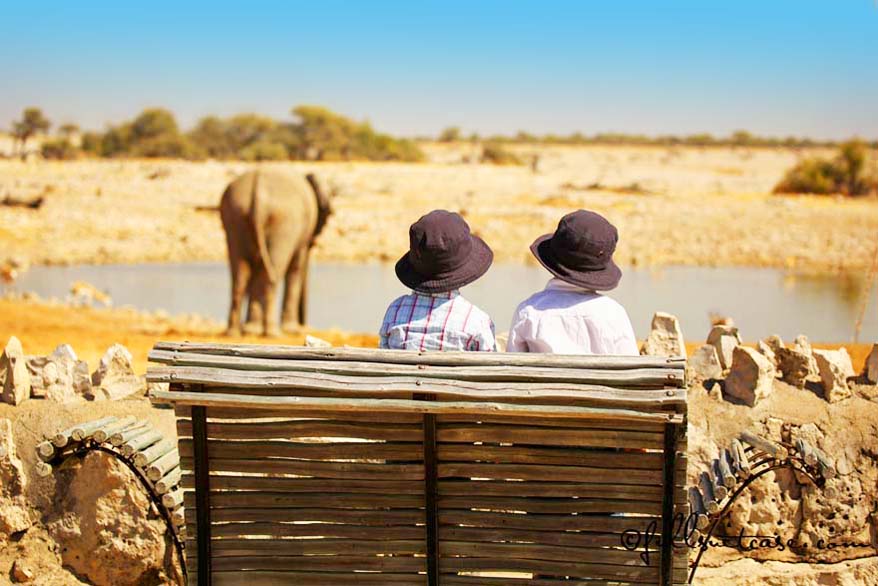
So here is some practical information you may want to know when planning an African safari with young children. I have compiled all kinds of questions that I have received from my readers about taking kids on safari in Africa.
If you don’t find an answer to your question below, please feel free to leave a comment at the bottom of this page, and I will try my best to help you out.
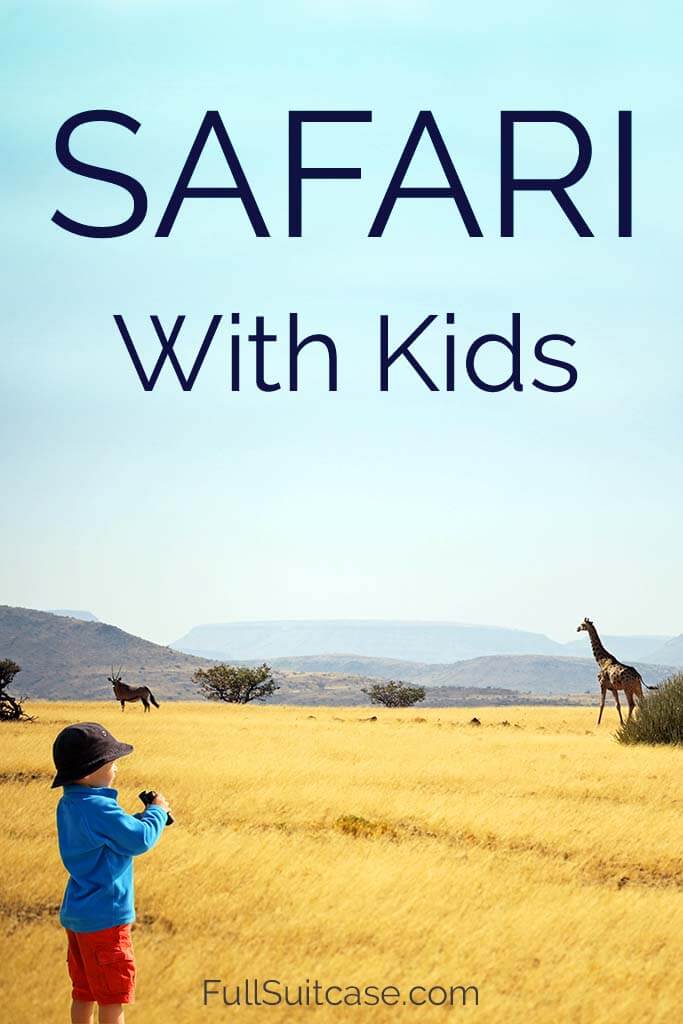
Which African countries are best for a safari with kids?
In my opinion, South Africa and Namibia are the best countries for families traveling to Africa. There are several reasons for this.
First, both countries have good wildlife viewing that is easily accessible . You can visit Kruger National Park or Etosha National Park with your rental car. This is not the case in most other African countries, where you need to have a guide/driver to visit national parks. Self-drive safari is always cheaper and it allows you to take kids of any age on safari.
Second, Namibia and South Africa both have very small malaria risk in certain periods. So you can take your kids on safari without having to take malaria pills. See question 4 for more information.
Third, both countries are relatively safe for an individual family trip . I say ‘relatively’, because, well, bad things can happen anywhere. As everywhere else in the world, you have to use common sense. We never felt unsafe anywhere in Namibia. As for South Africa, most places are completely safe, just be cautious around townships next to the big cities, like Johannesburg.
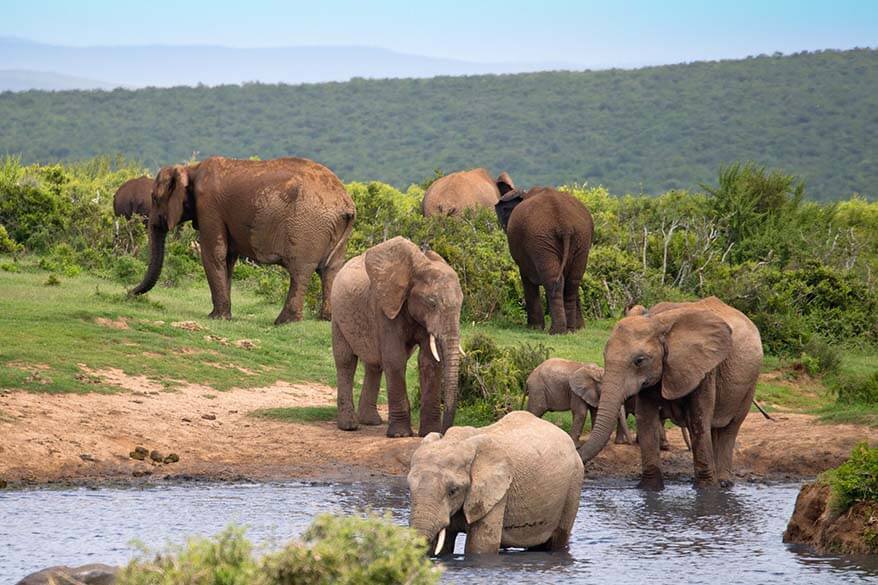
How old do my kids have to be to go on safari in Africa?
While most organized safari trips and game drives have various age restrictions, there is no age limit for a self-drive safari. Our kids’ first safari experience was when they were just 2 years old. It was a guided game drive in a private game reserve on the Garden Route in South Africa. Here you can read more about our South Arica trip with young kids .
In Namibia, we could join several safari rides with a guide, but there were also other places that wouldn’t take kids under 6 years. Some others would allow young kids on safari rides, but would warn you from the start that they would not stop anywhere near the ‘cats’ (lions, leopards, cheetahs) with such young kids in an open vehicle.
If you are thinking of taking a longer safari trip with nothing but animal viewing for a few days in a row, you better check with the organizing company what their policy is in regard to kids’ ages. For Kenya or Tanzania safari trips, I think usually kids have to be at least 6 years old.
How many days do we need for safari with kids?
This will depend on the destination of your choice. In Kenya, Tanzania, Botswana, and many other African countries, the purpose of the whole trip is often nothing else but animal viewing. So you are in a safari vehicle for days and days in a row.
Honestly, I think that these kinds of trips are too long and too boring for young kids. Even most adults will probably have seen enough wildlife after 7 days, let alone children…
That’s why – again- South Africa and Namibia are excellent choices to take your kids on safari. Both countries have so much more to offer than just animal viewing. So you can combine safari drives with many other sightseeing possibilities.
I think that 3-4 days of safari in a row is more than enough for any child. If you can add some variation to your trip and go watching animals every couple of days rather than a week in one go, you will have a much more relaxing and fun trip.
Can we go on safari with a 2 – 3 year old? 4, 5, 6 year old? And for how long?
I wouldn’t advise long safari trips with kids younger than 6. Here is a breakdown per age of what I think is best when considering safari with young kids.
- 2-3 year old kids: Half-day game drives, self-drive safari and wildlife viewing at waterholes. You can do this for several days, but don’t take a 2-year-old on a 3-day safari experience with nothing else on the program than wildlife viewing.
- 4-5 year old kids: Half-day to full-day safari drives, either with your own vehicle or on guided safari tours. I would advise against a long safari trip with nothing else than wildlife viewing at this age.
- 6-8 year old children: I guess it depends on your child, but most kids at this age should be able to sit still in a car for a day, and so a longer safari trip is possible. You have to be aware though that safari involves lots of driving and searching for animals, which is not always as exciting as the actual viewing of the animals.
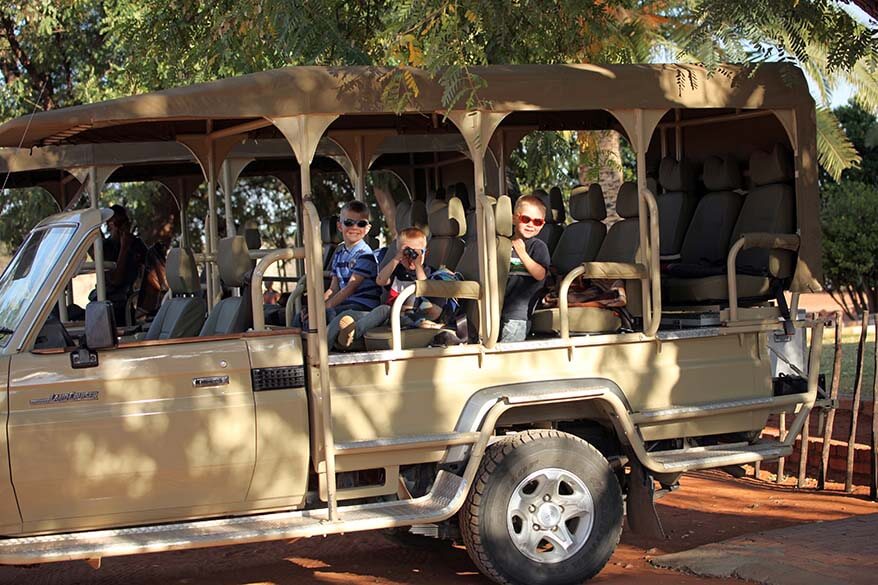
Is it dangerous to take young kids on safari?
As with everything, if done with caution, safari is perfectly safe with kids.
For self-drives, remember to stay in your vehicle at all times. It’s not because you don’t see animals, that they are not there. Don’t make too much noise in the car when animals are nearby, and certainly don’t stick your arms outside the window, not even to take a picture.
For guided game drives with kids, you have to remember that you are in an open vehicle. Kids shouldn’t make noise, and the same rule applies here too – you shouldn’t stick your head or arms outside the vehicle. Follow the instructions of your guide.
What about malaria pills for young kids?
I can’t really answer this question, because we have always chosen to visit malaria-free areas with our kids up to now. I always read that malaria pills aren’t advisable for young kids under 5-6 years old. And since there are perfectly nice malaria-free areas to take your kids on safari, why would you take the risk…
We visited Kruger NP and Etosha NP in July (African winter), when malaria risk is very low. We used mosquito sprays with DEET, but that’s it. The southern part of South Africa is malaria-free all year round. There are several private game reserves in that area, and also Addo Elephant National Park is malaria-free. All perfect places for the first safari with kids.
If you are traveling to an area that has high malaria risk, make sure to talk to your doctor before the trip. For more medical information you can check the website of the Institute of Tropical Medicine in Antwerp, Belgium . You can find medical advice for any country you are traveling to.
Do we need any special vaccinations when going on safari with kids?
In most African countries you do need some type of vaccine, both for kids and for adults. Make sure to check the medical information for the country you are visiting before the trip.
Some countries require a yellow fever vaccination. It’s not the case in South Africa and Namibia.
What to pack for kids on safari?
In one of my older posts, you can find safari tips , including a complete safari packing list.
You don’t really need to pack anything special for kids on safari. Except – my best tip – pack one pair of binoculars for each child. It keeps them interested and engaged during the rides. Safari involves lots of driving and lots of patience. Binoculars are better than any toy. Just don’t waste your money on toy binoculars, there are plenty of affordable decent quality binoculars that kids can use.
If your kids can read already, it might be interesting to take a book or an African wildlife guide , so that they can look up in the book what kind of animals they saw, etc. But don’t count on doing much reading on the bumpy roads in Africa’s National Parks.
Always take a sweater on safari, mosquito spray, sunscreen lotion, a sun hat, and sunglasses. Leave all the toys at home, unless you are doing a self-drive safari, in that case, pack whatever you would normally pack to keep the kids busy and happy in the car . For our kids, audiobooks do wonders!

Do we need khaki color clothing when going on safari?
It’s popular to think that you need to buy a whole new garderobe in khaki colors when going on safari. But in most cases, it’s really not necessary.
It might not be such a good idea to go on a walking safari wearing a red t-shirt, but for a self-drive safari in a closed vehicle colors don’t matter at all. After all, you are sitting in the car all the time.
For open-vehicle safari drives I would advise against bright colors, but then again – you don’t need to buy ten new t-shirts for every kid. Just pick the ones that are less bright and that’s it.
If you buy one thing, then it might be wise to invest in a light-brown safari shirt with long sleeves . You can wear it several times, also over other t-shirts, it protects against mosquitoes, and also against the sun.
As for the colors of sweaters and jackets. Our kids had very bright rain jackets that we packed for our trip to Namibia. I wasn’t going to buy three new jackets just for that trip. And you know what, the only time we needed those jackets was early in the morning or late in the evening, when it was dark, so the color didn’t matter at all.
If you are visiting Kruger in winter (July-August), you may need to wear a sweater or a jacket during the day as well. In that case, it might be wiser to pack something in a light brown or dark color. But you will see people wearing all kinds of colorful clothing on the game drives in Africa.
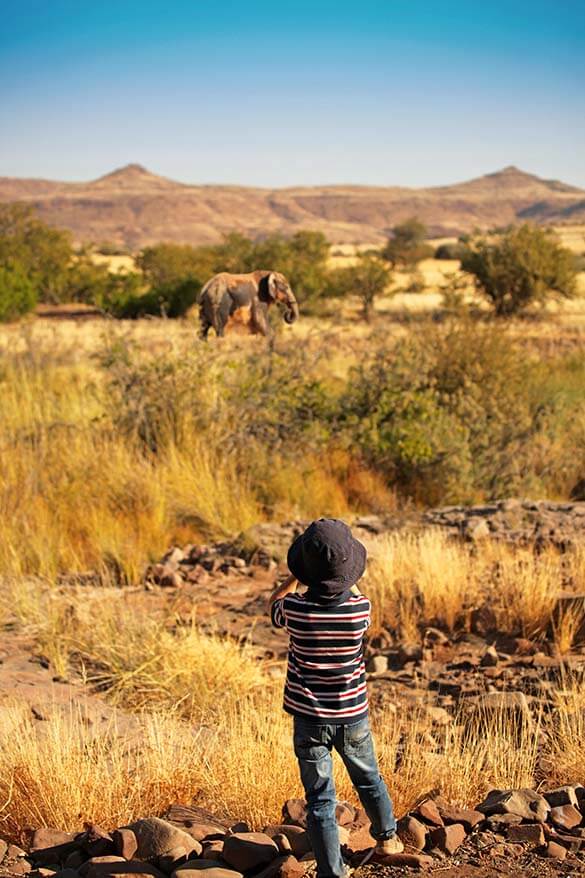
What kind of shoes to pack for kids on safari?
It doesn’t really matter what kind of shoes you or your kids wear, as you will be sitting in the car all the time anyway. I would advise wearing closed shoes at all times if you are going in an open vehicle. It can get really cold during early morning and sunset game drives.
What if my child has to go to the bathroom during a safari drive?
In some areas, this may be a problem, yes. If you know that you are going to drive in an area where it’s forbidden to get out of the car, make sure that the whole family goes to the bathroom before you leave. Also, be sure to plan some stops in the rest camps along the way.
For example, in Etosha NP, there are some fenced picnic areas with toilet facilities. They are indicated on the map of the park that you get at the entrance. Plan a bathroom stop every two hours or so. And always make your kids go to the bathroom when you can, even if they tell you they don’t have to.
Having said all this, I know that sometimes kids ‘just have to go’. In a way, it’s easier with young kids who still have diapers. Ours were at a difficult age (3) when we were in Etosha. At one moment we just stopped and let our son pee through an open door of the car, while we were watching the area to make sure there were no animals nearby.
Once again, animals can be very well camouflaged, so try to avoid toilet stops in dangerous areas.
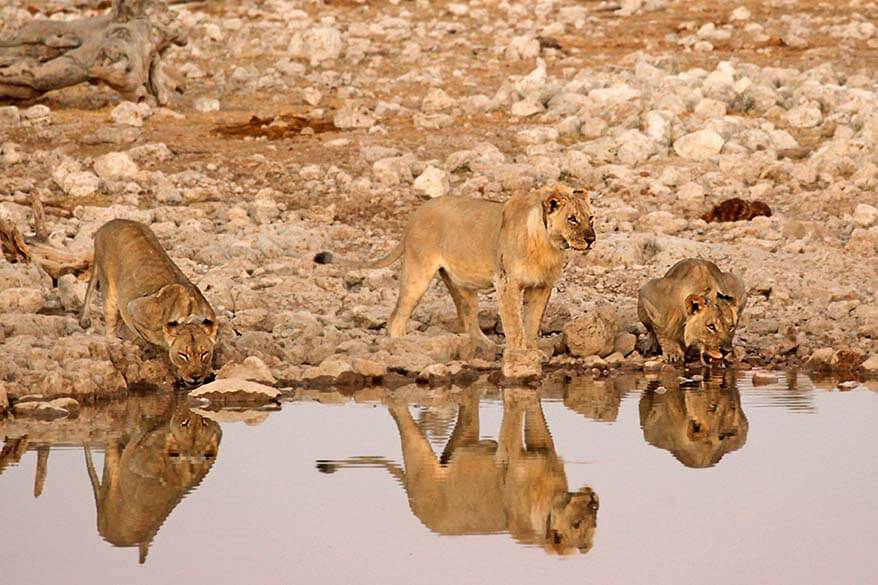
What about food – can we take snacks on safari?
Most organized safari trips have some kind of meal included. Usually, the guide will stop the vehicle in a safe area, set the table outside, and you will have an unforgettable meal in an African savannah.
Most guided safaris will include water and other drinks. But you should always take some water with you. I would definitely take some snacks for the kids. There is nothing worse than a tired, bored hungry kid, isn’t it? Favorite snacks can be a life-saver during long safari drives with kids.
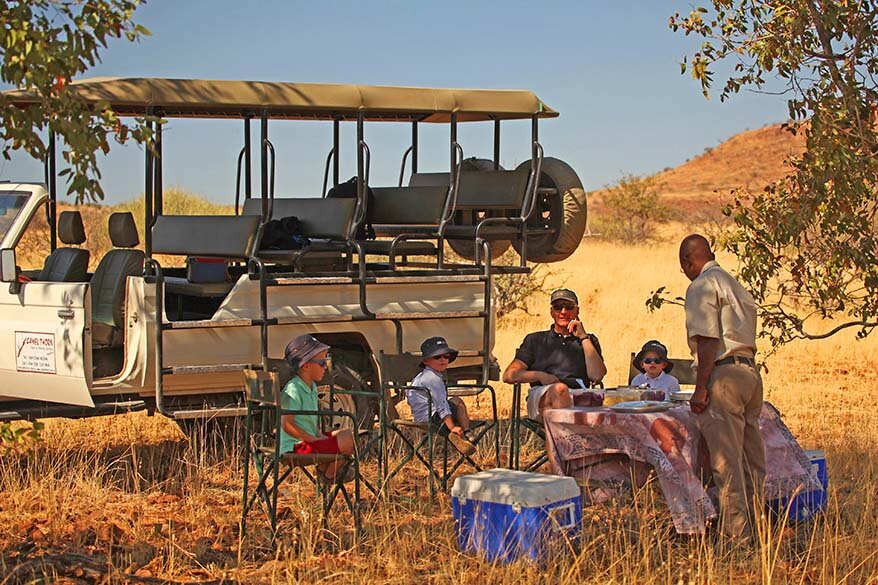
Are there better ways to see African animals with kids than sitting in a dusty vehicle driving on bumpy roads for hours?
As a matter of fact, there are. But you will need to do some research before the trip. One of the best ways to see African animals is by visiting waterholes or rivers.
Some lodges, hotels, or rest camps have beautiful waterholes with lots of animals visiting them during the whole day. Some others might have a waterhole where you hardly ever see any animals at all. And many others don’t have waterholes at all.
One of the best waterholes we came across during our trips in Africa is the Okaukuejo waterhole in Etosha National Park in Namibia. Animal viewing was so good there that we stayed by the waterhole the whole day, in the evening, and also at night.
It’s by far the most luxurious way to see safari animals with kids! They could even go to a nearby shop and get some ice cream to eat while watching hundreds and hundreds of animals. The best part is that Okaukuejo rest camp is a government-run place and the prices are really reasonable.
Another place that has a really good active waterhole is the Old Traders Lodge in Erindi private game reserve (also Namibia). Staying at the lodge is quite expensive though, but day visitors can sit on the terrace and watch the waterhole too. Still, if your budget allows it, I would advise staying at least one night in Erindi. It’s one of our favorite lodges in Namibia, and no, this mention is not sponsored.
I am sure there are many more lodges that have good waterholes with plenty of wildlife viewing. So do some research and you might be rewarded with the most unforgettable experience!
If you are driving around a national park looking for animals and your kids get tired or car sick, why not take a break and stop by the river or at any waterhole you come across. If you just sit and wait, you might see more animals than by driving around and looking for them.
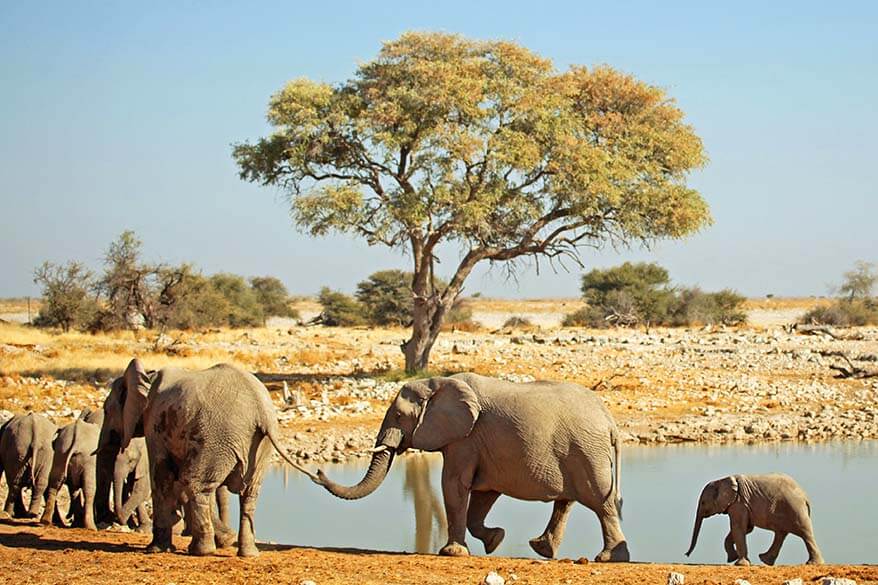
How expensive is it to go on safari with kids?
As with any trip, the cost can be just as low or as high as you want it to be. As I said, one of the cheapest ways to go on safari with a family is by doing a self-drive road trip in South Africa or in Namibia. Flights, rental car, and hotels are all you need. Park entrance fees are usually very reasonable, and often free for kids.
Here you can find the best accommodation deals for visiting Kruger NP , Etosha NP , and Addo Elephant NP .
You can also opt to do an organized day game drive , in combination with the self-drive safari. This is what we usually do. The price of these game drives depends on location and duration, and also if you are sharing the vehicle with others. It’s really impossible to give an estimate of the price because so much depends on the location and the tour that you book (the duration, private or with a group, etc.).
Here you can find some organized game drives for Kruger National Park (South Africa), Etosha National Park (Namibia), or Addo Elephant National Park (South Africa). It will give you a good idea of the cost.
The good news is that very often kids under 6 travel free (if they are allowed). Older kids get discounts. We were often lucky to pay a shared rate for just 2 adults and have the whole safari jeep to ourselves.
This is not guaranteed (unless you pay the higher rates for a private trip), but from all the game drives we did, we only had to share a jeep with another family once. While most other vehicles departing at the same time usually had 8-12 passengers, we had the luxury of a private game drive for a very low price. You see, traveling with kids has some benefits .
If you are thinking of booking a private safari with a guide/driver in Kenya or Tanzania , then it can quickly cost you 3,000-4,000 EUR/week/person and even more (it all depends on the accommodation choices and the season when you travel). On the other hand, everything is then organized and arranged for you.
Do you have more questions about taking your kids on safari?
So, these are the answers to some of the most frequently asked questions about taking young kids on safari. My intention is to update this post with any other questions/answers in the future. So don’t hesitate to let me know if I left something unanswered. You can do so by leaving a comment below.
READ ALSO: South Africa with Kids and Namibia with Kids
If you found this post helpful, don’t forget to bookmark it and share it with your friends. Are you on Pinterest? Pin this image!
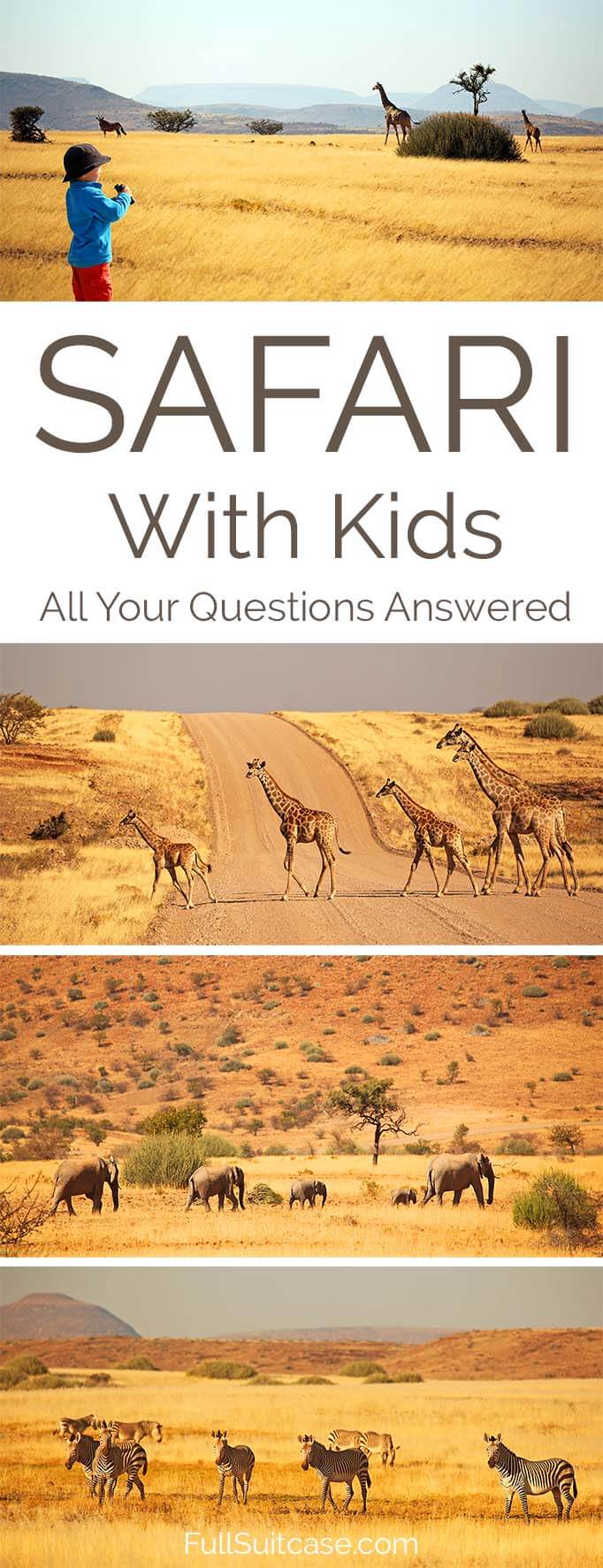
This site uses Akismet to reduce spam. Learn how your comment data is processed .
Thursday 9th of November 2023
Thank you Jurga for information concerning traveling with kids for a safari. But it would be great to travel in a destination whith diverse experiences clustered together to avoid long traveling hours and early waking up of kids. Kenya can be one of the those destinations.
Friday 10th of November 2023
Of course, Wilson, I'm sure that Kenya is amazing. We looked at it more than once but haven't gotten there yet. Maybe one day. There is just one main concern for families with younger kids - the risk of malaria and yellow fever vaccinations. For that, South Africa or Namibia are simpler, especially if traveling in certain seasons/areas where you have minimal malaria risk.
Tuesday 19th of November 2019
South Africa and Namibia are the best countries for families traveling to Africa. For Kenya or Tanzania safari trips, I think usually kids have to be at least 6 years old.
Wednesday 20th of November 2019
Agree with you on South Africa and Namibia - both wonderful choices for a family trip. I think that taking kids younger than 6 to malaria areas isn't the best idea anyway, so we never visited Kenya or Tanzania when ours were that young.
Thursday 4th of April 2019
Hi Jurga! Enjoyed reading your posts, definitely helpful information when travelling with kids. I know how difficult it can be sometimes to do so. I was wondering if you ever thought of packing meals for your kids while you're on a day safari adventure. I've come to realize how often and quickly kids can get hungry so packed meals are definitely helpful. I've looked into sustainable packed meal options because I'd like to be able to enjoy an eco-friendly travel and be sustainable at it. I think it's important to consider this kind of things because it'll helpful the location we're visiting in terms of preserving its beauty and the life there.
Hi Ana, yes, of course, we always pack some food when traveling with kids - on safari or not. It's not like you can just go to the restaurant when you get hungry in the middle of safari, so it's essential to take a picnic lunch. As for sustainable packing solutions, most hotels will pack a lunch for you and it's usually just some paper bags - not much waste at all. If you travel with an organized safari day trip they will usually foresee meals for everyone and those are packed in reusable containers. Africa never struck me as a place where people pollute too much - unfortunately, that can't be said about the packaging of meals in the US or most countries in Asia.
Susana Portocarrero
Thursday 27th of December 2018
Hi Im planning to come in July or August with my nephew will be 12 next year, I dont know what park is the best with more animals to see, we both are animals lovers and my dree is to see a Giraffe in its habitat we are coming all the way from mexico, so I have to see if those months are ok, what park because of the miration of the animals etc... Please help
Saturday 5th of January 2019
Hi Susana, yes, July and August are perfect months for safari in Africa. As for where to go, there are SO MANY options. Do you want a self-drive trip, then I'd suggest South Africa. Kruger NP is great, but there are also several private game reserves, as well as Ado Elephant National Park. Namibia is also wonderful and it's quite doable to drive to Etosha NP on your own. Otherwise, if you are taking a tour, your options are pretty much unlimited. Some of the most popular places for safari are Kenya and Tanzania, but both these countries have malaria risk and require yellow fever vaccination. That's why we personally opted for Namibia and South Africa when traveling with our kids. As for giraffes, they are very common in Africa, so I think it's safe to say that you'll see them no matter which country or which park you'll choose. I'm sorry but I can't really help more. You should first decide which country you want to visit and how (self drive trip vs a tour) and then you can start looking closer at what options you have.
Saturday 1st of September 2018
Hi Jurga. What a really fantastic post! So comprehensive and spot on. I'm South African and married to a Namibian with 3 kids incl twin boys! We haven't been been on a proper safari yet with all 3 yet but will def go soon. We went with my daughter but not since the boys were born. Love Etosha and Kruger! I've just started a family travel blog.
Monday 3rd of September 2018
Hi Julie, thanks a lot for your kind words. It's nice to e-meet you and good luck with your new blog! Another African safari is also my dream trip, I love African trips. There is something so special about that beautiful continent that you call home..

An African Safari With Kids: All You Need to Know 2023 Guide
It’s no secret that one of the best holidays with kids we’ve ever had was taking an African safari with kids . We absolutely rave about it whenever anyone asks us about our family-friendly South Africa safari holidays .
Something we didn’t initially pick up on, however, is that people weren’t just asking how our safari holiday was. What they really wanted to know, amongst other things, was ‘ Is it safe to take young kids on safari? ‘.
Before we dive into the ins and outs of taking kids on safari in Africa, you might like to read about the best safaris in Africa for some inspiration.
This post contains affiliate links. If you book something using one, we may earn a small commission but this is at no extra cost to you and just helps with the running costs of this website.

Our two-year-old on safari in South Africa
Here’s what you need to know about taking an African safari with kids
It seems that people like the idea of an African safari with kids, but aren’t sure whether it’s possible.
We’re by no means safari experts but before we had kids we visited some of the top national parks in Africa on a 3-month overland trip through Africa.
We love the whole safari experience and so on a family holiday to South Africa, we decided to take our then 2 and 4-year-old boys on safari. We’ve never looked back.
If you’re keen on the idea of a family safari holiday but aren’t yet 100% sure, our FAQs will help answer the most common questions we get asked.
You can also ask experts, Go2Africa , an award-winning travel company who curate amazing African safari packages for families.
Can you take young kids on safari?
The short answer is yes. We took our kids on safari in South Africa when they were 2 and 4 years old and we all had an unforgettable time. Safari holidays are one of the best holidays for families with young children and here’s why:
- Going on safari with kids is easily one of the most educationally rewarding and fun experiences we’ve had.
- Seeing African animals on safari up close in their natural habitat is such a thrilling experience.
- Watching an African sunset and going to sleep to the sound of a lion roar is like no other family camping experience you’ve ever had.
- Helping kids gain a better understanding of animal conservation by seeing these beautiful animals on safari is so important.
Whilst we’re on the subject of animal conservation, we love the getting kids involved in educational experiences while travelling.
Learning through travel is one of the biggest and most important benefits of family travel. If you are also interested in your kids learning through travel, you should take a look at Field Trip by Black Tomato.
They offer some amazing and truly unique family travel experiences like joining the Kenya Wildlife Service in their mission to conserve the Black Rhino, one of the most endangered species on the planet.
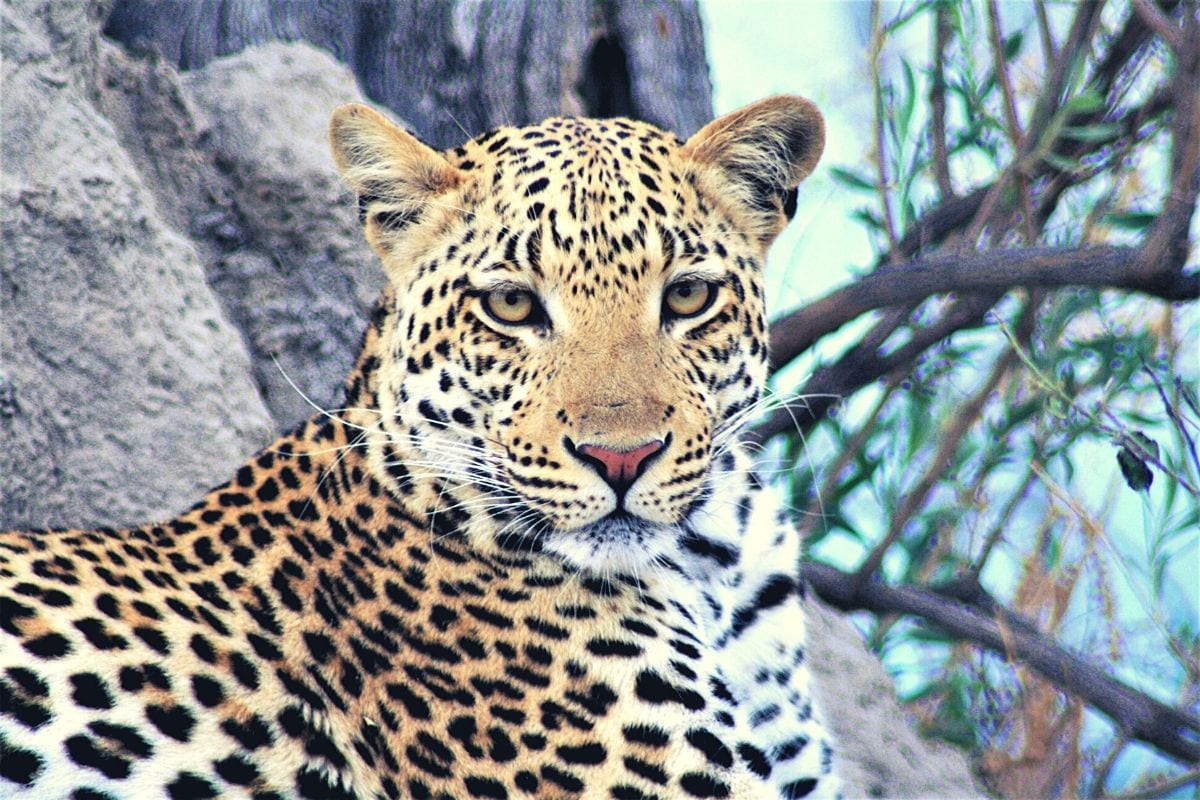
Spotting the elusive leopard on safari
When choosing a safari, just check that the lodge you like the look of caters for young children. We’re not just talking about family-friendly accommodation.
If they don’t allow children on game drives and don’t have babysitting services, then you won’t be going on a game drive yourself.
Look for lodges that are family-friendly with a kid’s club, child-friendly game drives and/or babysitting.
We’ve pulled together a list of the most family-friendly Kruger National Park accommodation that have these facilities.
You might also like to take a look at the family accommodation in Timbavati or read our experience of Thornybush Game Lodge .
How old do kids need to be to go on Safari?
There’s no official age limit for taking kids on safari so you will ultimately need to make the call as you know your children best.
Some places don’t allow kids under a certain age either for safety reasons or because they’re considering their other, child-free guests but there are plenty of options that cater for kids of all ages.
We found that from 2 years old was an excellent time to go because they have an understanding of which animal is which by this age and if not, they will definitely learn on safari!
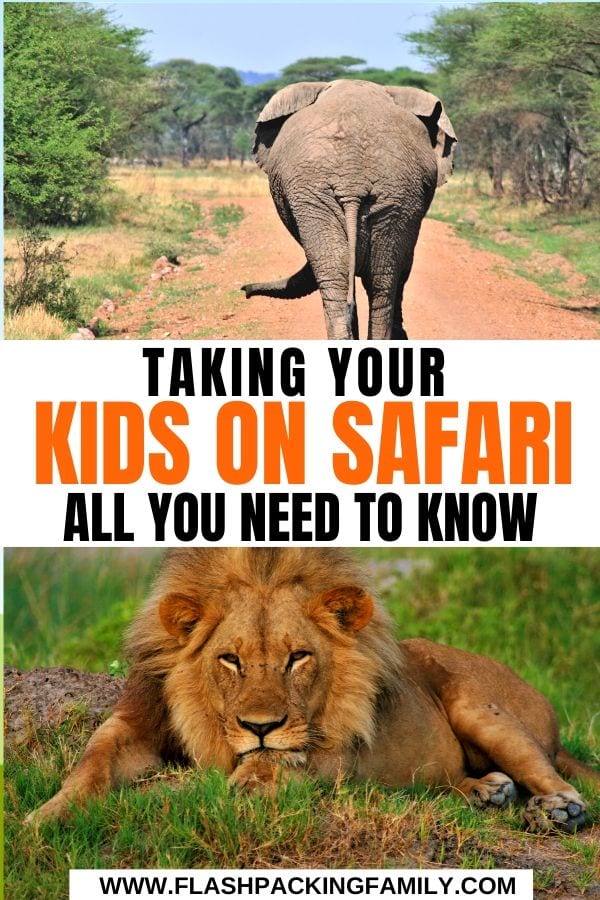
Where are the best places for safari in Africa with kids?
Before we had kids, we travelled for 3 months through Africa and went on every type of safari you can imagine.
We covered self-drive cheap safaris in the Kruger National Park in South Africa (see here for the best time to visit the Kruger ) and Etosha National Park in Namibia (see best time of year to go on safari in Etosha ).
We took mid-range guided safaris in Tanzania and Kenya and a luxury safari holiday in the Okavango Delta in Botswana.
In our opinion, the best African countries to visit for a safari with young children are South Africa and Namibia for a few reasons.
- they offer great wildlife viewing in national parks where you can self-drive. Self-drive safaris are easier as you can do them at your own pace. You’re missing the knowledge of a local guide, but you can set challenges to get the kids spotting their own wildlife and have a wildlife spotting book to hand.
- they are mostly malaria free which means you don’t need to to take malarial medication. Always check the guidelines before you go as malarial zones can change.
- they are the most western countries in Africa which makes communication easy. You’ll also find familiar foods in their stores, including the all-important snacks for the kids. They’re among the safest countries in Africa too, although you should continue to remain vigilant as with travelling in any foreign country.
See here for our epic 2-week Namibian self-drive itinerary which includes visiting Etosha National Park.
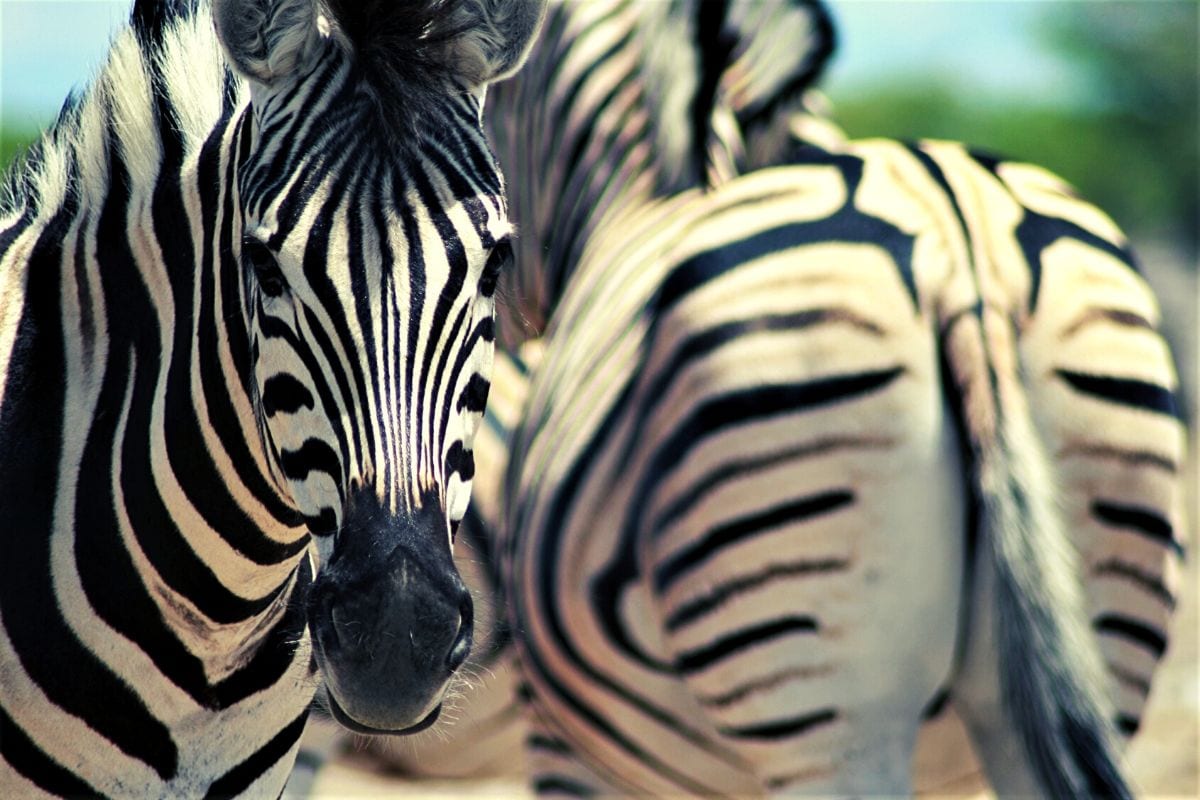
Spotting zebra on safari
Is it safe to take an African safari with kids?
The main question we get is about safety. Is it safe to take young children on safari in Africa? Before we had kids we had heard that kids needed to be 12 and over to go on safari.
We thought this was because it would be annoying for guests to have loud kids in camp and also on vehicles scaring animals away. In fact, we found out that children under 12 are the perfect size prey for the big cats.
Don’t let this put you off. Many family-friendly lodges offer game drives tailor-made for families with small children in enclosed vehicles.
If you are doing a self-drive safari, make sure you read the rules very carefully. Don’t open windows to take pictures. Don’t stop for a toilet break anywhere other than a designated (safe) toilet area. It’s about being sensible.
If you still aren’t convinced that it will be safe for young children, you can always opt to stay on a game reserve that doesn’t have the Big 5.
We actually love any type of safari. We really enjoyed hunting for the Little 5 on a living desert tour in Swakopmund in the Namibian desert.
You can stay in tents and have the safari experience but feel comfortable that there are no predators. It’s still just as thrilling seeing elephants and buffalo up close.
Some places also have wildlife viewing from the safety of camp so you don’t even need to go on a game drive. Watering holes are the ideal place to spot wildlife.
One of the other considerations for taking kids on safari is the risk of malaria. As mentioned above, we recommend South Africa for family safaris because of the large number of non-malaria areas in South Africa for a family safari .
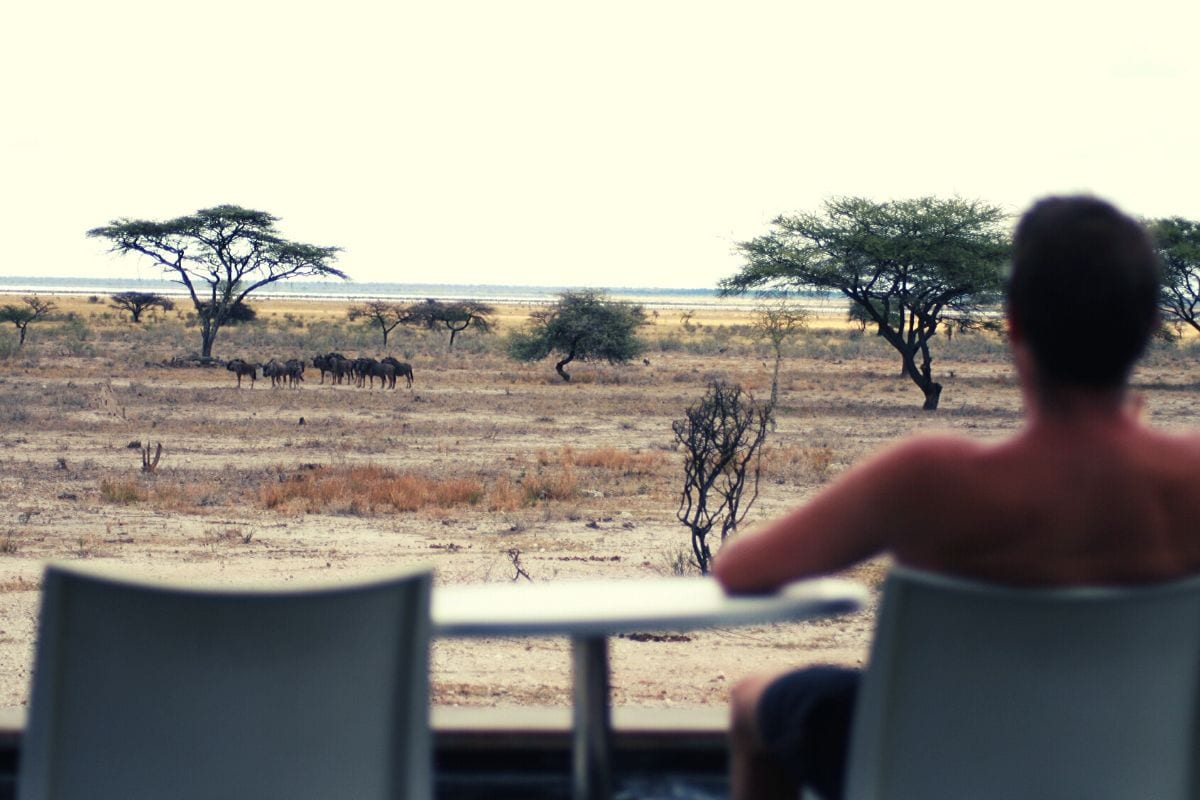
Spotting wildlife from our accommodation at Onguma Fort in Etosha National Park
Is a safari with kids expensive?
Going on safari can be expensive, like a high-end, all-inclusive, once in a lifetime safari honeymoon. These safari holiday packages include a super luxury resort with all food and game drives included and are pretty pricey.
Don’t get me wrong. If money is no object, they are out of this world and completely worth the splurge. Look at Go2Africa for amazing African safari packages.
If you’re on a budget, however, you can still have amazing cheap safari holidays in places like the Kruger National Park and Addo Elephant National Park in South Africa or Etosha National Park in Namibia.
We’ve done budget safaris in Addo, the Kruger and Etosha by self-driving and staying in campgrounds. It’s the best way to keep the cost down.
You just pay the Kruger National Park park entrance fee (or Etosha or Addo) and a small amount to camp overnight. This is very easy to organise yourself without the need for a third party tour company.
If you don’t want to do a self-drive safari, you can try to keep the costs down by booking direct with local agents.
In Tanzania we had a local guide drive us through the Serengeti, Ngorogoro Crater and Lake Manyara and we stayed in mid-range accommodation.
We have also done luxury African safaris and while it’s nice to have the added extras, the wildlife viewing is no less spectacular on a cheap African safari.
If you do want a luxury family holiday, we highly recommend specialised safari consultants that we have used before: Go2Africa organise the most amazing African safari package holidays.
How long is the ideal safari for kids?
We love going on safari but even we draw the line at more than 5 consecutive days on safari with small kids. We like to make the safari a feature of our holiday, not the sole focus of it.
If you don’t want to do a week of daily safaris, you can find safari and beach package holidays where you spend part of the holiday on safari and the rest at a beautiful African beach resort.
In terms of the safari drives, the younger the children are, the shorter the game drives should be. For children under 7, we would recommend about 2 – 3 hours.
Most safaris are taken in the early morning or late afternoon as these are the best viewing times. Animals tend to escape the heat of the midday sun and spotting them will become difficult.
Between these times you might want to make the most of the pool (if you have one) or have a family siesta.
If you’re doing a self-drive safari, you have complete control over how long your safari drive is which is another reason we love self-drive safaris with young children.
What to pack for a safari
We’ve written a post on what to take on safari but in summary, your safari packing list should include :
- Take layers. Early morning or early evening game drives can get chilly.
- Take sunscreen, hat and sunglasses and mosquito spray, especially if you’re in an open vehicle.
- Take binoculars to help you spot animals. The kids love them and they’re better than any toy. They don’t need to be specifically kid’s binoculars. You’ll be amazed how much more focused they will be on the safari. No pun intended!
- Take snacks and water.
- Take your camera with a decent zoom lens. We have a beginners Canon 250D DSLR with a Tamron 70-300mm lens .
- Take a wildlife-spotting book if you’re doing a self-drive safari.
- Take a headtorch in case your safari camp doesn’t have electricity at night.
- Sturdy shoes in case you do a walking safari. Trainers should be fine, but we would not recommend flip flops.

Binoculars are popular with kids on safari
What to wear on Safari?
When you think of safaris, you might conjure up images of people dressed in khaki clothes. This would be the stereotypical safari outfits of years gone by.
That’s not to say that people don’t still wear that sort of African safari clothing, but these days you can wear pretty much what you want, as long as it’s not too bright.
And depending on which country you are visiting, you may want to avoid dark colours (blue and black) as they can attract Tsetse Fly.
Aim for neutral colours. If you’re doing a self-drive safari, it won’t matter what safari clothes you choose to wear.
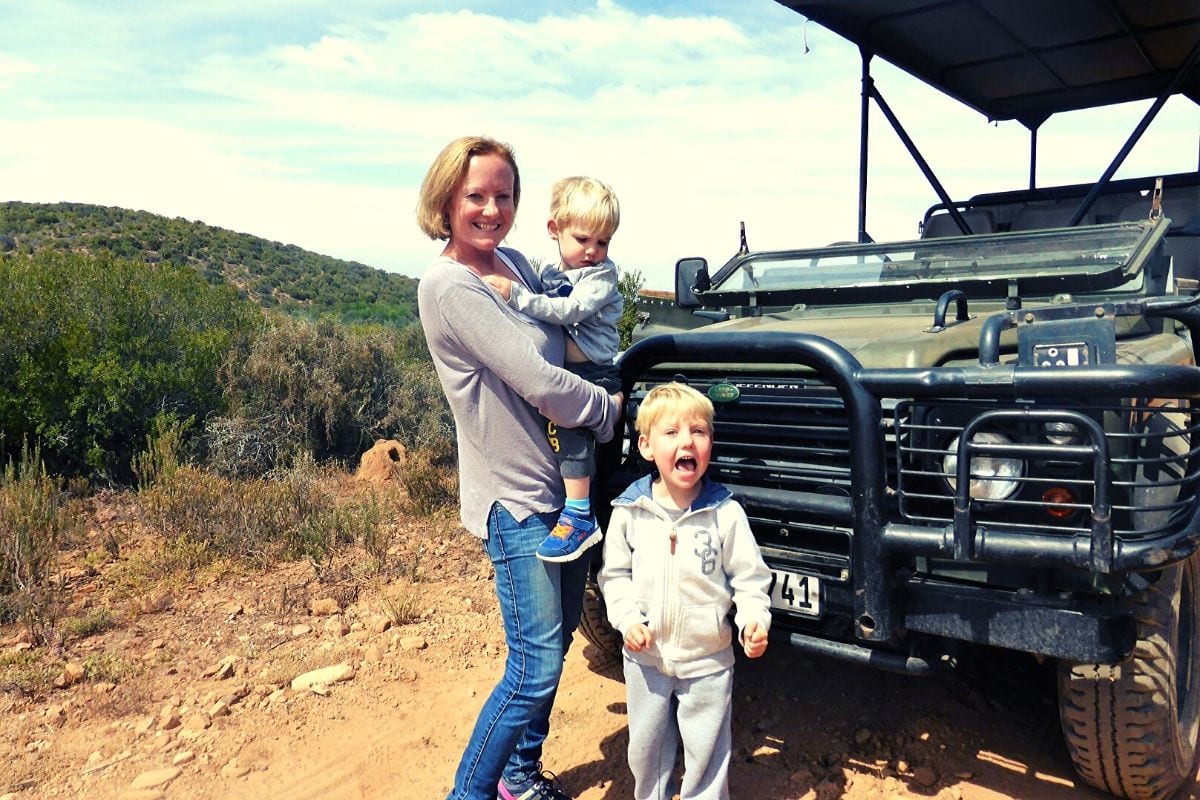
Neutral coloured safari clothing
Can we see animals without doing a safari drive?
If the idea of driving around for hours spotting wildlife with small kids does not appeal to you, there are other options. We have stayed in places where you can watch wildlife from your accommodation.
In this case, you can treat the accommodation just as a base to explore other things in the area with the added bonus of seeing wildlife.
We have stayed at the incredible and very family-friendly Onguma Bush Camp just next to Etosha National Park in Namibia. You can watch animals from the pool area or while enjoying a meal at their restaurant.
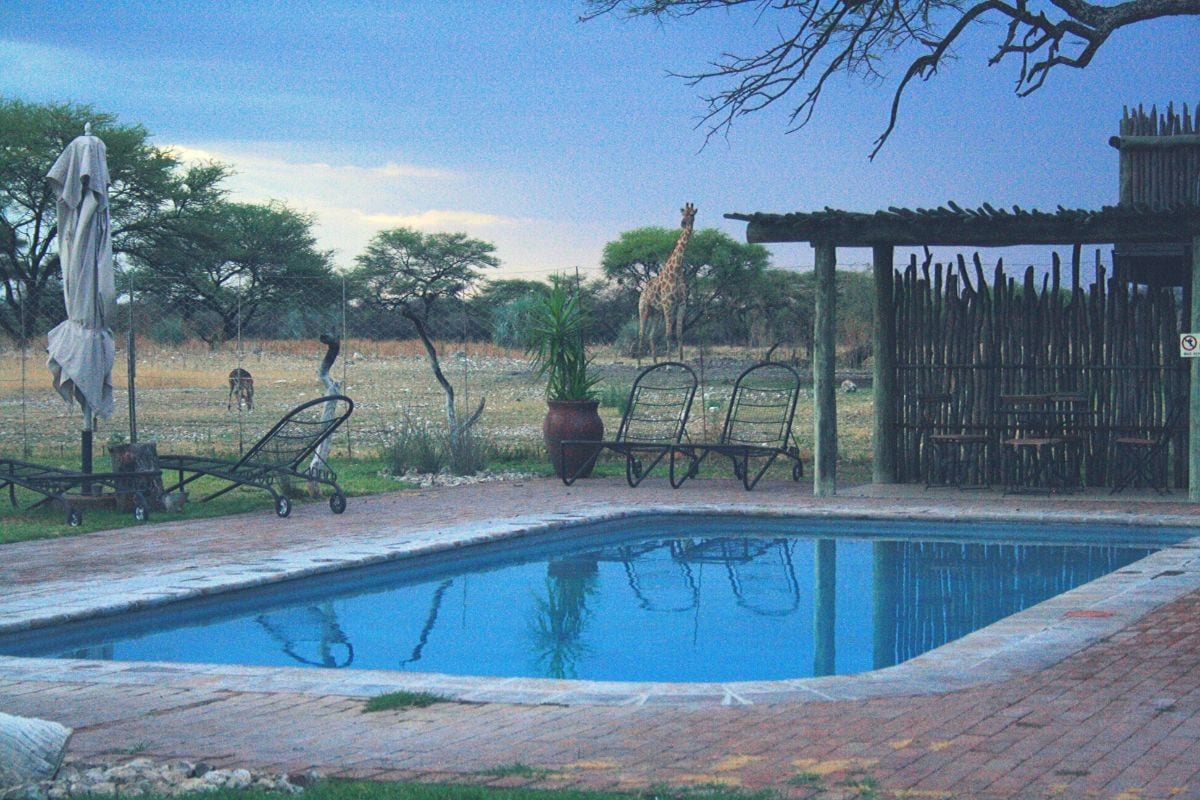
Onguma Bush Camp in Etosha
We’ve also stayed at Okaukuejo Camp where we watched endangered black rhino come at dusk to the illuminated waterhole. It was an incredible experience.
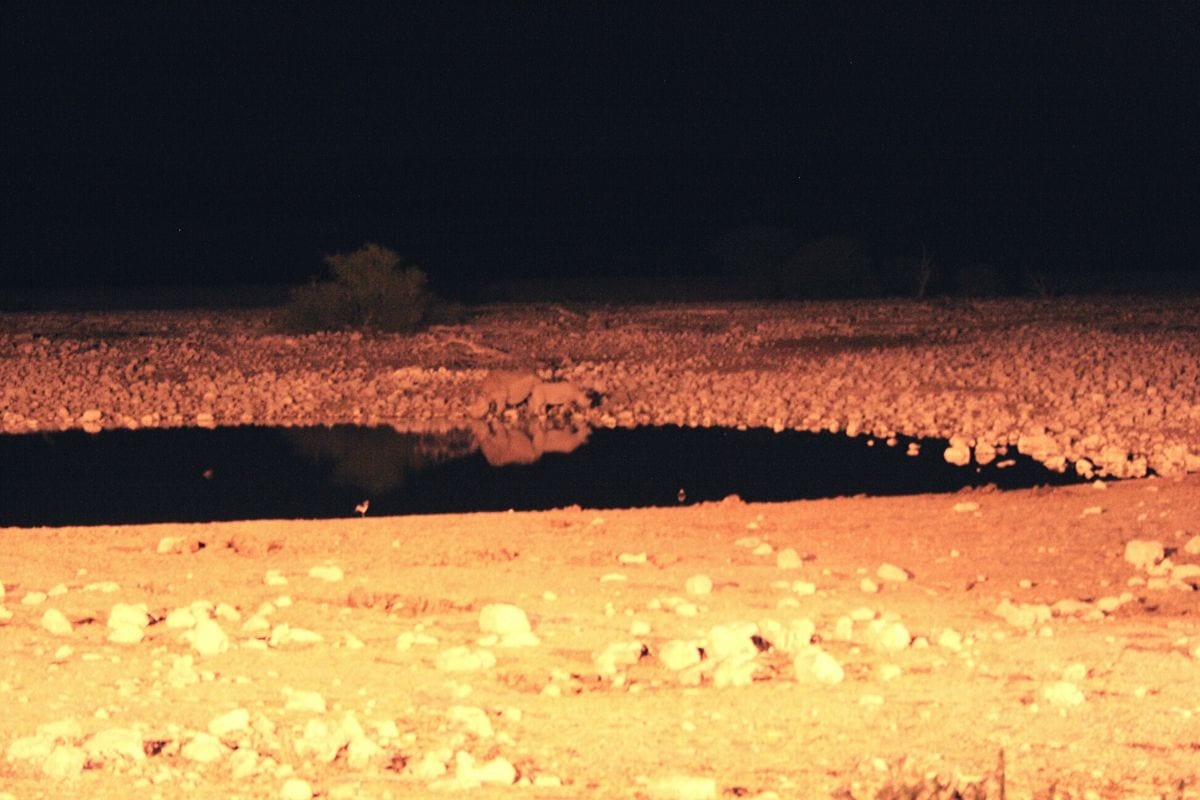
Mother and baby black rhino at the Okaukuejo Camp waterhole
If you can’t make it to Africa just yet, why not start with one of the UK safari parks? Try searching for ‘safari parks near me’. We were surprised at how many animal safari parks there were in the UK.
Whilst it’s not the same as spending your holidays in Africa, it will give you a taster and might also give you an idea as to whether your kids might be interested in a safari or not.
Any other questions?
We’d love to hear if you have any other questions about taking kids on safari. Leave a comment and we’ll get back to you.
We also have more information on visiting South Africa with kids , including fun things to do with kids in Cape Town . Or check out our South Africa section on the blog.
If you found this post useful, why not bookmark it, share it with friends or pin it?
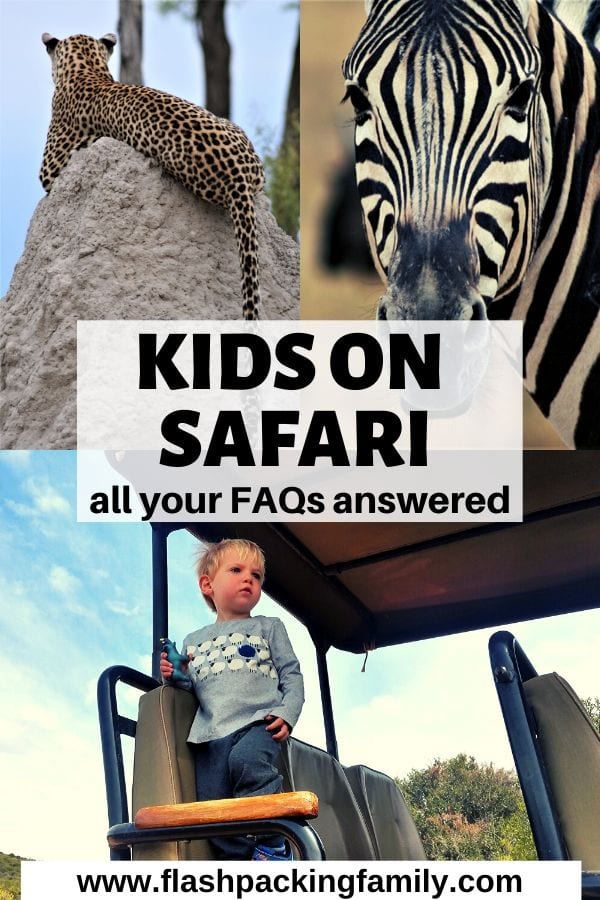
I am thinking about taking my kids too!
That’s great news! It’s an amazing experience for them!
I enjoyed this post.I read your blog site fairly frequently, and you aree always bring out some terrific material. I shared this on my Facebook page, and a lot of my followers liked it. Keep up tthe great work
Thanks so much for your comment. This is lovely to hear.
Hello. Thank you…Great article
Thanks so much. I’m glad you enjoyed it.
That’s a wonderful! thank you for sharing such a great information!
Fact: More people get bitten by spiders and snakes in their homes than while on safaris. … Yes, Africa does have dangerous animals but most fatalities have been caused by people disobeying the park rules by getting out their vehicles and harassing the animals.
This is very true
Leave a Reply
Leave a reply cancel reply.
Your email address will not be published. Required fields are marked *
We participate in various affiliate marketing programs. Flashpacking Family is a participant in the Amazon Services LLC Associates Program, an affiliate advertising program designed to provide a means for sites to earn advertising fees by advertising and linking to Amazon.com. As an Amazon Associate, we earn from qualifying purchases.
Most popular posts
Guide to visiting Lake Louise, Canada
Jordan itinerary
Sri Lanka’s best beaches
Things to do in Suffolk with kids
Free things to do in London for kids

You are using an outdated browser. Please upgrade your browser to improve your experience
- Book with confidence
Tales from the Coral Tree
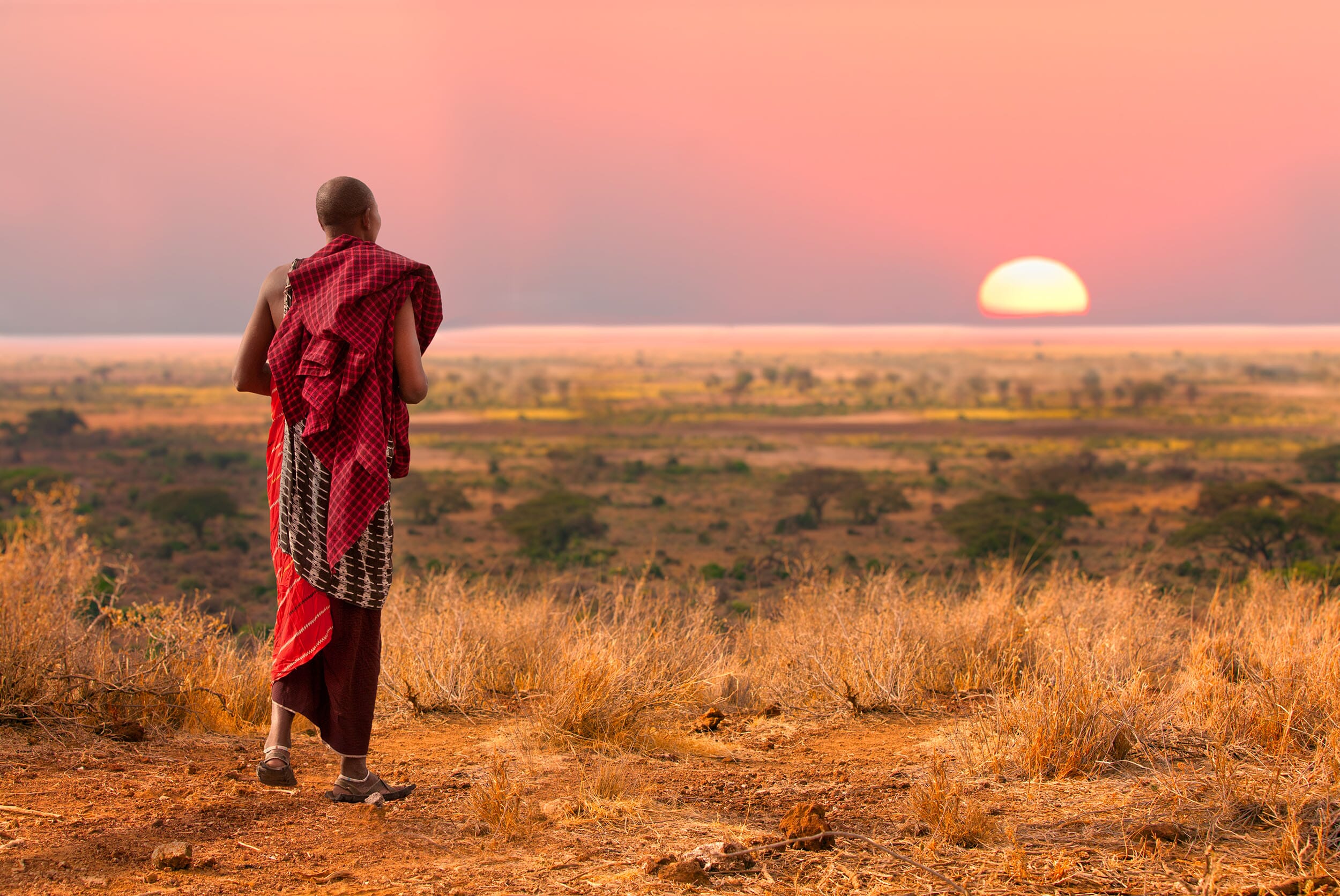
Destinations
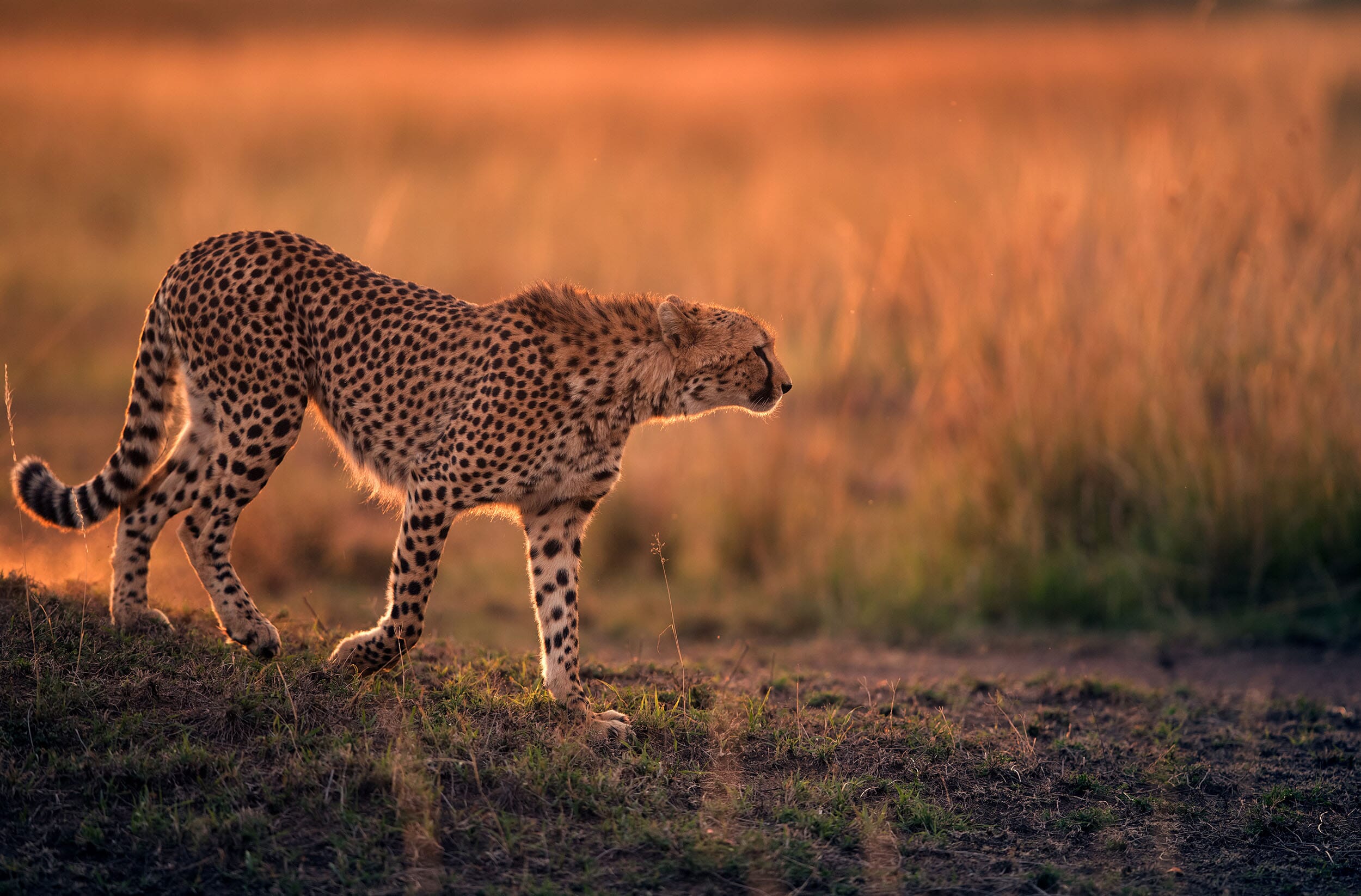
Itineraries
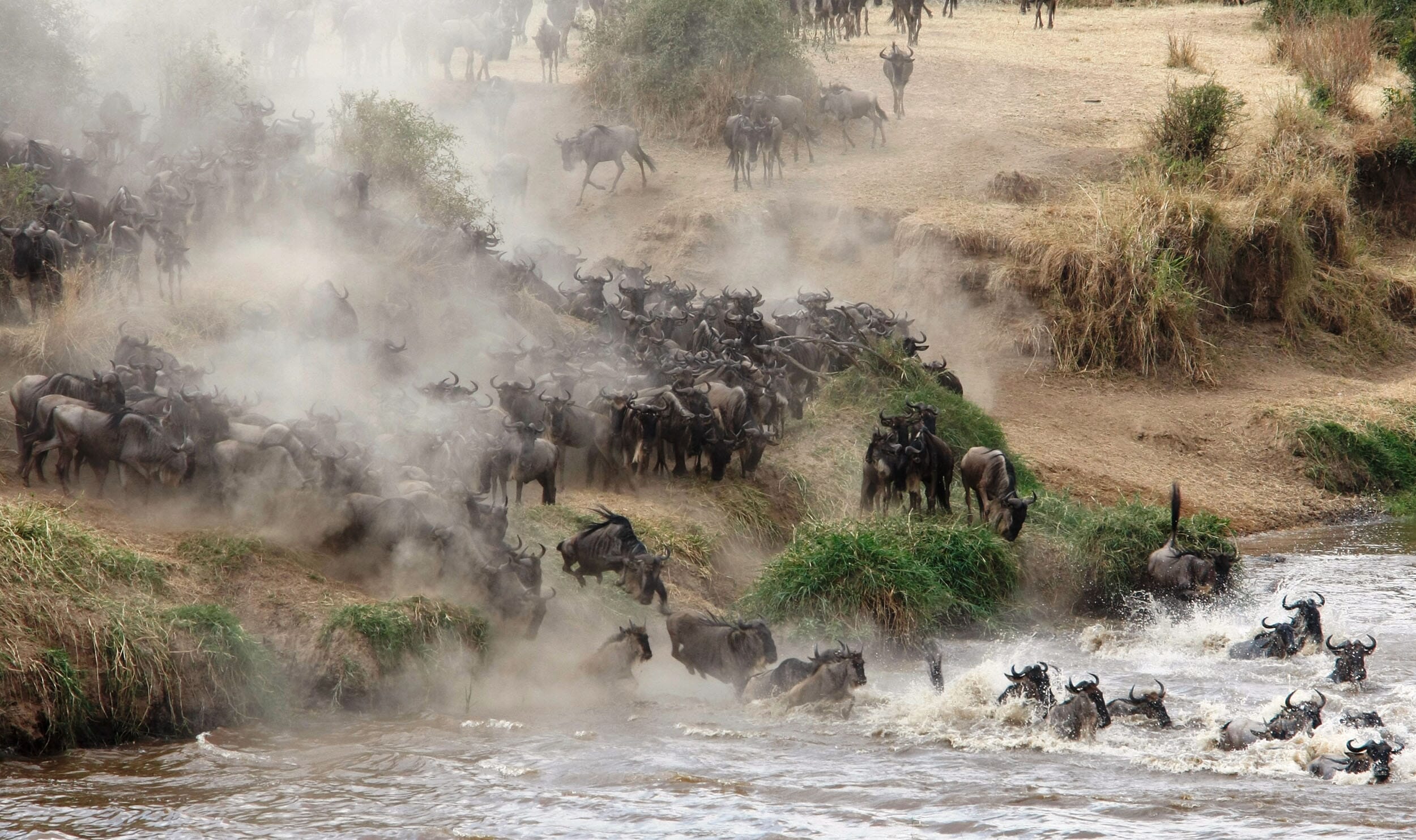
Experiences

First safari?
South africa, indian ocean.
- Conservation
- African safari packages
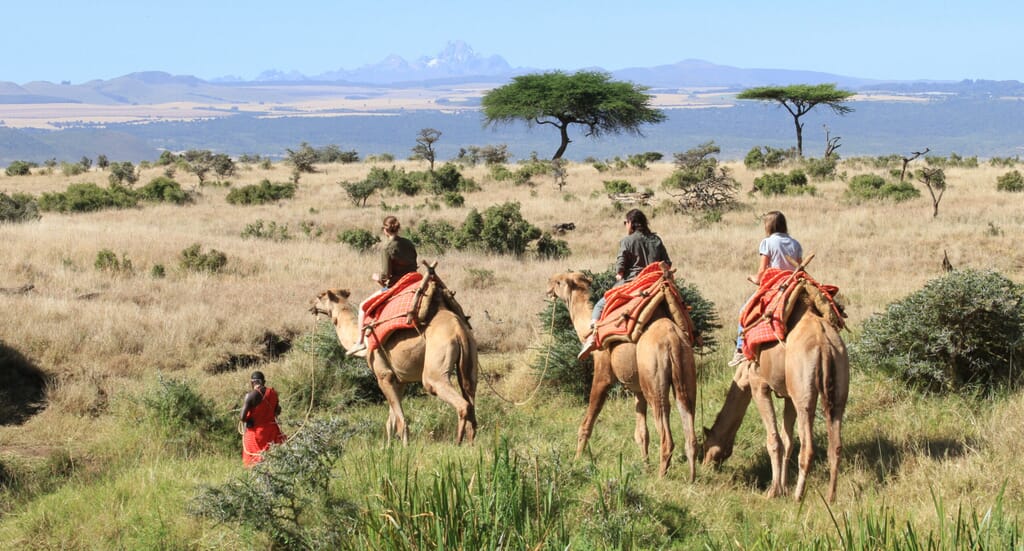
Safari with Teenagers: Our Guide for Family Safari with Teens
Get the teens engaged and excited with a life-changing family safari.

Our beginner’s guide to African safari holidays with teenagers
Teenagers can be notoriously tough to please, but it’s no exaggeration to say that African safari holidays with teenagers are likely to be the most rewarding and memorable adventure you ever have.
Sensational wildlife, adrenaline-releasing adventures, and connecting with far-removed places and cultures, all combine to make a luxury family safari holiday unlike anything else they are likely to have experienced.
Grumpy teenagers may balk at the idea of getting up before first light to head out on game drives, but we guarantee they, and you, will be talking about your African safari holiday for years to come.
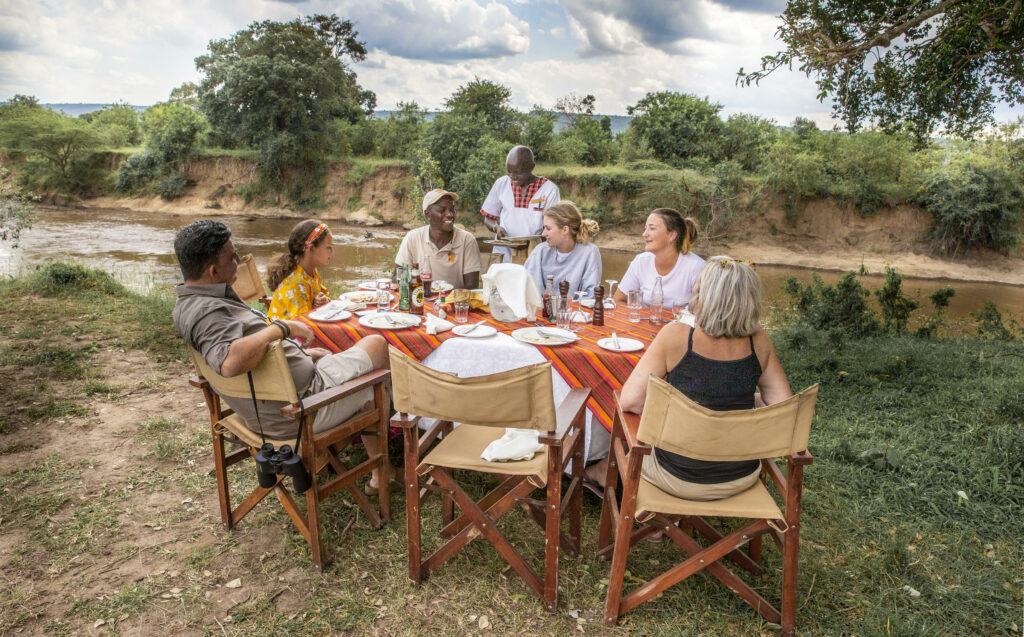
Where to go on African safari holidays with teenagers?
In general, the best family safari destinations with teenagers are Kenya, South Africa and Tanzania, purely for the accessibility and diversity of experiences they offer:
Kenya family safari holidays are ideal for teenagers who adore wildlife and conservation. The country has achieved some wonderful successes over recent decades, particularly in the field of rhino preservation.
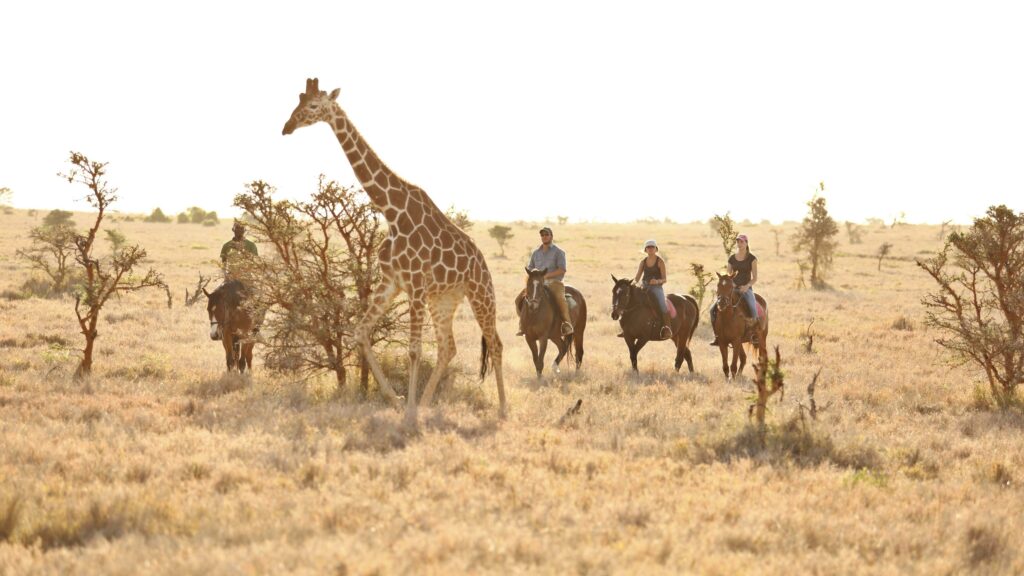
Kenya also has a fantastic array of unique experiences that can’t be found elsewhere. Horse riding through the bush, helicopter flips over vast landscapes, hot-air balloon rides above the savannah, or sharing breakfast with giraffes. All these and much more can be found in Kenya.
South Africa safari holidays for families have it all. From the vibrant cityscape of Cape Town , to the best leopard viewing on the planet in Sabi Sands .
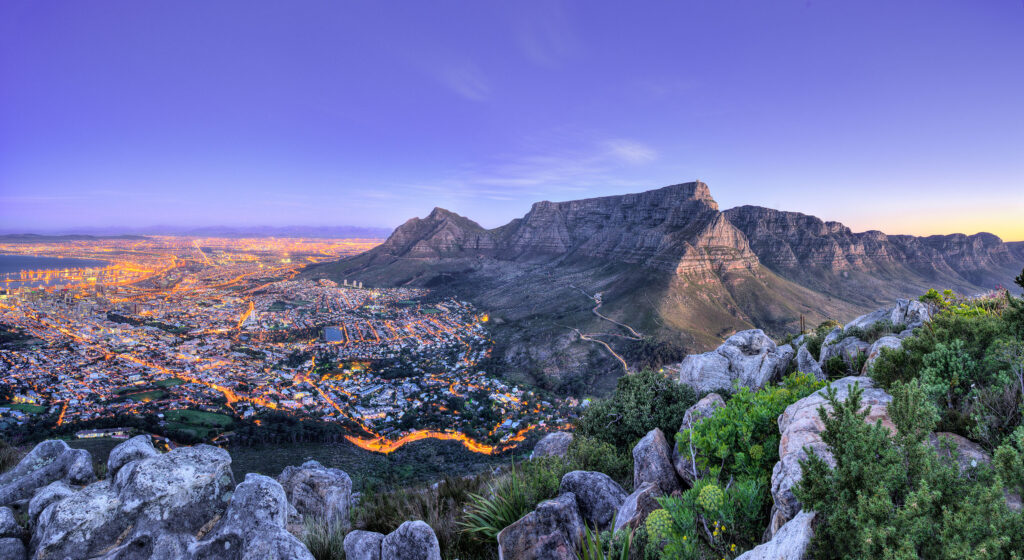
The sheer variety of adventurous outdoor activities means that South Africa is perfect for a first taste of Africa. We doubt it will be the last!
Tanzania luxury safaris are suited to teenagers who have a spirit of adventure. The best family safari in Tanzania will depend on your individual wishes, but with 19 nineteen national parks and arguably the most abundant wildlife on the continent, there is something for everyone!
A great way to make safaris with teenagers even more exciting is the promise of a relaxing beach escape after all those early mornings. The Zanzibar islands off the coast of mainland Tanzania offer gorgeous blue waters, more infinity pools than you can shake a stick at, and lots of amazing water activities to keep everyone entertained.
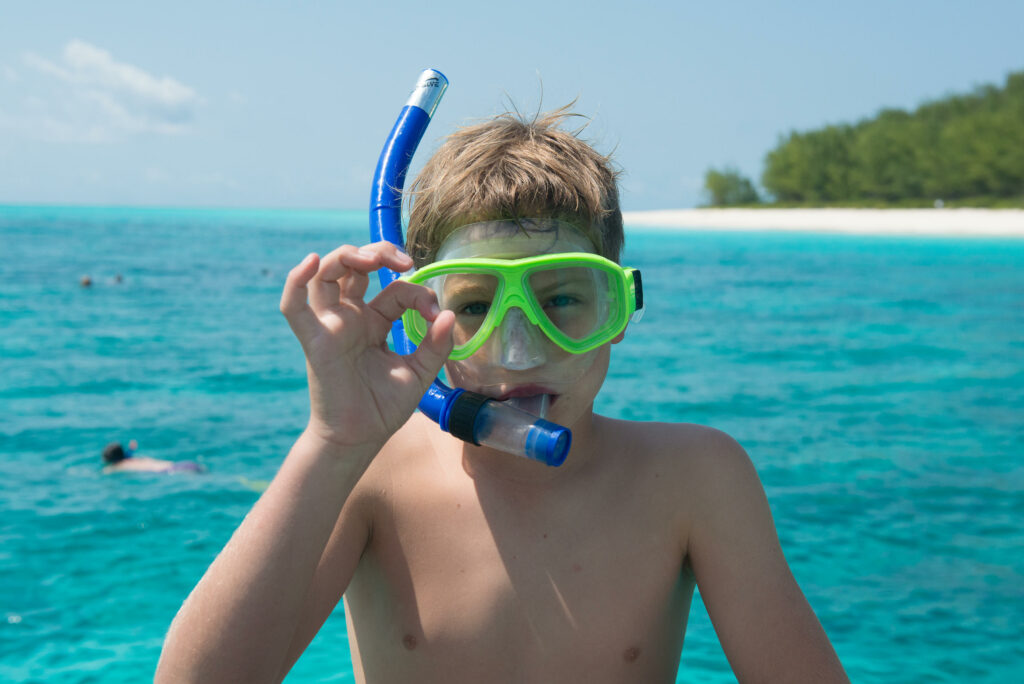
What activities can teens enjoy on an African safari?
The great benefit of African safaris with teenagers rather than very young children is that they are able to see and enjoy so much more of the wilderness. Active teens, adventurous teens, curious teens, conservation-minded teens; all will be captivated by an African safari holiday.
If it’s your first safari , you’ll no doubt be excited to enjoy traditional safari game drives in the African wilderness. These normally take place in the early morning or late afternoon, which leaves plenty of time to enjoy the many other fun activities on offer in certain locations.
Some of our favourite activities on African safari holidays with teenagers include:
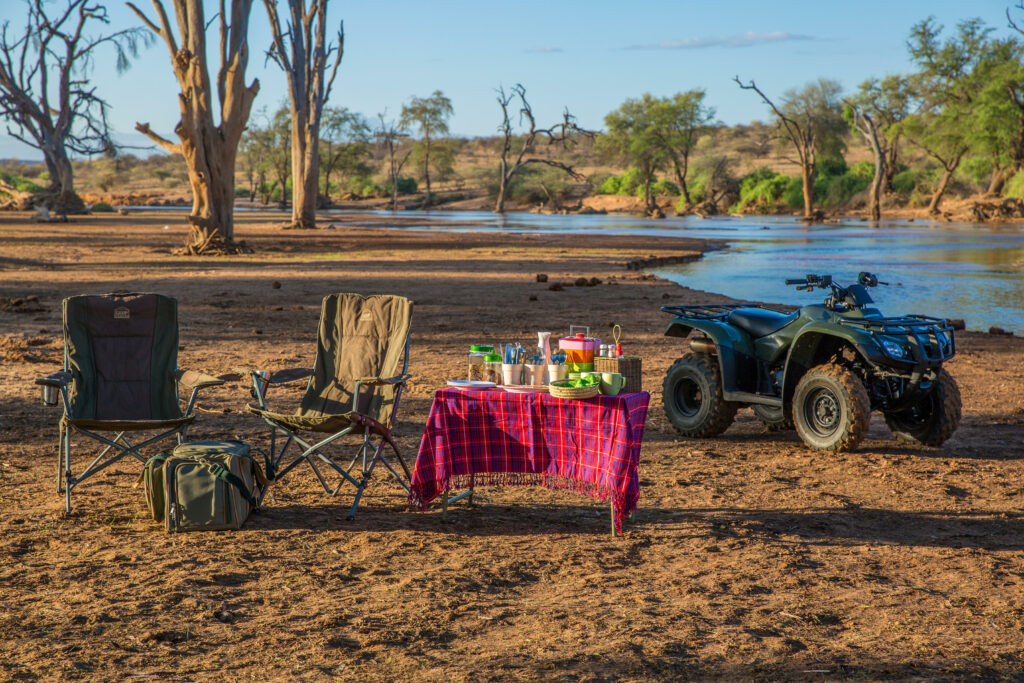
- Quad biking in the wilds of Samburu , Kenya at Sasaab ,
- Horse riding safaris from Lewa Wilderness in the Laikipia Plateau ,
- Boat safaris through the extensive waterways of Nyerere National Park . Keen anglers will also be able to enjoy a spot of fishing ,
- Hot air balloon safaris at dawn (they’ll thank you for the wake-up call afterwards!) over the plains of Serengeti National Park ,
- Tracking chimpanzees in the Mahale Mountains of remote Western Tanzania ,
- Gorilla trekking through Bwindi Impenetrable Forest (minimum age of 15 years)
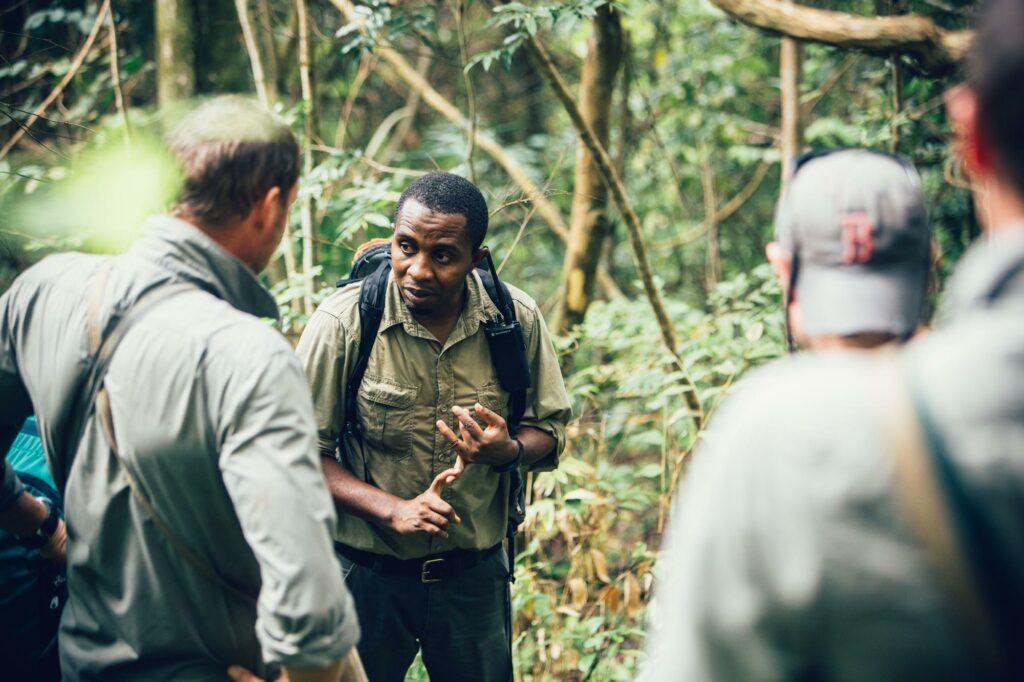
Beyond the safari
Outside of the safari element of your trip, teenagers will have bountiful actvities to enjoy in the cities and on the beaches of Africa.
The Indian Ocean islands of Seychelles , Mauritius and the Zanzibar archipelago are teeming with resident marine life. If your family are water babies, there’s no better way to explore the underwater world than with a guided snorkelling or SCUBA diving experience.
Cape Town and the Winelands of Franschoek and Stellenbosch are the foodie capitals of Africa. If your clan enjoy scintiliating taste-bud delights then be sure to include the Cape in your African family holiday.
If your teenagers love sharing their exploits on Instagram or TikTok, they’ll be sure to adore Giraffe Manor in Kenya – the home of the original giraffe selfie, and a leader in giraffe conservation.
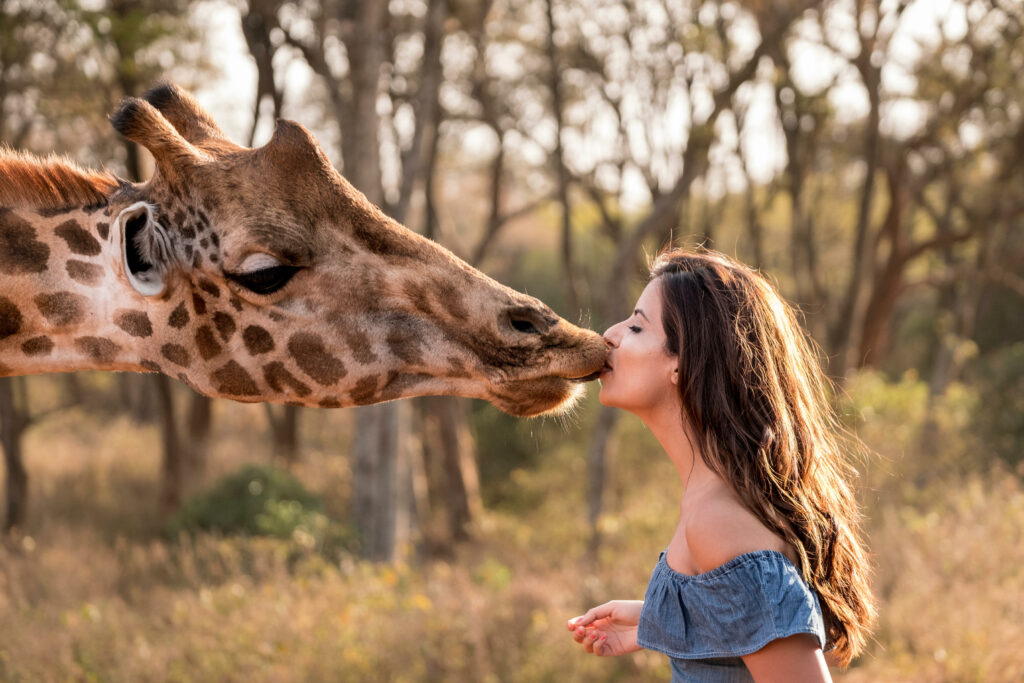
Incredible accommodation for an Africa Safari with Teenagers
Not only is Africa the perfect continent to travel to with teenagers, it also has the accommodation to match.
The choice is vast, with something for each taste and budget. Below, we list a few of our favourites:
Cottar’s 1920s Camp
The Cottar family have been delighting safari goers for over 100 years. The current generation have spent their lives living and working in Kenya’s Masai Mara, so it’s no surprise they know just what it takes to put together a sensational family safari.
Cottar’s 1920s Camp is located in a private conservancy bordering the Masai Mara National Reserve, which means you’re unlikely to see other vehicles and will have the freedom to enjoy the wilderness.
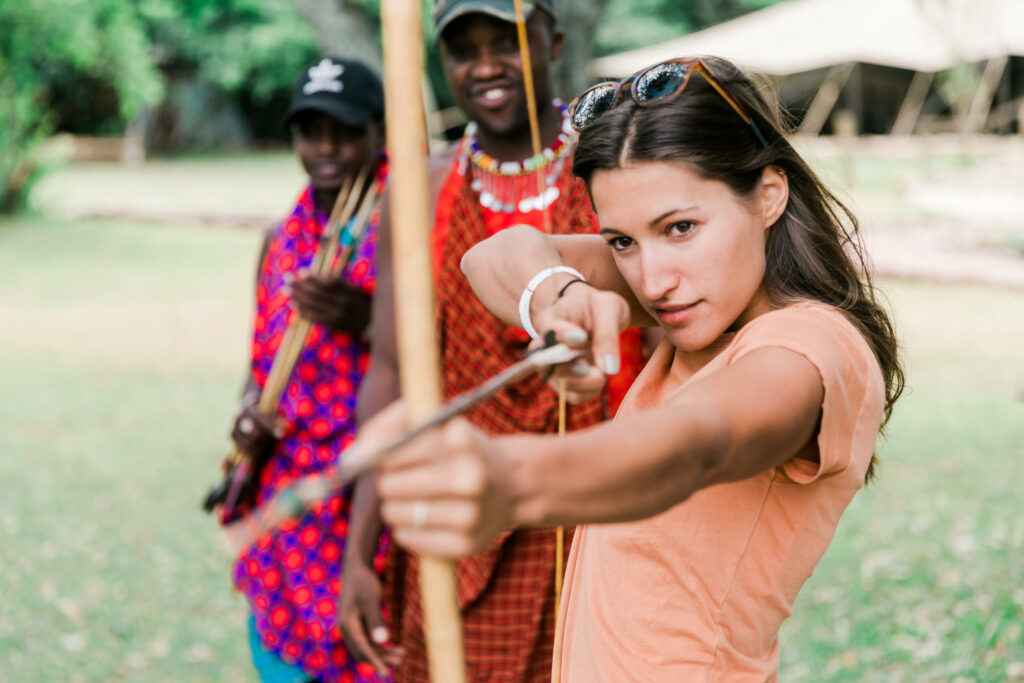
What sets Cottar’s apart from their competition is the breadth of activities on offer and the depth of involvement with the local community. In addition to the usual game drives and walking safaris, they have curated a list of 24 impact activities to be experienced from their property in the heart of the Mara ecosystem.
These include foraging with Letilet, their resident hunter gatherer, as well as pangolin talks, e-bike excursions, and time spent in the company of the only all-female ranger unit in the Masai Mara. Cottar’s is a firm family favourite. Click here to book your stay at Cottar’s 1920s Camp
Greystoke Mahale
Tucked away in the foothills of the Mahale Mountains on the shores of Lake Tanganyika, Greystoke Mahale is a true bucket list property. Accessible only by air, this remote property is one for those families looking to get off the beaten track and enjoy an authentic adventure.
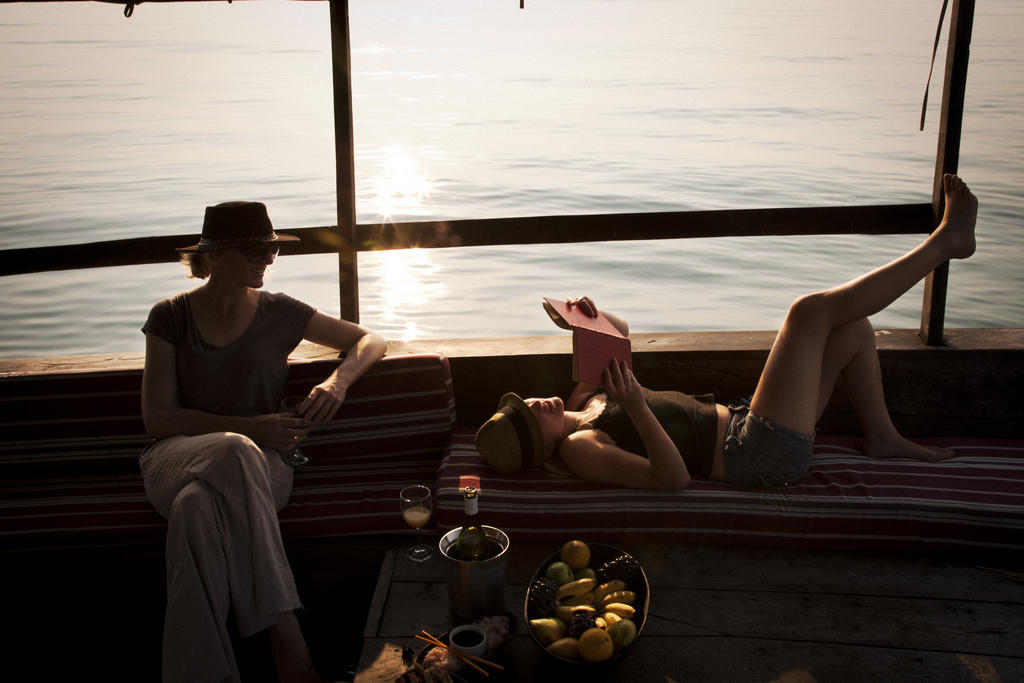
The main draw at Greystoke Mahale is tracking the habituated chimpanzees that live in the surrounding forested hills. Unlike Rwanda and Uganda the minimum age here is 12. This means teens of any age can enjoy the experience.
Aside from the chimps, families can enjoy exploring the lake by boat, kayak, or simply diving in for a cooling dip. Click here to book your stay at Greystoke Mahale
Baraza Resort & Spa
Located in the south east of Zanzibar on Bwejuu beach – once voted one of the most beautiful beaches in the world – Baraza Resort & Spa is amongst our favourite properties in Zanzibar for families with teenagers.
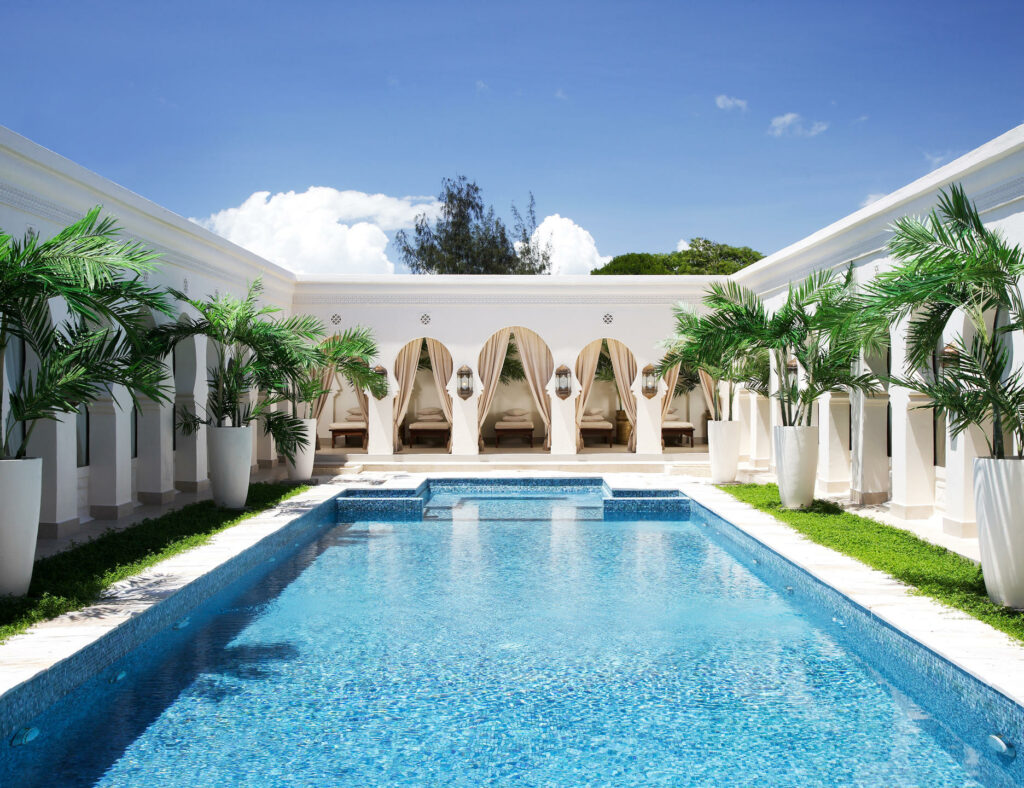
The 2-bedroom villas are spacious and the perfect base to relax after a safari. Activities in the local area are abundant; including kite-surfing, SCUBA diving, snorkeling, deep-sea fishing and a choice of non-motorised watersports.
If relaxing is the order of the day, lounging by the expansive pool can be hard to resist! Click here to book your stay at Baraza Resort & Spa.
Our top tips for African Safari holidays with teenagers
As family safari specialists , our primary goal is to make you and your family feel safe, informed and excited about your adventure to Africa.
We don’t do off-the-shelf packages or cookie-cutter itineraries. We get to know you and learn about your hopes and dreams before designing your own personalised itinerary.
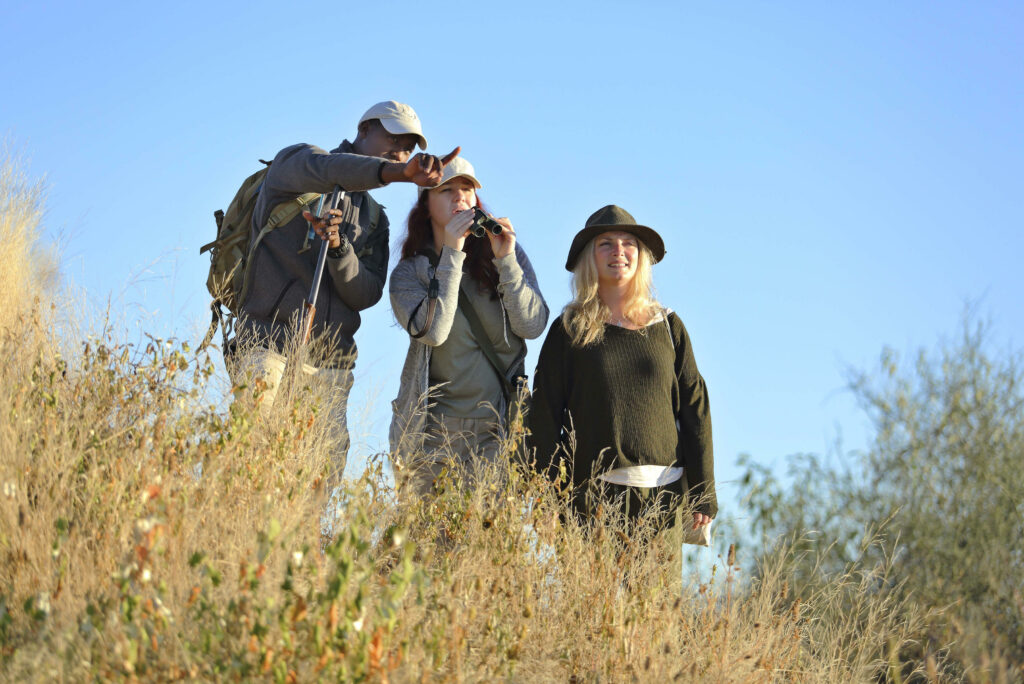
The things we’ll discuss with you when planning a safari with teenagers include:
Make sure you choose the right ones for your family. Whilst teenagers can do more on safari than young children, they can’t necessarily do everything. For example, some places only allow walking safaris for over 16s.
Taking the journey at your own pace
Your kids may not thank you for dragging them here, there and everywhere. Plan your safari at a pace that you and the family will all be comfortable with.
Choosing the right accommodation
Not all African safari holiday lodgings are created equal, and family suites aren’t always designed with teenagers in mind. We’ll make sure you have the right space and style of accommodation for your needs. Swimming pools can also be a big draw for those warm afternoons in the bush!
Dietary requirements
Is your teenager vegan? Are they an omnivore? Does anyone in the family have allergies? We’ll make sure at every point on your journey your needs are catered for.
Cultural and environmental interests
We believe safaris with teenagers can be just as much about education as they are about fun. In fact, the two go hand in hand!
Do your teenagers have any particular interests or current studies they’d like to incorporate in their holiday? If so, let us know. Learning about the wildlife and biology of the areas you’re visiting, as well as the fascinating history of the African continent, can be an enriching experience for young minds.
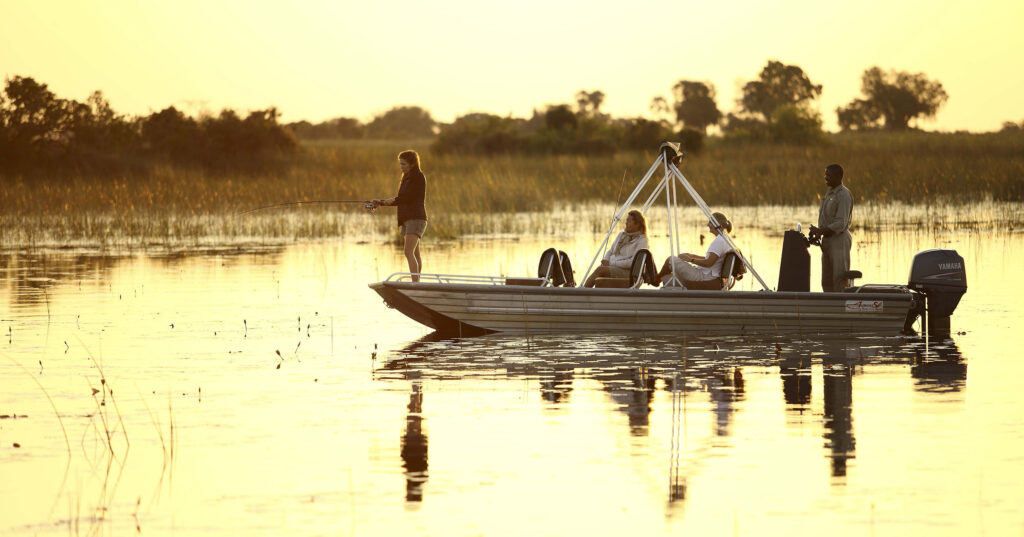
Some images used in this blog are the property of our partners . Please contact us for more details.
Author: Mike
Share this article.
- Blog categories

Talk to Mike & Tess about your family's next big adventure
Related destinations.
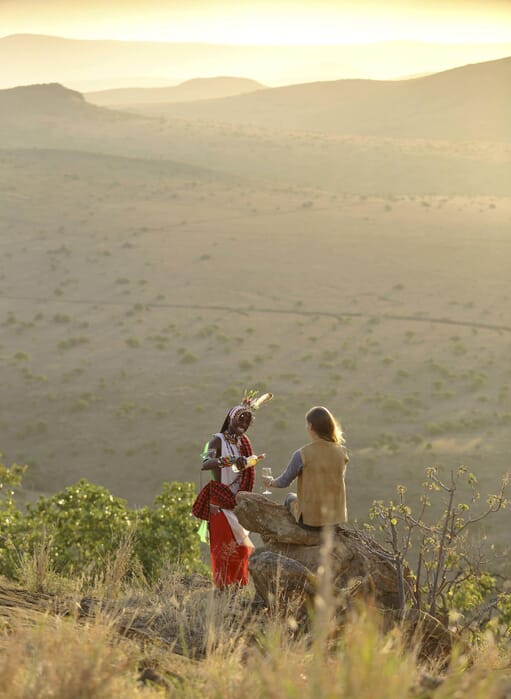
Our expert knowledge makes it possible.
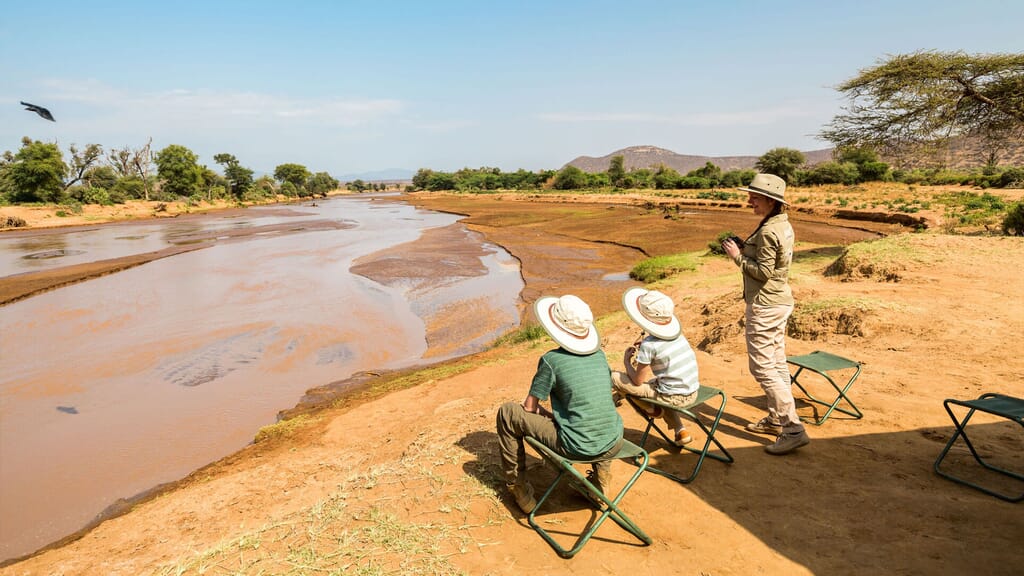
Category: Adventure
Are african safaris worth it 5 reasons to consider it.
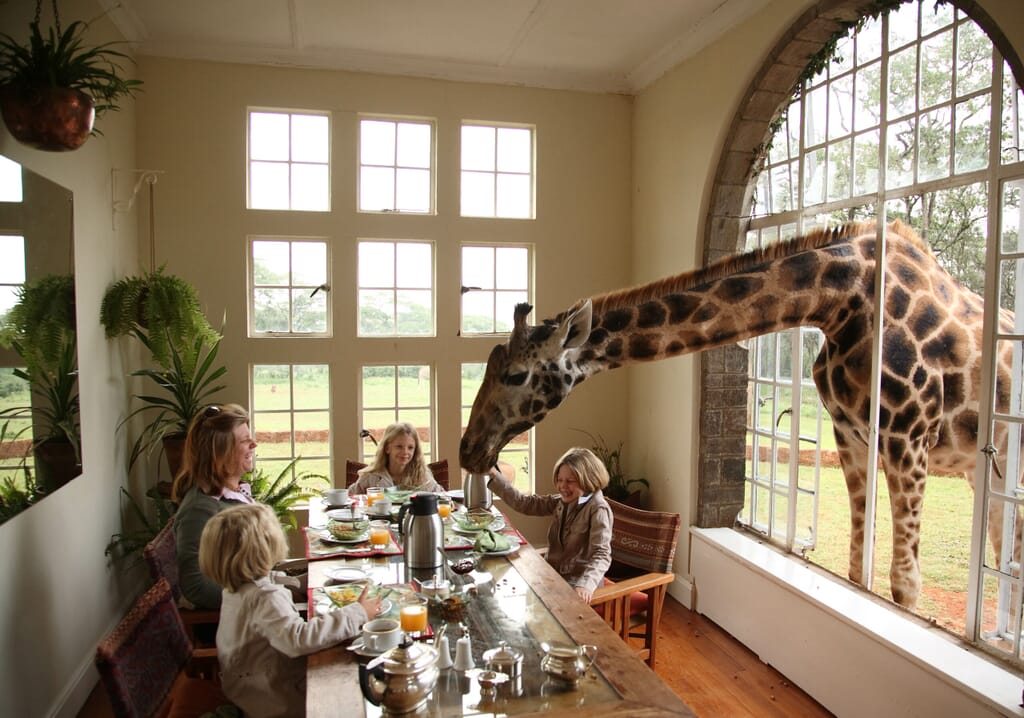
Best Family Safari Destinations: Our Top Three
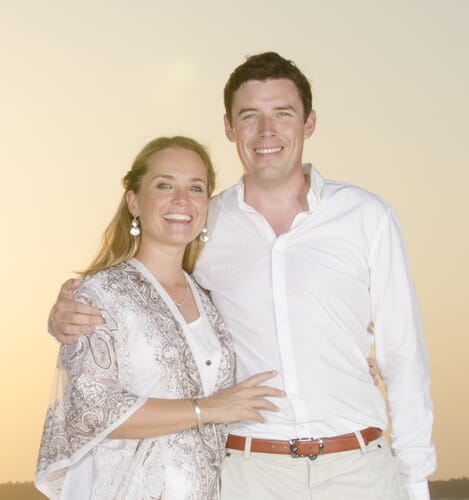
Get in touch
Talk to tess & mike about your next big adventure, begin your adventure.
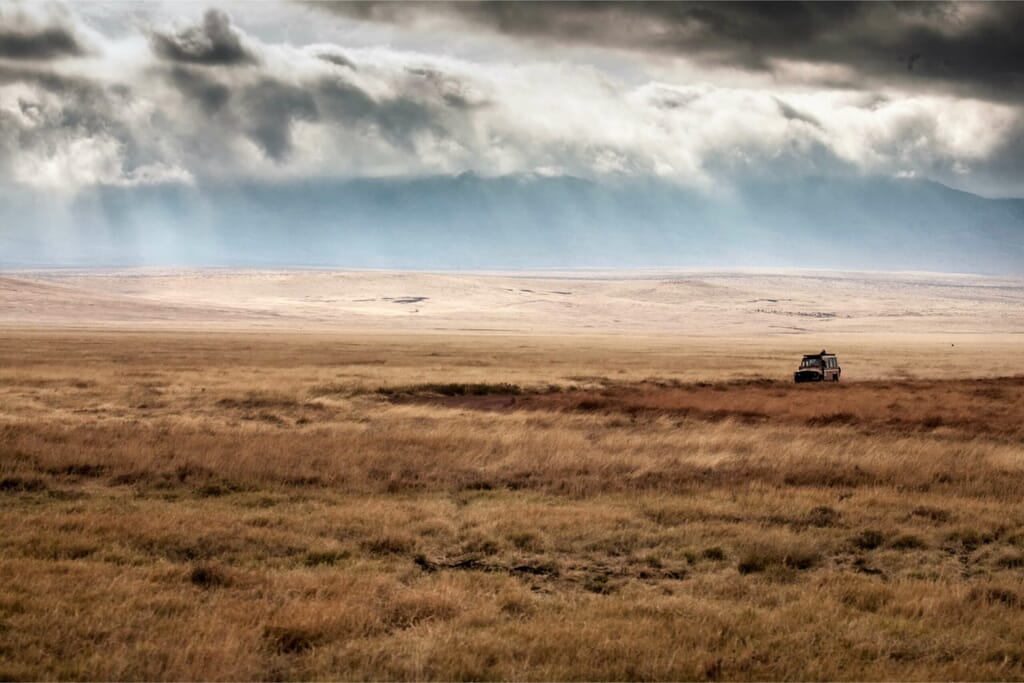
Your adventure begins now
Join our mailing list to receive the latest updates and travel inspiration
Privacy Overview
- 1 800 970 7299
- Live Chat (Online) Live Chat (Offline)
- My Wishlist
- Find a Trip
Your browser 'Internet Explorer' is out of date. Update your browser for more security, comfort and the best experience on this site.

Africa Safari Tours & Vacations
- Africa Safari Tours & Holidays
Take a walk on the wild side on an African safari.
The word “safari” means “journey” in Swahili. And a safari in Africa is all about the journey. While seeing a leopard munch on a freshly caught gazelle or spying a curious lion cub venture away from its mother’s protective embrace will be highlights of your trip, you’ll discover the journey is as much a part of your trip as the destination.
The road-trip games you play with your new travel mates, the feeling of the wind (and maybe a little dust) in your hair when you’re travelling down long, winding roads, and the young Maasai boy who waved at you as you passed him along the road will stay with you long after you return.
Our African safari tours
Okavango experience, 10 days from 1580.
Tour through Johannesburg, Maun, Chobe National Park, the Okavango Delta and Victoria...
Explore Southern Africa
18 days from 2925.
Spend some time exploring Botswana, South Africa and Zimbabwe with included safari...
Gorillas & Game Parks
16 days from 4311.
Encounter the wildlife of Kenya and Uganda on this overland adventure including a...
Cape Town to Vic Falls
22 days from 2903.
Spend three weeks exploring South Africa, Namibia, Botswana and Zimbabwe, from Cape...
East Africa Highlights
10 days from 3542.
Explore East Africa, like Kenya, Masai Mara National Reserve, Serengeti National Park...
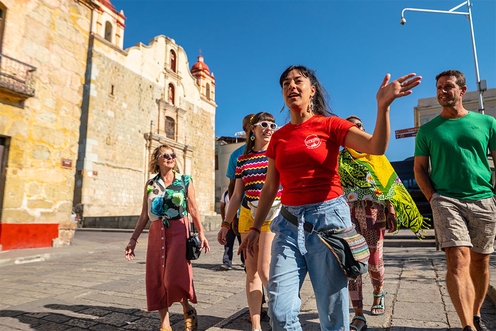
Tailor-Made trips
Take four or more on an exclusive trip and tailor your itinerary
Kenya Wildlife Safari
8 days from 1404.
Experience Kenyan wildlife on an eight day trip travelling from Nairobi to Lake...
Botswana Highlights
9 days from 2518.
Discover the culture, wildlife and waterways of Botswana on an adventure that visits...
Road to Zanzibar
12 days from 1983.
Experience the beauty of the Ngorongoro and Serengeti, Usambara Mountains and Zanzibar...
The Masai Heartlands
15 days from 3688.
Uncover Kenya and Tanzania on a 2 week trip with Serengeti safaris, Ngorongoro, Nakuru,...
Serengeti Trail
8 days from 1887.
Roam the Serengeti, Ngorongoro Crater and Amboseli National Park to spot Africa's Big...
Vic Falls to Kruger
9 days from 1330.
Take on a safari adventure through Hwange National Park, Matobo National Park, Kruger...
Gorillas, Game Parks & Beaches
27 days from 6980.
Go deep in East Africa on this epic trip, including Kenya, Uganda, Tanzania and Zanzibar.
Botswana Adventure
10 days from 4332.
Visit Africa and travel through Botswana, Namibia and Zimbabwe on a tour from Windhoek...
Namibia Discovery
13 days from 3765.
Travel from Cape Town in South Africa to Namibia’s Windhoek through coastlines, sand...
Amazing Southern Africa
22 days from 7695.
Jump onboard an exhilarating journey from Cape Town to Victoria Falls through the...
Vic Falls to Cape Town
22 days from 2618.
Discover the unique and contrasting lands of Zimbabwe, Botswana, Namibia and South...
Remarkable Rwanda & Gorillas of Uganda
9 days from 4786.
Travel through Rwanda and Uganda in search of natural beauty and the gentle mountain...
Garden Route Adventure
14 days from 1819.
See Africa from Durban to Cape Town on a 14-day adventure. Tour Tsitsikamma, Addo...
Best of East Africa
20 days from 4717.
Step out onto the Serengeti and keep your eyes out for rhinos, lions, leopards and a...
Cape Town to Zanzibar
41 days from 5496.
See Africa on this incredible overland adventure from South Africa to Tanzania. Soak up...
Serengeti & Kilimanjaro
15 days from 5160.
Explore the wonders of Tanzania and Kenya, including a trek to the summit of Mt...
Okavango & Beyond
9 days from 2074.
Travel from Zimbabwe to South Africa via Botswana. The Okavango and Beyond trip is the...
Vic Falls to Stone Town
17 days from 2261.
See East Africa in 17 days including Victoria Falls, Matobo, South Luwanga, Lake Malawi...
Southern Africa Adventure
30 days from 4560.
Take a month long southern African adventure from Cape Town into Namibia, Botswana and...
Essential East Africa
10 days from 1845.
Hit the (dirt) road through Kenya and Tanzania. Safari in the Serengeti, Ngorongoro...
Africa Encompassed Northbound
64 days from 12940.
This epic journey with explores Southern Africa in detail including Botswana, Kenya,...
Johannesburg to Kenya
37 days from 6959.
Travel the waterways of Botswana, the beaches of Zanzibar and the savannahs of the...
Cape Town to Kenya
49 days from 7776.
Experience the ultimate African adventure on this epic trip including Kenya, Botswana,...
Kruger & Coast
9 days from 1258.
Explore diverse southern Africa on this nine-day adventure, including Kruger National...
Gorillas to Vic Falls
42 days from 8700.
Explore Kenya, Malawi, Tanzania, Zambia and Zimbabwe on this epic trip that included a...
Safari to Kilimanjaro - Machame Route
16 days from 5992.
Explore the wonders of Tanzania and Kenya including a trek to the summit of Mt...
Africa Encompassed Southbound
63 days from 13180.
Set out on a mighty African adventure through Kenya, Uganda, Tanzania, Malawi, Zimbabwe...
Vic Falls to Kenya
28 days from 5002.
Discover East African wilderness and the animals that call it home on an adventure...
Zanzibar to Cape Town
40 days from 5048.
Explore Africa on an epic wildlife-rich adventure from Tanzania to South Africa while...
Kenya to Cape Town
48 days from 7916.
Tour Africa's best from Kenya to Cape Town through Tanzania, Zanzibar, Malawi, Zimbabwe...
Stone Town to Nairobi
9 days from 2358.
Explore Tanzania on this trip travelling to Nairobi via the Serengeti and the Usambara...
Stone Town to Vic Falls
16 days from 1999.
Track rhinos on foot and embrace the sights and sounds of Eastern Africa on this unique...
Johannesburg to Gorillas
52 days from 11780.
Experience the waterways of Botswana, the beaches of Zanzibar, the savannahs of the...
Kenya to Vic Falls
27 days from 5000.
Explore the wilds of East Africa on a trip from Nairobi to the Serengeti, Usambara...
Kilimanjaro & Serengeti Adventure
15 days from 6696, beaches, game parks & gorillas, 27 days from 7620.
Spend 27 days exploring the wonders, wildlife and tribal cultures of East Africa to...
Zanzibar to Vic Falls
19 days from 2195.
Explore East Africa from Zanzibar's beaches to the roar of Victoria Falls, seeing...
Johannesburg to Zanzibar
29 days from 4785.
From Johannesburg to Botswana, Victoria Falls, Zimbabwe, Zambia, Lake Malawi and...

Zanzibar to Nairobi
12 days from 2759.
Get a true taste of eastern Africa on a 12-day trip to Zanzibar, the Serengeti,...
Vic Falls to Zanzibar
20 days from 2684.
Travel from the thundering Victoria Falls to the spice plantations of Zanzibar via...
Vic Falls to Gorillas
43 days from 9990.
Take an epic trip through eastern Africa, via Victoria Falls, the Serengeti and...
Africa safari h ighlights
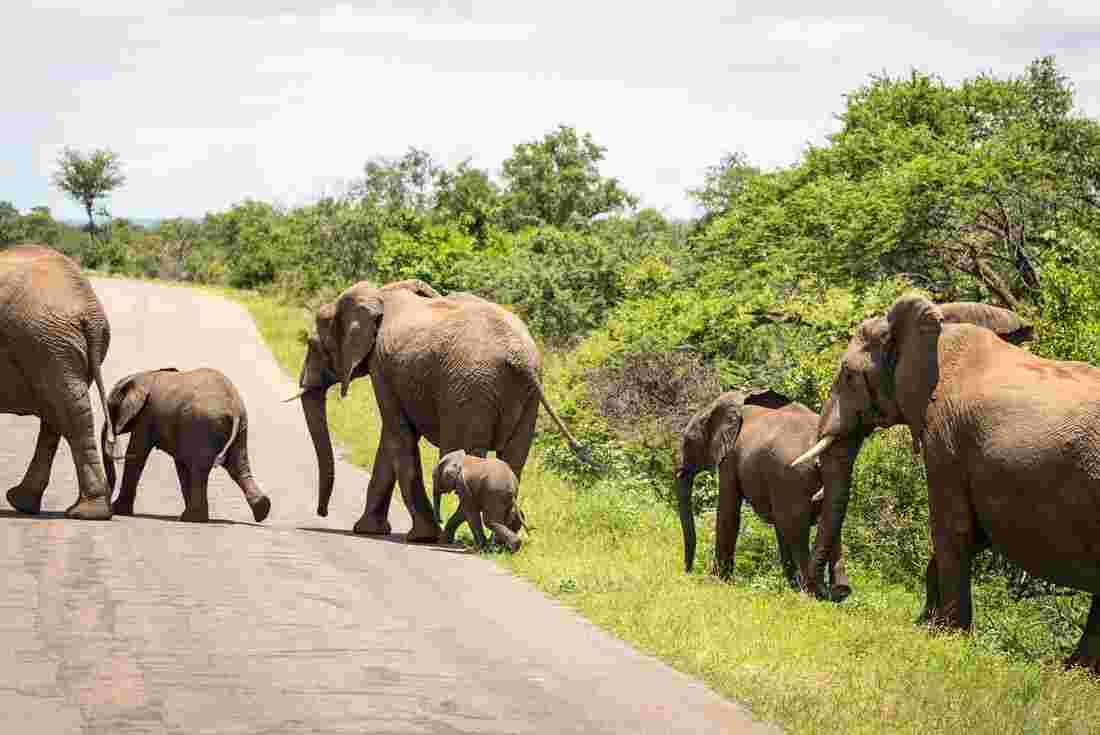
Spot the Big 5 in South Africa
Go on safari through Kruger National Park, one of the largest game reserves in Southern Africa . This massive park is one of the premier safari spots in all of Africa and for good reason; it’s home to over 500 bird species, 100 species of reptile and 150 mammal species, including the Big Five and the endangered African wild dog.
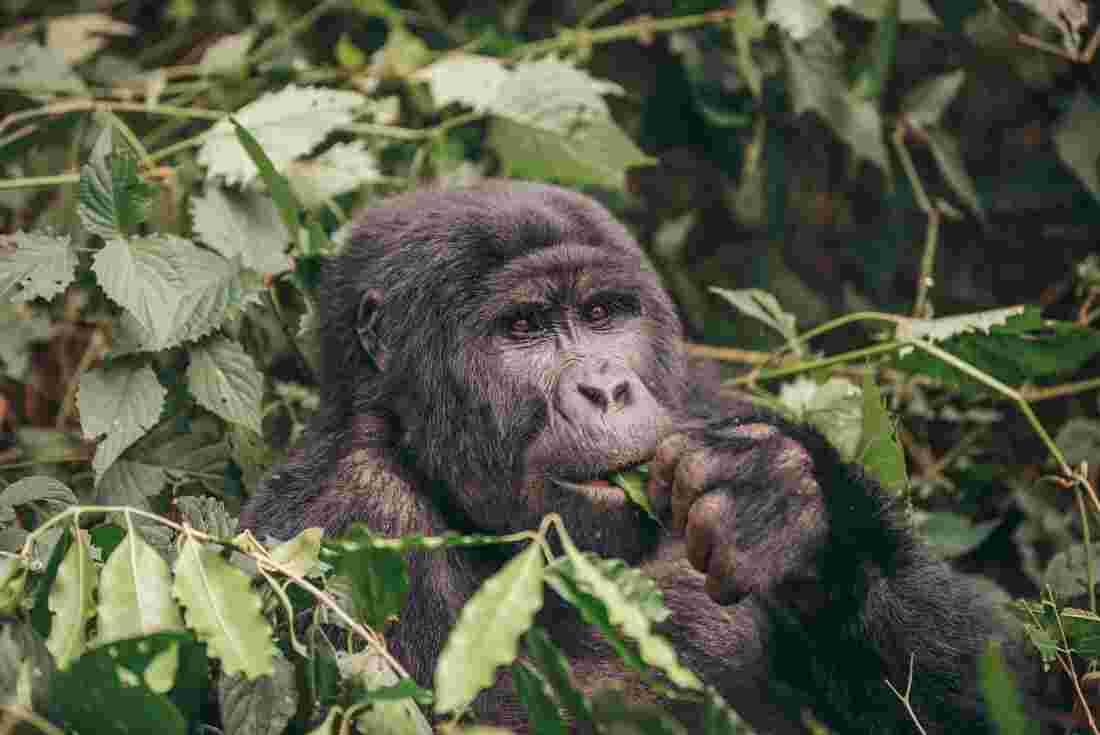
Go gorilla trekking in Uganda
Venture deep into the steamy jungles of Bwindi Impenetrable Forest in search of the rare mountain gorilla. With a local guide to lead you, you’ll trek into the forest to spend one unforgettable hour watching and hanging out with a family of gorillas. A close encounter with these gentle giants is an extraordinary African experience that will always stay with you.
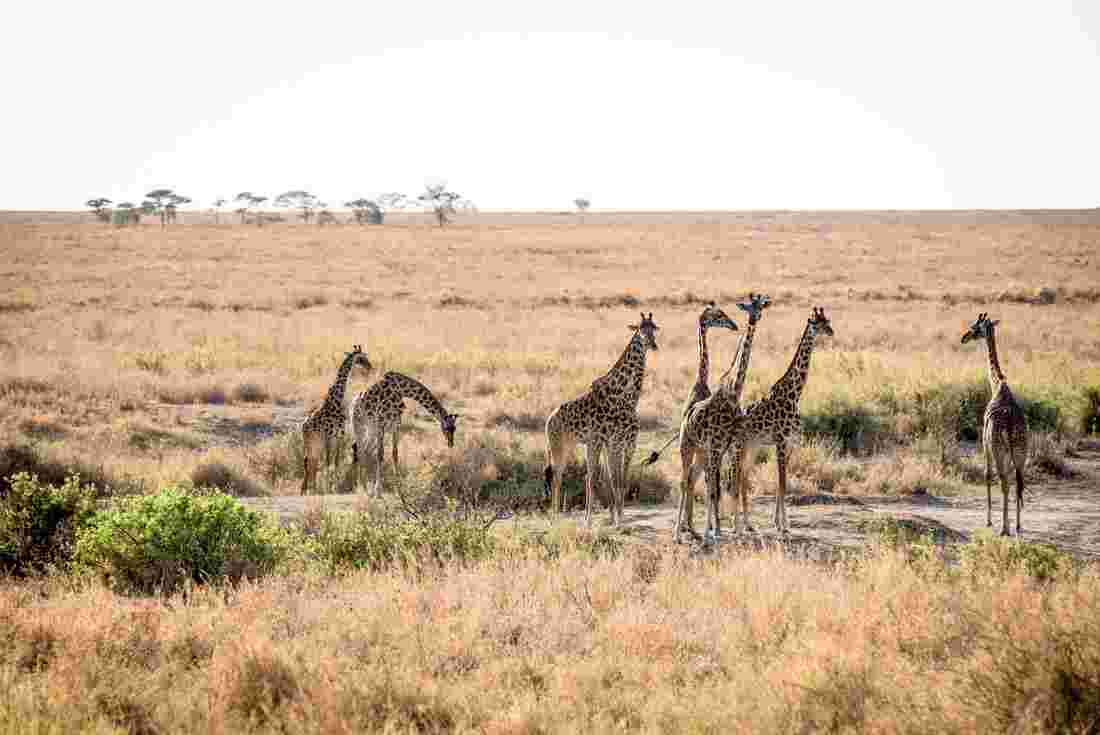
Float over the Serengeti
The only thing more magical than witnessing the great wildebeest migration across the Serengeti? Seeing it from the sky in a hot air balloon. As the herds of wildebeest and thousands of other animals travel from Serengeti National Park to the greener pastures of the Masai Mara National Reserve, you can watch their journey and enjoy incredible views from a unique perspective.
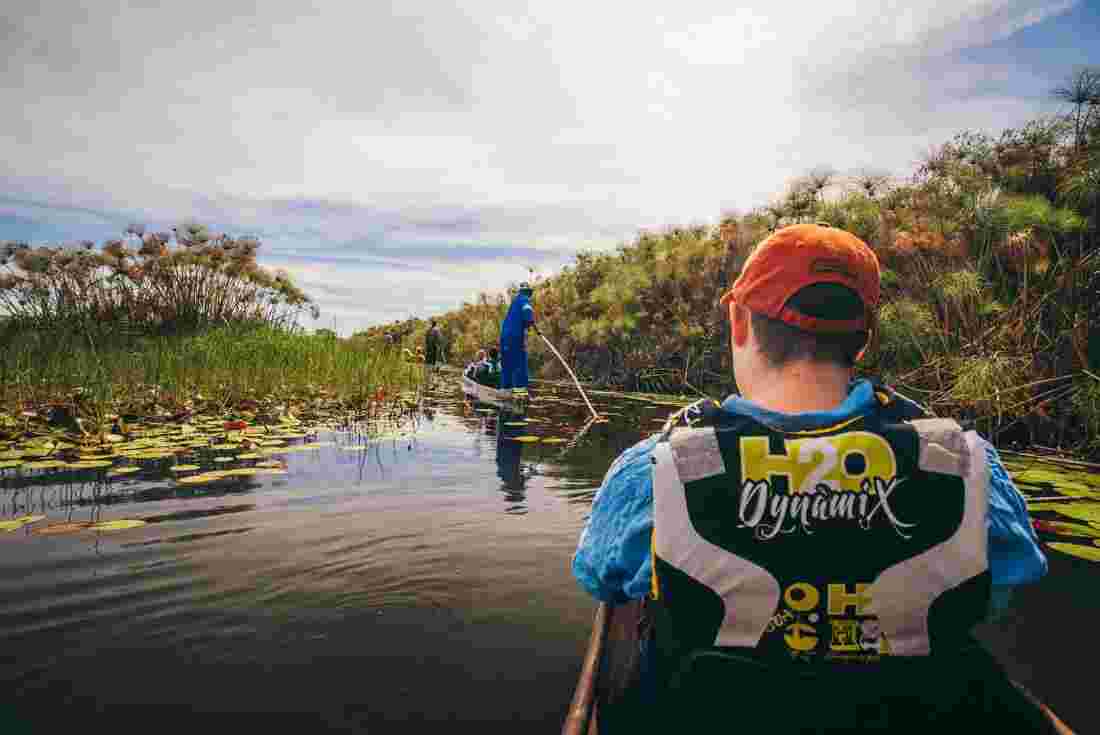
Canoe in the Okavango Delta
The Okavango Delta has a unique system of waterways that are home to an immense array of wildlife. The best way to explore it is in a mokoro, a traditional dugout canoe. Visit in May to September, when animals are confined to small islands created by the annual flood, making it easy to spot great herds of elephant and antelope, hippos, crocodiles, lions, cheetahs and more.
Popular safari destinations

Kruger National Park

Serengeti National Park

The Okavango Delta

Region comparisons

Chobe or Okavango?

Serengeti or Masai Mara?

View our range of gorilla treks
Where we stay on safari.
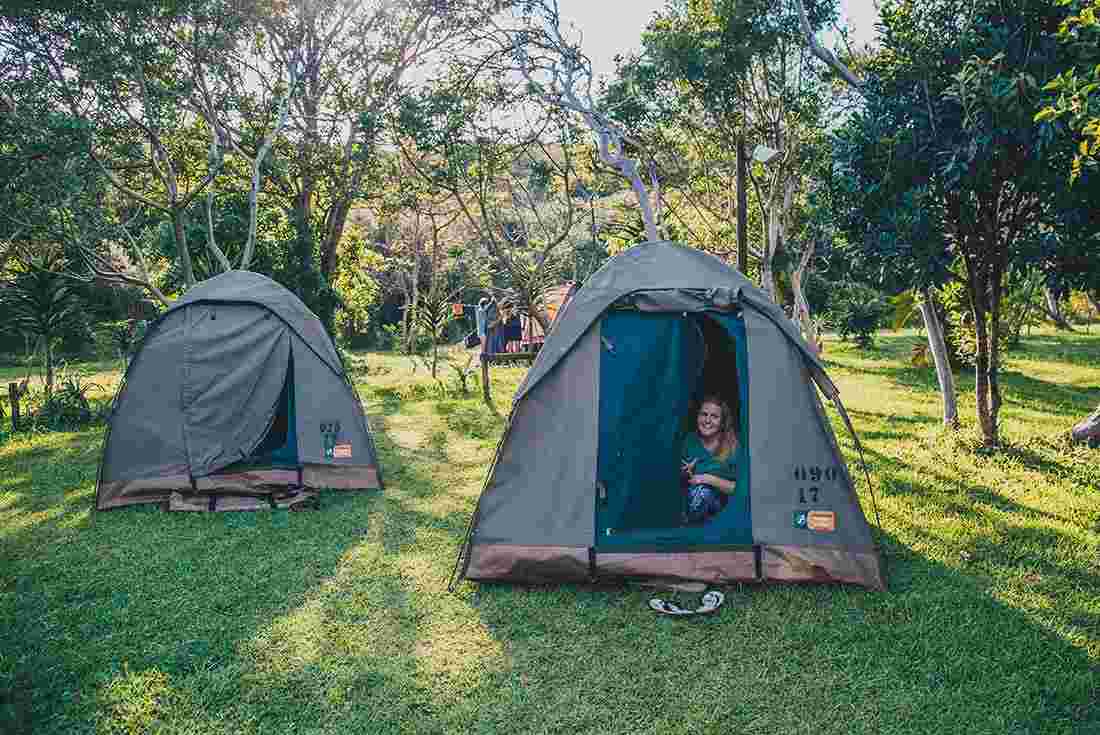
On our safari trips you’ll stay in billion-star accommodation. That’s our way of saying you’re sleeping under the night sky, camping in the great outdoors. On our Basix and sections of Original trips, you’ll stay in two-person canvas tents that our crew will help you set up. And on our Comfort trips, you’ll be staying in permanent tented camps and lodges (think glamping instead of camping).
Campsite facilities can sometimes be basic, but wherever possible, we make sure there are Western-style toilets and warm water available. But you’ll find it’s worth sacrificing a warm shower or two when you’re waking up to sunrise over the Masai Mara.
How we get around
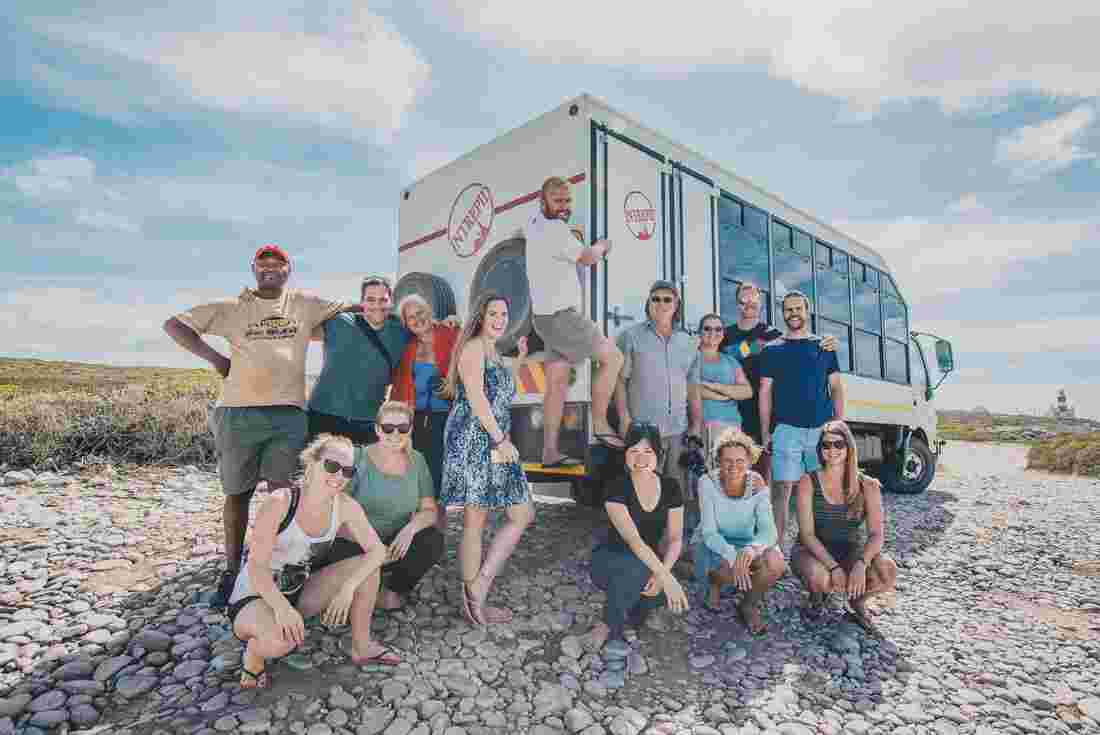
On our safari trips, your main mode of transport is an overland truck, a purpose-built vehicle made for driving through Africa’s winding, and sometimes bumpy, country roads. While the trucks don’t have air conditioning, they do have sliding windows which let in the breeze and make it even easier to take spectacular snaps of the local wildlife. The trucks are also equipped with power outlets to charge your camera, phone and other devices on the go.
For more info on our overland trucks, see our Africa overland page .
African Safari FAQs
When is the best time to go on safari.
Generally speaking, January, February and June to October are the best times to go on safari in Africa. This is the dry season, so animals tend to come out into more open spaces in search of water, making them easier to spot. However, you’ll be able to spot animals all year round and you’ll enjoy fewer crowds if you travel outside peak season.
Read more about the best time to go on safari .
Where is the best place to go on safari?
The best place to go on safari depends on what kind of animals you’d like to see and what other activities you’d like to do in destination. We offer safaris to some of the best safari destinations in eastern and southern Africa, like Kenya, Tanzania, South Africa, Botswana, Zimbabwe, Namibia and more.
Read more about how to choose your ideal African safari .
Am I guaranteed to see animals on safari?
While we can’t guarantee you’ll spot the Big 5, you’d have to be profoundly unlucky to see no animals at all. On our trips, you’ll explore some of the best game parks and national reserves in the world. These protected areas are filled with a huge variety of different species and your expert driver and local leader will help you spot animals.
What are the “Big 5”?
The “Big 5” used to refer to the five big game animals that were the most difficult to hunt. Now that most shooting is done on a camera, the Big 5 are the most exciting animals to spot while on safari: the lion, leopard, rhinoceros, elephant, and Cape buffalo.
What should I pack for safari?
Loose, light clothing in neutral colours is the best attire for a safari (dark colours will get hot in the sun and can attract the Tsetse fly). You’ll also want a sun hat, some good walking shoes, a camera, sunscreen and bug spray. For more details, check out our ultimate Africa packing guide .
What type of food will be served on safari?
On our Basix trips you’ll have a cook travelling with you while you are on safari who will whip up a variety of local flavours and Western-style dishes. Along your route, your cook will stop to purchase fresh, locally sourced food for your meals. You can expect a variety of things for breakfast like fruit, eggs, toast and cereal; lunch is often sandwiches and salads; and dinner is usually a hearty meal like pasta, curry or a BBQ.
On our Original and Comfort trips there will be more meals at camps and lodges along the way. No matter what you’re craving, you definitely will not be going hungry on safari.
What are the toilets and showers like on safari?
Most of the permanent tented camps will have a private bathroom with flushing toilets and showers with warm water.
Many of the campsites we stay at have communal facilities with flushing toilets and showers with warm water. However, in some of the more remote areas, there may only be basic facilities (toilets and cold running water).
Can you accommodate accessibility requirements on your safari tours?
We are committed to making travel accessible to everyone, so we will work with you to assess whether you will be able to complete an existing itinerary, or whether we will be able to make reasonable adjustments to meet your needs before you book. Please see our accessible travel page for more information.
What is internet and phone access like on safari?
Some of our hotels and campsites will have Wi-Fi, however Internet and phone access may be limited in more remote areas. But you won’t miss it when you’re watching a pride of lions prowl through long grass or enjoying a drink around the campfire with your group.
Responsible travel
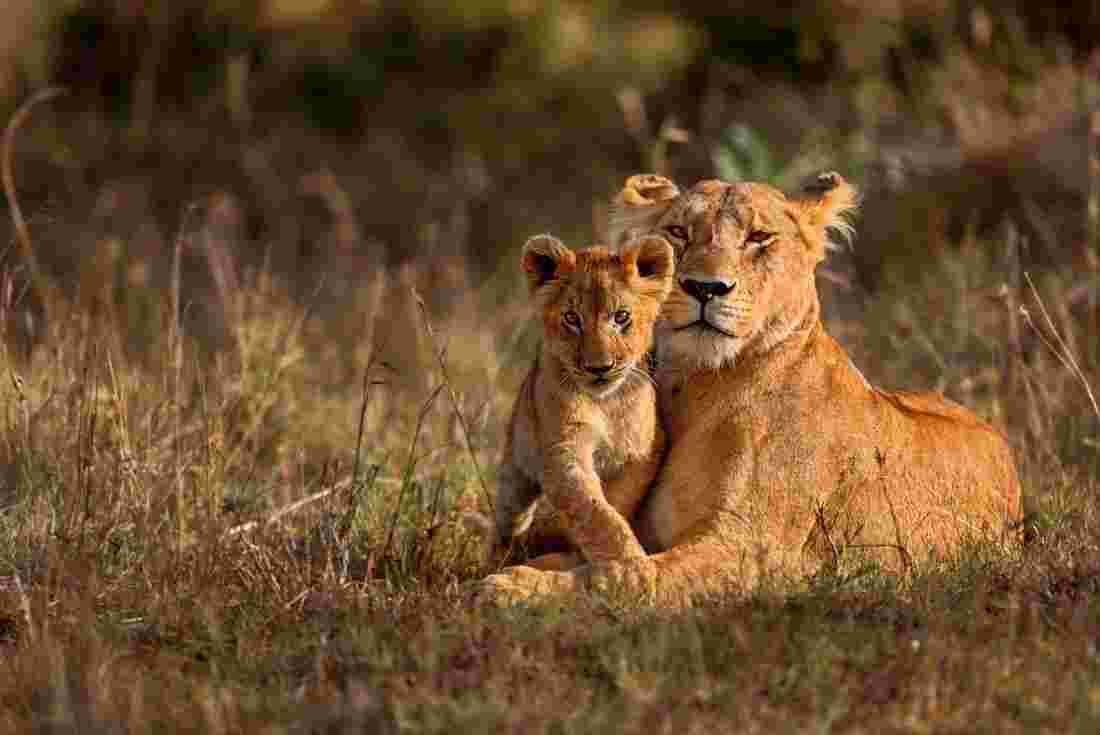
Our stance on Animal Welfare
This world and the animals that call it home are precious, and we believe it’s our responsibility to help preserve them. We do not include or condone any activities that exploit animals on our safari trips, including hunting, feeding or interacting with animals in any way. We believe that wild animals should be observed in the wild, from a respectful distance.
Some tips for being a wildlife-friendly traveller include never buying animal products, not participating in activities that include contact with the animals, and not including location tags on social media posts (some poachers have gone high-tech and use social media to track rare animals’ locations).
Read more about our Animal Welfare Policy here .
Read more about African safaris
The Best Destinations for a Family-Friendly African Safari
:max_bytes(150000):strip_icc():format(webp)/DSC00412-5b73daf7c9e77c0057ca2198.jpg)
TripSavvy / Jess Macdonald
Going on a family safari will be one of the most rewarding and exciting vacations you'll ever take. However, traveling on a shoestring is more difficult when you have kids in tow and as such, your African adventure is unlikely to be cheap. Because of this, it's something you may only do once - so choosing the best destination and itinerary possible is important. In this article, we take a look at Africa's most family-friendly countries along with itineraries and lodges that cater specifically to children.
Choosing Your Destination
The first step to planning any safari is deciding where you want to go. If you're traveling with children, there are several things you need to consider. Safety is always the top priority for parents, so a politically stable country with access to decent medical care in case of an emergency is a good idea. The fewer vaccinations required the better, while malaria-free destinations win top marks for obvious reasons.
Cost is another factor when you have more people to pay for, so choose a country with reasonable accommodation and tour prices. Destinations that lend themselves well to self-drive safaris are another great choice for families on a budget and give you the benefit of being flexible with your travel plans. For all of these reasons, we recommend Southern African nations like South Africa, Namibia and Botswana over the iconic safari destinations of East Africa .
South Africa for Families
With its first world infrastructure and world-class national parks, South Africa is the obvious choice for a family safari. There are game-viewing destinations for every budget, ranging from exclusive private reserves like Shamwari and Ulusaba to national parks like Kruger and Addo . The latter are a great option for families on a budget, as they allow self-driving and offer affordable accommodation in the form of campsites and self-catering chalets.
Self-driving is an excellent option for families, giving you the flexibility to stop whenever you like, cut game drives short if your kids get tired and deal with tantrums without worrying about other guests. South Africa is made for independent exploration, with good roads and car rental services in every big city. Many South African game parks are malaria-free and you don't have to worry about other tropical diseases like yellow fever or Zika virus.
Finally, there's more to South Africa than its incredible game reserves. If a full two weeks of wildlife-viewing sounds like a stretch for your kids, there are countless other activities for children . Consider township tours in Joburg, breathtaking Cape Town beaches, whale-watching off Hermanus or ostrich-riding and caving trips near Oudtshoorn.
Recommended itineraries: Best of South Africa for Families , Cape & Kruger Family Holiday , The Ultimate South Africa for Families
Recommended lodges: The Motse, Tswalu Kalahari, Ant's Nest, Waterberg
Namibia for Families
Namibia offers many of the same benefits as South Africa. With the Namibian dollar pegged to the South African rand, you can expect to pay similarly low prices for accommodation, park fees, fuel and day-to-day living. Though they're often gravel instead of tarmac, the roads are exceptionally well-maintained and many travelers claim that they feel safer in Namibia than anywhere else on the continent. Much of the country is malaria-free (except for the magnificent Caprivi Strip ).
Namibia's most famous national park, Etosha, is one of the best wildlife-viewing destinations in Southern Africa with almost guaranteed rhino sightings. In between game drives, there are plenty of other attractions to keep kids interested, from dune surfing in the Namib Desert to visiting traditional Himba villages in Damaraland and exploring Sossusvlei's otherworldly landscapes. Bear in mind that Namibia is a huge country and kids will need to be able to cope with long journeys.
Recommended itineraries: Namibia Family Camping Safari , Northern Namibia for Families , Namibia Self-Drive Family Safari
Recommended lodges: Sossusvlei Desert Lodge , Mushara Bush Camp
Botswana for Families
Botswana is another excellent option for a family safari. It offers the perfect balance of safety and adventure, with good infrastructure, a stable government and some of the most rewarding game parks on the continent. It's probably best for families with a bigger budget, however, because it's more geared for fly-in safaris than self-drive itineraries, especially if you want to visit the Okavango Delta (and trust us, you do). You'll also need to fork out for malaria prophylactics , the most child-friendly of which are expensive.
The need to take malaria medication is one reason why Botswana is suited to slightly older kids. Older kids will also be able to enjoy walking safaris and traditional canoe or mokoro trips which are two of the country's best experiences. Game parks like Chobe , Moremi, Kgalagadi and Savuti are arguably better for wildlife-viewing than those of Namibia or South Africa, but bear in mind that there are fewer alternative activities for kids that are easily bored. Unlike in the other two countries, you can't divide your time between the bush and the beach.
Recommended itineraries: Classic Botswana Family Safari , Northern Botswana Family Explorer Safari , Botswana Family Safari Adventure
Recommended lodges: Footsteps Camp , &Beyond Sandibe Okavango Delta Lodge
South Africa Guide: Planning Your Trip
The Ultimate Guide to Choosing the Right Safari for You
Malaria Free Safaris in Africa
10 of the Best Places to Visit in Botswana
Top 5 Self-Drive Safari Destinations in Southern Africa
How to Plan an Affordable African Safari
Africa Highlights: What to Do and Where to Go
A Guide to Southern Africa's Four Corners Region
The Best Time to Go on Safari
Road-Tripping Through South Africa’s National Parks with a Toddler
The Top 12 National Parks to Visit in Africa
Okavango Delta, Botswana: The Complete Guide
Kgalagadi Transfrontier Park, South Africa: The Complete Guide
The Top 5 Places to See Leopards in Africa
18 Top Things to Do in North West Province, South Africa
Fun Facts About African Animals: The Cheetah
- Destinations
Wild Junket

Kenya with Kids: My Kenya Family Safari Guide
Last Updated on May 24, 2024
Traveling Kenya with kids can be a life-changing experience for both you and your kids. Here is my guide to planning a perfect Kenya family safari.
For adventurous families, Kenya makes an excellent introduction to Africa. The country is home to world-class national parks, nature reserves, and pristine beaches. Plus, Kenya has improved its tourism infrastructure over the years and is now more family-friendly than ever.
Of all the 25 African countries I’ve been to, Kenya is definitely my favorite place in Africa to travel with kids . Granted, roads in Kenya can be terrible and poverty is still an issue in Kenya. But there’s so much the kids can gain from a family trip to Kenya, whether it’s a lesson in compassion or learning knowledge on wildlife and geography.
Pack a sense of adventure and a positive attitude, and you’ll be sure to have an epic adventure in Kenya with kids. For those planning a Kenya family trip, here is my complete guide with the best things to do, where to stay and what to pack for Kenya with kids .

Table of Contents
Why Travel Kenya with Kids?
Is it safe to travel kenya with kids, travel visa for kenya, how to get to kenya, when to travel kenya with kids, how long to travel kenya with kids, 2 weeks in kenya with kids, 1 week in kenya with kids, by car rental, by hiring a driver, travel kenya independently or on guided tour, budget kenya family safari, things to know about kenya family safaris, where to stay in kenya with kids, nairobi national park: the emakoko, lake nakuru: lake nakuru lodge, maasai mara: sarova mara game camp, diani beach: villa mandhari , lamu island: kizingo, visit the david sheldrick elephant orphanage , feed giraffes at the giraffe center , see the traditional dances at bomas of kenya , go on game drives in nairobi national park, see flamingos at lake nakuru, see the big five at maasai mara, go on a hot air balloon over maasai mara, visit a maasai village, see mount kilimanjaro in amboseli national park, relax on diani beach, snorkel in watamu marine national park, wander around unesco lamu island, traditional kenyan food to try, what to pack for kenya with kids, my packing list for kenya with kids, health in kenya, hygiene/water in kenya, cost of travel in kenya, practical tips on traveling kenya with kids, enjoy your trip to kenya with kids, kenya with kids guide.
From my experience, trips that revolve around nature and wildlife are always a big hit with kids. Nature is the greatest playground for kids and Kenya sure has plenty of it.
Kenya is one of the top African countries for wildlife watching . It is home to the world-famous Maasai Mara National Reserve, a stomping ground for thousands of animals migrating across its plains each year during the annual migration. For the ultimate Kenya family safari, come face to face with giant elephants with Mount Kilimanjaro in the backdrop at Amboseli National Park , or see thousands of flamingos fly above Lake Nakuru.
Kenya is also blessed with a stunning coastline — plan in some relaxing time on Diani Beach or cultural walks in the Swahili town of Lamu island in your Kenya itinerary , and your kids will thank you for it! Make sure to read this article on things you need to know before traveling to Kenya .

It is understandable to be concerned about safety in Kenya with kids. After all, Nairobi has a high crime rate and it has experienced several bombings in recent years. But you can easily avoid the city centre and stay in the quiet outskirts or Nairobi National Park (15-min drive from airport).
Beyond the big city, it is generally very safe in the national parks and nature reserves. You might be worried about your kids’ safety on safari after seeing videos of cheetahs jumping onto safari jeeps, but such things rarely happen. Animals usually prefer to keep their distance from human beings. As long as we don’t disturb the wildlife, they won’t disturb us.
The bigger issue is health and hygiene due to malaria and yellow fever risks and food contamination. It is mandatory to have the yellow fever vaccination to enter Kenya (you’ll be asked for proof). But one shot lasts a lifetime. Refer to my section on health in Kenya for details.

Most nationalities including US, UK, EU and Canada citizens need a visa to enter Kenya. You can easily apply for an evisa online. Single-entry visas cost $51 and allow you to stay for 3 months. Note that there are several fraudulent evisa websites — this is the official evisa website.
Some nationalities (including mine!) do not a need a visa to travel Kenya. These include nationals from Singapore, Malaysia, San Marino, South Africa. Here is the full list.
Good news: Children aged 16 and below do not require a visa to enter Kenya, regardless of nationality.

The main gateway to Kenya is Jomo Kenyatta International Airport (NBP), around 11 miles (18km) from Nairobi’s CBD.
I found an amazing deal online: Amsterdam – Nairobi – Seychelles and return for just under € 600 ($670). I learned about the airfare promo on Fly4Free.com and booked it way in advance.
You can generally find flights from New York to Nairobi via Istanbul for around US$750 return. For those in Europe, you can fly direct from London to Nairobi (9hours) for around $550 return.
Search for Cheap Flights to Kenya

The best time to travel Kenya is from July to October , which are the best wildlife viewing months. The wildebeest migration usually reaches the Masai Mara in July and remains until October. But note that this is high season and certain parks can get crowded.
Rainy season runs from March to May, during which some lodges and camps close down. During high rainfall, it can be hard to see animals as they won’t need to go in search of water.
November to February are good times to visit Kenya , as prices are lower and showers don’t last long. We visited Kenya in December this time and had great weather. However, we didn’t see as many animals as I did the last time in Maasai Mara, because there were torrential rains right before we arrived and they caused quite a lot of flooding.

There’s a lot to do in Kenya for kids. I recommend spending at least two weeks in Kenya so you can explore at a comfortable pace.
I would advise planning 2-3 nights at each national park. Kids can get tired of safari if you schedule too many days at each camp. At the same time, you don’t want to be moving around too much and spending just 1 night at each place. Read more of my tips about going on African safari with kids .
Mix up your Kenya itinerary with some relaxation time along Kenya’s beautiful coast. Diani Beach is Kenya’s most popular beach town, but there are plenty of towns along the coast worth visiting, including Malindi, Nyali and Watamu.
- Days 1 – 3: Nairobi
- Days 3 – 5: Lake Nakuru
- Days 5 – 7: Maasai Mara National Reserve*
- Days 7 – 10: Relax on Diani Beach
- Days 10 – 13: Explore Lamu Island
- Day 14: Fly Home!
- Days 5 – 7: Maasai Mara National Reserve
* TIP : Maasai Mara is the best reserve in Kenya, but it’s a 6-hour drive from Nairobi and Lake Nakuru. To go somewhere nearer, the best alternative is Amboseli National Park, a 4-hour drive away.

How to Get Around Kenya with Kids
The best way to get from Nairobi to the coast is on the domestic airline, Kenyan Airways. It is affordable and fast. Return flights from Nairobi to Mombasa are around US$100. Direct flights from Nairobi to Lamu Island are around US$200.
It IS also possible to fly from Nairobi to Maasai Mara and other reserves on Safarilink. But it is expensive, with flights costing around US$350 return per person. Flying cuts down the travel time from 6 hours by road to just 40 minutes.
Search for Domestic Flights

Roads in Kenya aren’t in the best condition and traffic around Nairobi is a nightmare. You would need a 4WD to drive into the national parks. Renting a Toyota Land Cruiser usually costs around $200-300/day.
I wouldn’t advise driving in Kenya with kids, unless you’re very experienced driving 4WD. My husband Alberto has driven in many countries, and even then, we decided to book transport with our lodge (which comes with a driver) as it cost the same as renting a 4WD.
Search for Car Rental in Kenya

What you can do instead is to book a safari lodge/camp and arrange a “road package” through them. The package includes a driver, 2 game drives per day during your stay at the lodge as well as pick-up and drop-off from any hotel in Nairobi.
Most lodges quoted us $150/day for a Toyota van and $250/day for a Land Cruiser safari jeep. We paid for the cheaper option and were fine for it. But for both options, you’ll only get a driver — not a wildlife guide who’s experienced in spotting animals! If you want a wildlife guide, book an all-inclusive safari tour . (More details here ).

If it’s your first time on an African safari with kids , I recommend booking a safari package that includes an experienced wildlife guide. A guide knows where to spot the animals and can share lots of interesting information about each animal.
It’s also important to book with responsible tour companies that have policies in place to thread carefully. Check out this 8-day Kenya family safari from Intrepid Travel. It’ll be a great opportunity to travel with other families and your kids will make lifelong friends. The minimum age to join is 5.
Another trip worth checking out is this 8-day National Geographic Kenya safari trip from G Adventures. I’ve traveled with them many times (to Antarctica, Brazil, Nepal etc) and each trip has been epic! You can also combine Kenya with Tanzania, and join this Kenya and Tanzania camping safari. The minimum age to join is 12.

To save some money, we booked the safari lodges ourselves and arranged transport through them. These road packages still cost around US$150-250/day, but they include a driver, pickup from Nairobi, and 2 game drives/day.
If you’re on a tight budget, I suggest exploring Nairobi independently and booking budget safari tours departing from Nairobi. Note that these 3/4-day tours are usually camping safari. That means you’ll actually be camping and sleeping in small 2-person tents. This was what we did when we first backpacked East Africa 10 years ago.
- 4-day Lake Nakuru & Maasai Mara tour
- 3-day Amboseli National Park tour
- 2-day Mount Kenya safari
- Lake Naivasha & Hell’s Gate Park day tour
- Ol Pejeta Conservancy & Chimpanzee Sanctuary day tour
- Elephant and Giraffe Experience day tour
There is just something so special about going on an African safari with kids — I will never forget the awe in my daughter’s kids when she saw her first giraffe. For kids like Kaleya who love animals, Africa is pure magic.
However, they are kids after all. Remind them to be patient on game drives — wildlife reserves are not zoos. Animals roam freely and sightings are not always guaranteed. You might also come across predators hunting or feeding on their catch, warn your kids that it can get graphic. Read my tips about going on safari with kids .
Game drives usually take place around dawn and sunset, as animals are the most active during these times. That means early wake-up calls at 5am. Because of the game drive schedule, your family will have lots of free time during the day. Bring cards or games to play as a family and reading materials.

Since you will be spending lots of time at the lodge, it is important to find one that can keep the entire family happy. Don’t expect kids’ clubs or program at the lodge — you’ll be lucky to have a swimming pool. Remember you are in the wilderness after all!
When we traveled Swaziland and South Africa , we noticed that many safari lodges and reserves don’t take kids below 6, for safety reason. But this isn’t the case in Kenya — most lodges here are happy to take toddlers and babies.
Things to consider when choosing a lodge for your Kenya family safari:
- Is it a fenced property? Kids aren’t allowed to wander on their own in an unfenced lodge and it can be unsafe at night when animals wander into the property.
- Are there structural hazards? Certain lodges have open decks that plunge a few meters beneath.
- Is there a shallow pool or play area?
- Does the lodge have a waterhole? Animals often go to waterholes to drink, so you can easily see animals from the lodge if it has one.

Best Family Hotels in Kenya
The Emakoko is a beautiful lodge located just a 15-minute drive from the park’s east gate. It is surrounded by vast savanna and secretly ensconced in a steep valley. We felt like we were deep in the wilderness, even though we were just short drive away from Nairobi. Our spacious family cottage was huge and perfect for the three of us. Read our full review of The Emakoko . Check the rates.
There aren’t many lodges located inside the national park, but Lake Nakuru Lodge is one of the rare few. The ecolodge has been around for a while and it is in need of a revamp, but rooms are still well maintained. The best feature of our room was the balcony, where we could get unobstructed views of the lake and wildlife. The pool was also an excellent spot to hang out. Check the rates.
We found a great deal online for Sarova Mara Game Camp and paid around $400 in total for our 2-night stay. It was definitely a good deal as the big-scale family lodge had tastefully designed luxury tents that were big and spacious. It’s definitely a great place to stay for a Kenya family safari as there were many other families besides us. The lodge also had a swimming pool and good restaurant with international food. Check the rates here.
Located 500 m from the Indian Ocean, this property offers excellent value with its modern and spacious villas for only $60/night.We loved staying at Villa Mandhari — our 2-bedroom villa was huge, the outdoor pool was nice and big, with a lot of lounging space. It’s also located in a peaceful and quiet area, perfect for families looking to relax after spending time in the bush. Check the rates here.
Located along the sandy Kizingo Beach, this rustic property stands at the tip of Lamu island where it meets the Indian Ocean. Kizingo has simple thatched-roof chalets all looking out to the ocean. I loved our veranda and swing bed. But the amenities are basic, and it’s more suitable for people who want a secluded place and go unplugged. Check the rates.

Things to Do in Kenya with Kids
One of the best Kenya activities for kids is this elephant orphanage . Elephant calves orphaned by poaching are brought here from all over the country to receive specialized treatment. Be warned: it gets crowded here as it’s opened to the public only 11am-12pm daily. Entrance is US$7.
You get to learn about each of the ridiculously cute baby elephants and some of them might even get up close to you. We booked a day tour for $35 and visited this along with the giraffe center and bomas.

This giraffe centre , which protects the highly endangered Rothschild’s giraffe, combines serious conservation with fun activities. You can hand-feed or even kiss the giraffes from a raised wooden structure, which is quite an experience for both adults and kids! Entrance is US$15 and kids under 3 are $7.50. Book your day trip here.

Bomas of Kenya is a living museum celebrating the colorful tribes of Kenya.The complex has a recreated traditional village with homesteads or bomas , each one reflecting the culture of an ethnic group. There are also traditional dance performances everyday.
Within a 15-min drive from the international airport, you’ll be in the wide open grass plains and acacia bush of the national park. Established in 1946, Nairobi National Park was Kenya’s first. It’s home to four of the Big Five (except elephants) and chances of seeing them are high because of the small size. We had an excellent guide here and saw plenty of animals in just 2 days! If you are not staying here, you can book a day tour that will include pickup from your hotel.

Lake Nakuru National Park is the best place in Kenya to see flamingos. Thousands of flamingos can be seen here massing in the warm alkaline water to feed on the abundant blue-green algae cultivated by their own droppings. As Europe starts cooling in October, migratory birds begin to arrive and remain in the area until April.

You can’t come to Kenya and not visit the famous Maasai Mara National Reserve . This massive grassland lies along the Great Rift Valley adjacent to Tanzania’s Serengeti. You are sure to see animals here, even during rainy season. We didn’t see quite as much as I did on my first trip, but we still spotted lions, cheetahs, giraffes, buffalos and many more animals. Visiting Maasai Mara with kids is definitely a once-in-a-lifetime experience.

If you want to do something special in Kenya with kids, there’s nothing more amazing than going hot air ballooning over the Maasai Mara . I’ve been on a hot air balloon 5 times and every single time was amazing. Bring your whole family to see the animals from above and enjoy a special champagne breakfast in the bush. Prepare to part with $450 for the experience of a lifetime. Book the experience here.

Maasai Mara is the land of the Maasai people , an ancient nomadic people known to be warriors. Maasai men were once expected to kill a lion to prove their strength and manhood. Recognizable for their red robes and beaded jewelry, the Maasai now sustain themselves with tourism and livestock. We arranged to visit a Maasai village through our driver and gave a donation of $50. The visit was definitely a humbling experience for our kid.

Crowned by Mount Kilimanjaro, Africa’s highest peak, the Amboseli National Park is best known for the spectacular landscapes. The name “Amboseli” comes from a Maasai word meaning “salty dust”, and it is one of the best places in Africa to view large herds of elephants up close. Kids will get the chance to see the real-life setting of “Lion King” here.

With its 17 kilometers of flawless, soft white sand, Diani Beach is the most popular beach town in Kenya, for good reasons. The soft white sand and clean water definitely make this a great escape after being on safari. There’s a whole lot to do for the young ones: from playing on the beach to snorkeling and kayaking.

Green turtles and unique coral gardens – the Watamu Marine National Park is an excellent place to visit for water babies. The park is part of a complex of marine and tidal habitats with rich and diverse bird life and dugongs. Besides water activities, you can also visit the nearby Gede Ruins, a 12th century Swahili village that was abandoned 600 years ago.

Founded in the 14th century, Lamu is the best-preserved Swahili settlement in East Africa . Crumbling old forts lie next to elegant rooftop cafés; narrow, cobbled streets wind past intricately carved front doors. Wander through Lamu’s Old Town , and you will find Indian, Persian, Omani and Portuguese influences visible throughout the coral stone houses and impressive mahogany doors.

What to Eat in Kenya with Kids
The traditional food of Kenya, is as mixed and diverse as its tribes, history and landscapes. Each tribal area has its own specialities, but below are some of the most common Kenyan dishes. If your kids are fussy eaters, they’ll be happy to know that most safari lodges serve western classics like spaghetti and pizzas.
- Ugali — This cornmeal is the main staple of Kenyan food. The texture is similar to that of a dough. It is eaten at every meal (in a similar way you eat rice) and usually with stews and vegetables.
- Irio — Another popular dish in Kenya, this mash peas and potato mix is hearty and heavy. It’s usually eaten with roasted meat (nyama choma).
- Kenyan pilau rice — This is a flavorful spicy rice dish cooked with spices like cumin, cardamon, cinnamon, and cloves.
- Kenyan stew — Kenyans love all kinds of stews: beef stew, goat stew, chicken stew or any other animal stew. The sauce usually has a tomato base and accented with the essential mchuzi mix!
- Nyama Choma — The unofficial national dish of Kenya, nyama choma is roasted meat cooked on the barbecue. Goat and beef are the most common forms of nyama choma, but chicken (kuku choma) and fish (samaki choma) are also valid choices.
- Fried fish — Along the coast, you’ll find fried tilapia fish everywhere, often served with tomato gravy and ugali or rice.

Wildlife watching involves lots of driving so pack a few books on African wildlife and kids’ binoculars to keep them engaged. Another kids’ travel gear that can come in very useful on safari is a kids digital camera . My daughter was super excited to use hers on safari!
Game drives always take place in the early morning and evenings, which can get cold regardless of the time of the year. In Maasai Mara, morning temperatures can dip as low as 12°C/54°F and day time temperatures reach around 25°C/77°F. Be sure to pack layers, and a warm jacket for the morning drives. Choose khaki t-shirts and beige cargo pants to blend in with the surroundings.
- Kids’ hiking shoes
- Kids’ sandals or Keen water shoes
- Kids’ safari hat
- Kids’ down jacket
- Kids’ fleece
- Kids’ zip-off convertible pants
- Earth-toned safari themed t-shirts
- Long-sleeved pajamas to protect from mosquitos
- Kids’ safari-themed underwear
- Kids swimsuit
- Kids’ breathable socks
- Kids’ polarized sunglasses with strap
- SPF 50 Sunscreen
- Insect repellant with DEET
- World travel kit stocked with medication
- Head torch or flashlight
- Kids’ binoculars
- Kids digital camera
- Canon EOS 60D camera
- RAVPower portable power bank
- 70-300mm Tamron lens
- International plug converter
- Kids’ books on African wildlife
- iPad or Kindle with headphones for long car rides

It is required to have the yellow fever vaccination to enter Kenya (sometimes they check your yellow fever certification at the airport). Suggested vaccinations include meningitis, typhoid, hepatitis A and B, and cholera. We got our daughter the yellow fever and hepatitis B vaccinations.
Firstly, get the vaccinations as early as you can, as some vaccinations come in doses. The yellow fever vaccination is easy to get (just consult your travel doctor) and one shot lasts a lifetime. Check the CDC website for more details.
Most parts of Kenya are malaria infected zones. Both adults and kids can take malaria preventative medication (the most popular being Malarone). Note that malaria pills aren’t advisable for young kids under 5 years old and they can have some side effects. Our 4.5-year-old can’t usually swallow pills, but we gave her the Malarone with a small chocolate each day. She ended up loving pill time!

Tap water in Kenya is not safe to drink. You can bring a Steripen and sterilize tap water or just buy water there. We bought a big 5L drum of water at our first day, and it lasted the whole trip.
Food wise, we ate very well in the safari lodges we stayed at. Almost every safari lodge includes all meals with the stay. While on the road, it is usually easy to find simple meat and rice/ugali dishes or wraps and sandwiches. Kenya’s infrastructure has improved since 10 years ago (when I first visited) — now you can easily find clean diners at petrol kiosks and in towns.
Be careful about eating street food especially in Lamu, as hygiene can be an issue. Remember to pack anti-diarrhea medicine and rehydration pills in case of food poisoning (see my detailed Safari Packing List ).

In general, Kenya is cheap to travel, if you are traveling independently. Food is affordable in local eateries (less than $10 per meal) but expect to pay more in restaurants.
A Kenya family safari can be expensive though — prices for a 4-day camping trip starts from $450 per person. The average rate for a budget safari lodge is $100/night and midrange safari lodge is $300. These rates cover all your meals and game drives. We ended up spending around US$880 on an all-inclusive 2-night stay in Maasai Mara for our family of 3.
National park entrance fees are another hefty cost. They are charged per day and per person (which makes it very expensive!). Most safari tours don’t include these fees and you’ll also need to pay for kids above 3. Here are the entrance fees for the major national parks:
- Nairobi National Park: $43 per adult, $22 per child per day
- Lake Nakuru: $60 per adult, $35 per child per day
- Maasai Mara: $70 per adult, $40 per child per day
- Amboseli: $60 per adult, $35 per child per day

- If it’s your first time on the African continent, manage your expectations and prepare your kids for that too. Infrastructure in Kenya has improved a lot since the first time I was there 10 years ago, but there are still certain things your kids might have to get used to, like hole-in-the-ground toilets and insects in the tents. It’s all part of the adventure!
- Many curio shops along the highways have sparkling clean toilets (that’s how they try to draw in the tourists), and drivers tend to bring you here. You’re not obliged to buy anything if you don’t want to.
- You will encounter many tourist touts when traveling in Kenya and some can be pushy. Just be polite and say no with a smile. Also, bargaining is part of their daily life, they expect you to bargain.
- Lastly, roads in Kenya are not the best. Prepare your kids for bumpy rides and long, dusty drives. Also bring dramamine for motion sickness.
- Don’t pack too much into your Kenya itinerary, as kids always require more down time. Slow down your pace and spend more time at each location.
- Pack a sense of adventure and a dollop of patience as things move slowly in Kenya. Adopt the ‘hakuna matata” (no troubles) attitude and everything is going to be alright.

- Best Safari Parks in Africa
- African Safari with Kids
- 2-Week South Africa Itinerary
- 2-Week Kenya Itinerary
- Swaziland Travel Guide
- The Annual Migration at Masai Mara
- What to Pack for Safari
- The Ultimate Kenya Travel Guide
- 28 Cool Things to Do in Namibia
Inspired? Pin it!

Nellie Huang
Nellie Huang is the founder of WildJunket. Originally from Singapore, Nellie has traveled to over 150 countries across 7 continents. She is a book author and Lonely Planet guidebook writer. As an adventure travel blogger, she has a special interest in unusual destinations and deep experiences. Follow her travels on her Facebook and Instagram .
Leave a Comment Cancel Comment
Save my name, email, and website in this browser for the next time I comment.
This site uses Akismet to reduce spam. Learn how your comment data is processed .
The Comments
What an incredible experience you had in Kenya. We have been planning a trip to Kenya and Tanzaia and we cant wait to have it this year with my family.
Thank you for sharing.
You May Also Like
What’s a transatlantic cruise really like, staying at the emakoko in nairobi national park, morocco with kids: my guide to planning a morocco family trip.
Eric Onsafari Photography and Safaris
African Boy as a Safari Guide
I believe in the old African proverb “The eye never forgets what the heart has seen”. A phrase that best describes the feeling one gets after visiting Africa and seeing her beauty. Born and raised in Kenya, I grew up accustomed to the marvelous thrills of the African bush life.
Africa is mystic, A beauty like no other. Her lure is irresistible to all, even those born and raised here, like me, whose love for the African wilderness encouraged him to pursue tour guiding studies and photography at The Kenya Institute of Tourism and Hospitality where I earned Diploma in Tour Guiding and Tour Operations in Wildlife and Conservation.
Am also a certified Ornithologist by Nature Kenya under National Museum of Kenya.
Am also a Travel life Organization Certified Member.
Rated member of the Kenya Professional Safari Guides Association, an independent non-profit making body created for the certification of Safari Driver Guides, Lodge Naturalists and other individuals within the Tourism Sector. .
The scope’s of my guiding is wide. Guiding large and small groups of visitors on private tours, Photography groups,cultural and history safaris, wildlife and nature safaris, Gorilla treks, mountain climbing, wildebeest migrations safaris among others for over 15 years with Great Experience in Tour Guiding career.
I am a seasoned photographer.
Jambo! And Karibu Africa Kenya.
Support me!!!!
Your email address will not be published. Required fields are marked *
Save my name, email, and website in this browser for the next time I comment.
Post Comment
Related Post
“Scarface”,the Former King of Masai Mara
Magical Masai Mara
- Destinations
- Photography
- Places to visit
- Top Destination
Jozani Chwaka Bay National Park
Nungwi Beach
Now live: super hotel.
National Geographic content straight to your inbox—sign up for our popular newsletters here

- INTELLIGENT TRAVEL
Tips for Taking Your Kids on Safari
African safaris are the things of bucket-list dreams. Who in their right mind would pass up the opportunity to watch animals in their natural habitat, roaming free as they were meant to? Who wouldn’t get excited about this chance of a lifetime?
Of course, they liked the idea of a safari. I’d told them about how we would bump along the great plains of Kenya and Namibia in a high-seated jeep, spying lions, elephants, and zebras through our binoculars and, perhaps — even thrillingly — up close.
What I neglected to tell them is that safaris require much more than a desire to see the animals. They require patience. It’s possible to be out in the fields for hours and only see baboons and gazelles. Beautiful in their own right, but not exactly the thrill the kids were after.

It’s that lack of excitement in the field that actually makes a safari magical — the anticipation of it all. It’s the way your heart jumps when the lump you thought was simply a large stone…moves, or when you spy something small in the bush, only to realize it’s a lion cub, no, wait, two — and there, in the shadow, its mother, too!
In those moments the entire jeep will go momentarily silent. And then the cameras will start clicking and your family will be among them, wondering how you managed to find yourself right there, right then. But in the moments in between, your children’s tired cries of “I’m bored” may just drive you crazy.
Fear not, adventurous ones! I’m here to save you at least some of the trouble we went through by giving you a few things to think about before booking a trip to the Serengeti or beyond:
Start small. When we were in Namibia we moved from smaller game parks up to the enormous Etosha National Park . While the animals we saw while at our first overnight stop just outside the city of Windhoek were smaller, the kids — who had never been on safari before — were excited to spot them and way more receptive to learn about them than they would have been if they had already seen a lion. By the time we reached Etosha, they could point out some of those smaller animals on their own and were even more blown away by the big game.
Manage expectations. Talk to your kids about patience, and remind them that they might have to wait to see the big game they’re hoping for. Make it a game. Teach them the fun of the search, and be prepared to help them pass the time when there’s not much to see. Many lodges offer books (either at the front desk or in the gift shop) that will help your kids identify less familiar animals. Mine loved working through a checklist that included everything from different species of birds to the varying types of gnus.
Help them create their own memories. If you can give your kids their own camera or let them man the video recorder you’re bound to get multi-media memories that are sure to bring smiles later on. It will also help keep them engaged with what’s happening around them. And having paper, crayons or colored pencils on hand will buy you more time when you’ve spotted something that isn’t moving much. I could’ve watched the lions sleeping alongside the road for hours. My kids? Not so much.

Let them sleep. Safaris tend to take place in the early morning and evening hours. Kids who hate long car rides, getting up early, or who tend to fall asleep once they’re in the car may actually dose off now and then. Don’t fight it. Let your little ones rest when things are slow and rouse them for the highlights. Some of my favorite memories are of bumping along in the fresh air with one of my son’s heads on my shoulder.
- Nat Geo Expeditions
Weigh the “prey factor.” I once went on a night safari with a woman who insisted on getting out of the jeep, in the middle of the bush, to use the bathroom in the wild, and insisted no one in the jeep look in her direction. We spotted the hyenas heading her way only after she returned. It sounds silly, but the Disney-like ramble of some tour operators can lead you to believe all is perfectly safe. It never is. Nothing is. Keep your wits about you and remember that small children can look like prey to wild animals. Keep them close. My sons once stepped out of a jeep at a game reserve where wild dogs were being preserved and the immediate transformation of the dogs from playful puppies to hunters made me very grateful for the electric fence. Remember where you are.
Do due diligence. Double check the age limits at your intended safari lodge before you book. Not all lodges allow small children on game drives for many of the reasons stated above. Usually the biggest concern is noise level (they may frighten off the very animals you’re looking for) and safety. The smaller the child the more that can be an issue. Most safaris we experienced wanted kids to be 7 or up. Others may lower the age limit if you’re in a private jeep just for your family, or suggest you only take certain game drives over others. Take their advice and think long and hard about your child’s personality before booking the trip. A temper tantrum in the wild can have consequences no one intended.
Know when to call it a day. Tired kids make for terrible safari companions. Early mornings and late nights can take more out of them than you anticipated. Think long and hard about filling your days with game drives- most lodges offer anywhere from 2 to 4 per day – and pack in time for just relaxing at the lodge. Don’t underestimate what you might see without actually going out to look for it. In Kenya, we had hippo companions at every meal.
Heather Greenwood Davis and her family were recognized as Travelers of the Year by Traveler magazine in 2012. Learn more about their journey on globetrottingmama.com and by following Heather on Twitter @GreenwoodDavis .
Related Topics
- FAMILY TRAVEL
For Hungry Minds
- Paid Content
- Environment
- Photography
- Perpetual Planet
History & Culture
- History & Culture
- History Magazine
- Mind, Body, Wonder
- World Heritage
- Terms of Use
- Privacy Policy
- Your US State Privacy Rights
- Children's Online Privacy Policy
- Interest-Based Ads
- About Nielsen Measurement
- Do Not Sell or Share My Personal Information
- Nat Geo Home
- Attend a Live Event
- Book a Trip
- Inspire Your Kids
- Shop Nat Geo
- Visit the D.C. Museum
- Learn About Our Impact
- Support Our Mission
- Advertise With Us
- Customer Service
- Renew Subscription
- Manage Your Subscription
- Work at Nat Geo
- Sign Up for Our Newsletters
- Contribute to Protect the Planet
Copyright © 1996-2015 National Geographic Society Copyright © 2015-2024 National Geographic Partners, LLC. All rights reserved
Luxe Adventure Traveler
Adventure Travel With a Glass of Wine
13 of the Cutest Baby Animals to See on Safari
By Jennifer Dombrowski 44 Comments
The Serengeti is a safari destination that is a magnificent experience any time of the year, but it’s in February when nearly all of the animals have babies. Between the Great Migration on the Serengeti Plains and all the adorable babies, a luxury safari in Tanzania with SkySafari by Elewana is a bucket list trip that will definitely top the list of best trips you’ve ever been on. We’ve seen things on safari that put the circle of life into perspective like hyenas hunting wildebeest, lions feasting on their morning kill and an elephant that died from a wound likely inflicted by poachers. While those things are a sad reality, we’ve also seen the cutest baby animals that just absolutely melt your heart. There are 13 of the cutest baby animals to see on safari:
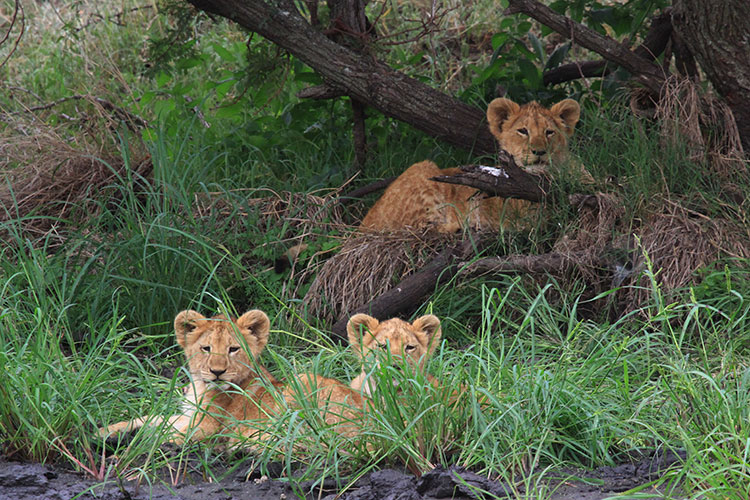
1. Lion cubs
Lionesses will give birth to a litter of one – four cubs and we were lucky to find this litter of four (though you can only spot three in the photo).
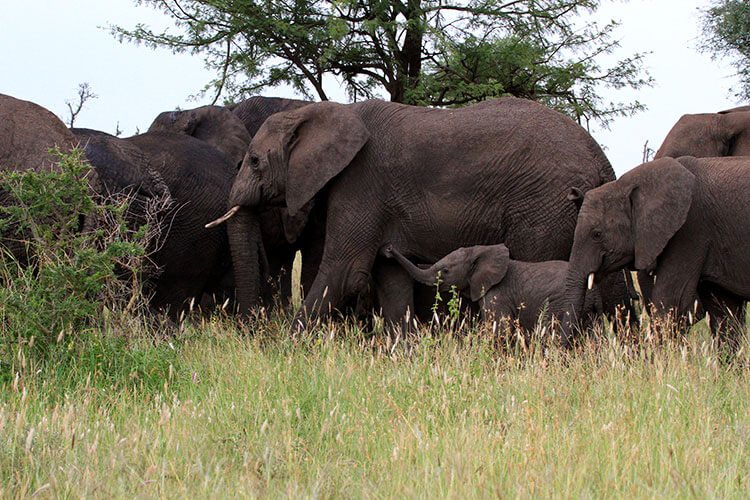
2. Elephant calf
Elephants only get pregnant once about every five years and the gestation period is 22 months. Elephant calves are quite small! Our guides estimated this cutie was around eight or nine months old.
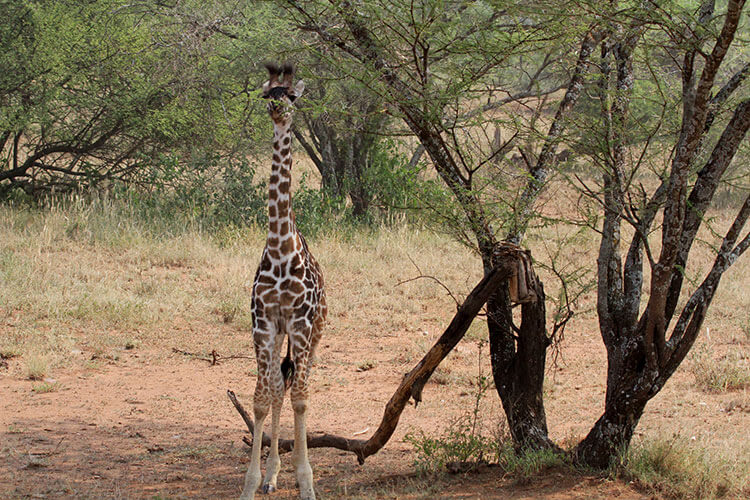
3. Giraffe calf
Giraffe calves are born already around six feet tall! Though after seeing full grown giraffes, it’s pretty easy to spot a youngster even when they’re on their own. Sadly, we learned that giraffes aren’t very good parents and will leave their babies own their own while traveling several kilometers away.
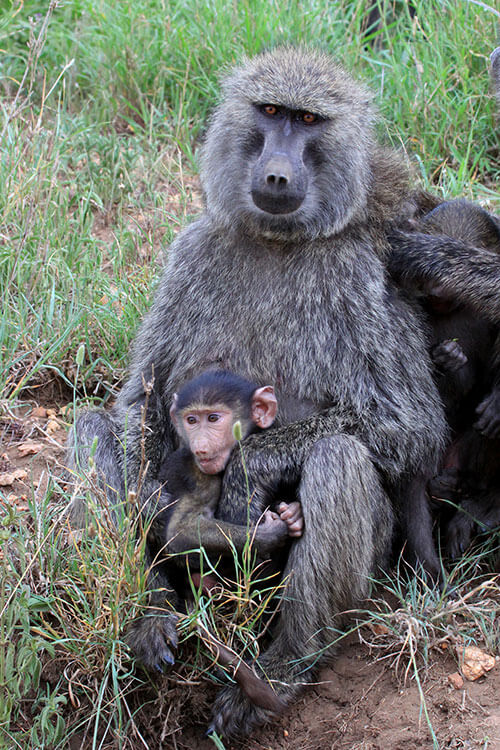
4. Baboon infant
Baboon infants hang on to their mother’s stomach for the first month and then at five or six weeks old, start riding on their mother’s back. This cute little fella (boy parts definitely indicated he was a fella) was less than a month old! We were lucky to spot him playing very close to the road, though he scampered over to hold on to mom as soon as we stopped.
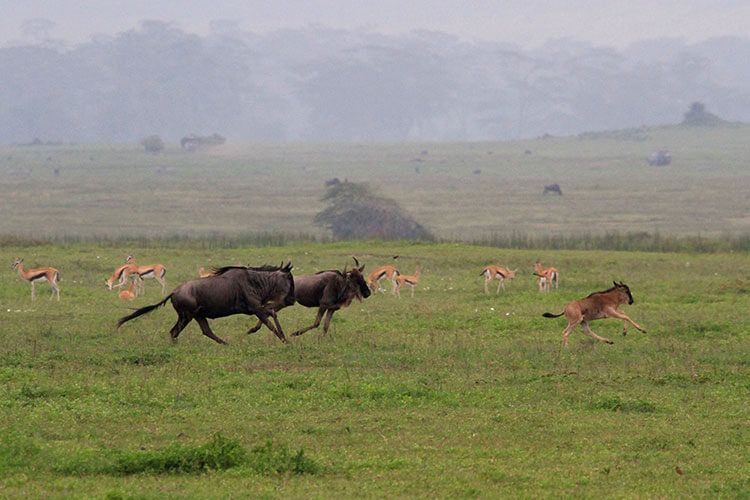
5. Wildebeest calf
Wildebeest calves can stand within just a few minutes of being born and can run with the herd within an hour after birth. We saw a few young calves as the Great Migration moved from the Serengeti Plains south to Ngorongoro Crater, where the wildebeest will birth their calves in the short grass plains.
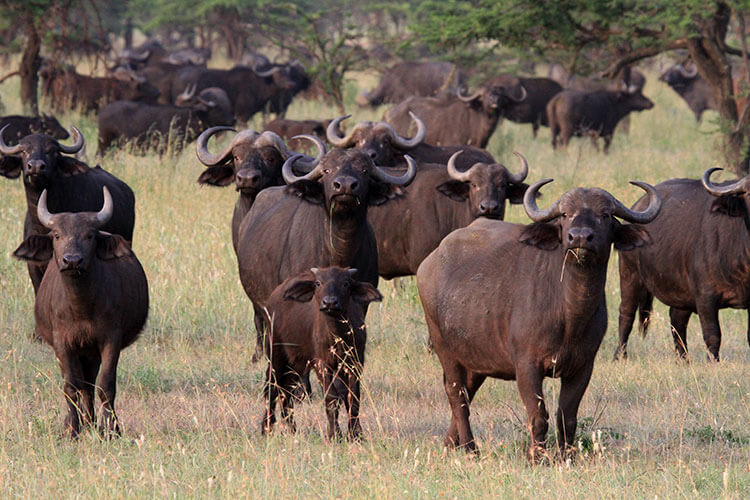
6. Cape buffalo calf
Cape buffalo calves are completely dependent on their mothers for their first year. The females will stay with and join the natural herd. We saw mostly male herds, but did spot some calves in a female herd we came across.
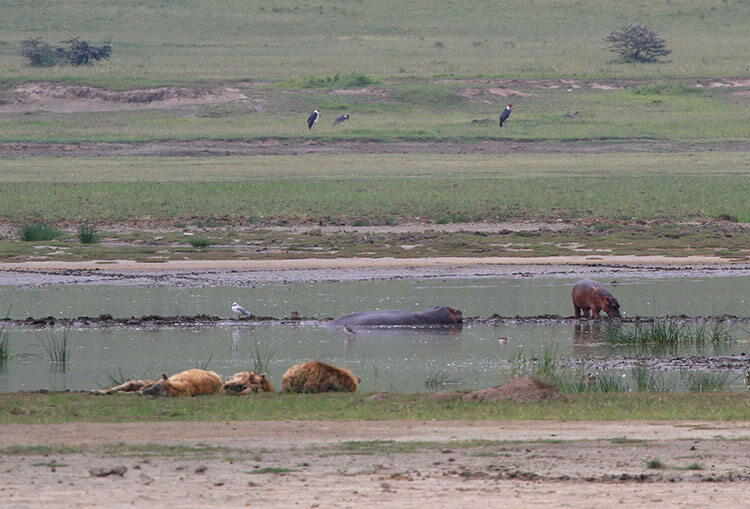
7. Hippo calf
Hippo calves are born in the water and can hold their breath for nearly three times as long as an adult hippo. Hippos spend around 16 hours each day in the water, so babies are a little hard to spot. We got lucky to spot a baby out of the water at Ngorongoro Crater.

8. Warthog piglet
Warthog moms only have four teats and piglets each suckle from their “own”. No sharing! When warthogs run, their tail sticks straight up and the piglets run in a line behind mom. Though I hope they weren’t running from a predator, they are too cute in running mode.
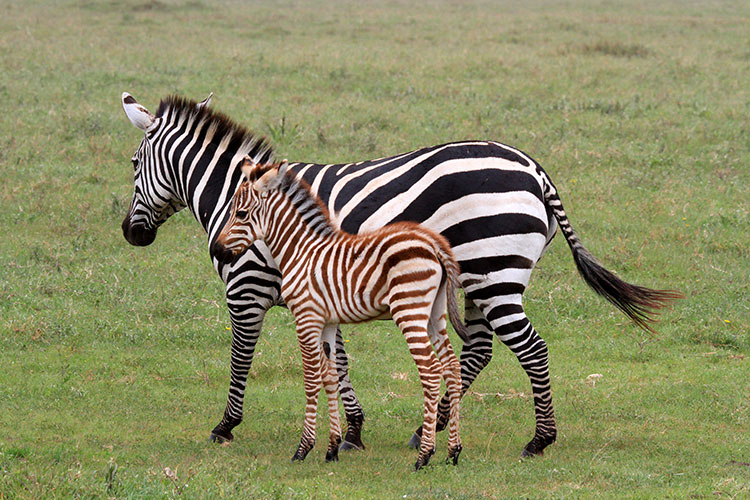
9. Zebra foal
Zebra foals are actually born brown and white and with a thicker coat. They look fuzzy, which makes them all the more adorable. Like wildebeest, zebras have their babies just before the long rains begin in February. We saw quite a few baby zebras at Ngorongoro Crater.
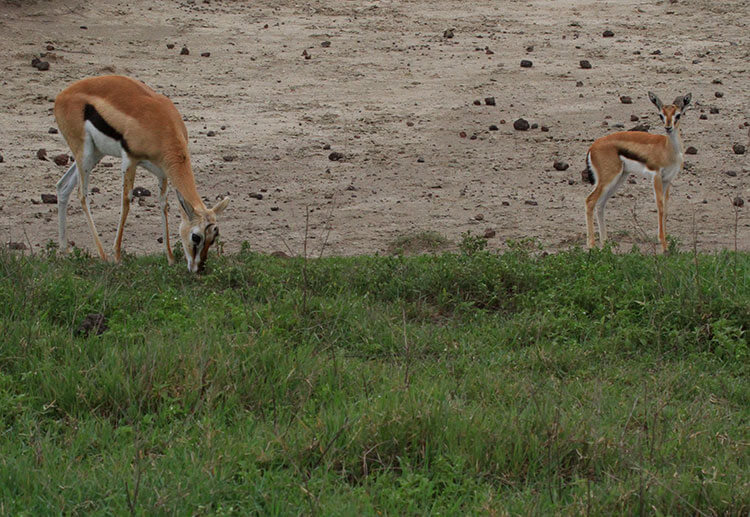
10. Thompson gazelle fawn
Thompson gazelles are really small with an adult standing at only around 2 – 3 feet tall. Females move away from the herd to birth a single fawn and the fawn will spend most of its time resting and hiding in the grass. It’s not very common to spot a fawn, so we were particularly lucky to see this little fawn with its mom on the short grass plains at Ngorongoro Crater during the Great Migration.

Hyrax live in families of up to 50 and are sort of look like a rabbit without long ears and cotton tails that can climb. The babies all snuggle up with mom when they nap and we were quite amused watching the resident hyrax families at Serengeti Migration Camp.
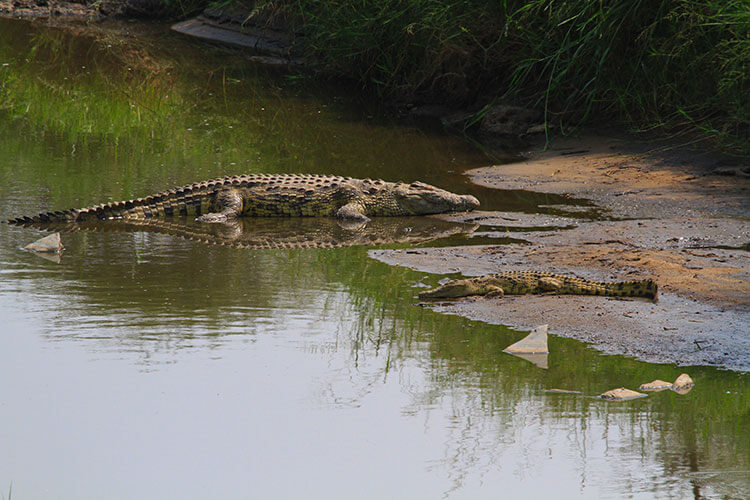
12. Crocodile hatchling
Crocodiles lay around 50 eggs and bury them in the sand on the riverbank. Of the 50 eggs, only one or two hatchlings actually survive. This little guy was sunning himself right next to mom in the Serengeti.

13. Monkey infant
Like baboons, monkey infants clutch their arms around mom and hitch a ride on their belly. Because the mom and dad are so protective of their youngsters, baby monkeys can be hard to spot. Like all kids, they like to play and you might spot them chasing each other around. As soon as the parents spot you watching though, they grab up their babies and hold on to them protectively.
Loved this post? We love when you share our content! ~ Jen & Tim
About Jennifer Dombrowski
Jennifer Dombrowski is an independent travel publisher and an American expat who has lived in Bordeaux, France since 2016. She previously lived in Northern Italy in a small village near Venice for seven years where she fell in love with wine and wine tourism. She is an award-winning travel writer. She is also a travel correspondent on Traveling on the American Forces Radio Network. Luxe Adventure Traveler was named one of the top travel blogs to watch by the Huffington Post and TripAdvisor, and has been featured by top publications such as National Geographic, CNN, Buzzfeed, and Business Insider. Jennifer's photography has also been featured on publications such as USA Today and Travel + Leisure and on the Travel Channel.
February 25, 2014 at 1:38 PM
Wow, amazing photos! Sounds like you both got lucky in catching sight of some of those li’l guys and gals. Can’t wait to see what you’ve got in store for your next few posts 😉
Jennifer Dombrowski says
February 27, 2014 at 11:19 AM
Though it was going into the long rains when we were there, we had pretty good weather and it was the perfect time of the year to see the babies. So cute to watch!
Lauren Bassart says
February 25, 2014 at 3:22 PM
This was just about the cutest post ever!!! Love all the babies. So jealous of you guys 🙂
February 27, 2014 at 11:20 AM
Thanks Lauren! At first we were just shooting the babies, but then we specifically started trying to capture a mom and wee one. Just so much cuteness!
February 25, 2014 at 3:57 PM
After getting hit with one Polar Vortex after another in the U.S, it’s nice to see signs of Spring with all the young animals being born. Nice photos.
February 27, 2014 at 11:21 AM
Even though we were just a few degrees below the Equator, it was definitely a different season there in Tanzania! Kind of disappointing to come back home to the winter rain in Italy after getting a taste of “Spring”.
Shikha (whywasteannualleave) says
February 25, 2014 at 4:42 PM
When I went on safari in Selous Tanzania for honeymoon, the lion cubs were playing hide and seek so I’d love to try and catch them next time – I absolutely loved baby hippos though – so cute!
February 27, 2014 at 11:23 AM
What a fantastic place to go on honeymoon Shikha! Lions don’t have a specific time of the year that they breed, so you have a pretty good chance of seeing lion cubs any time of the year. Hope you spot some on your next safari!
February 25, 2014 at 4:45 PM
Even the baby croc is cute!
February 27, 2014 at 11:25 AM
I still wouldn’t mess with even the baby croc. We’ve got a close up and it already has some lethal looking teeth.
Adam Evans says
February 25, 2014 at 5:34 PM
I love the zebra and foal. Interesting to see the foal has a kind of ginger hue!
February 27, 2014 at 11:27 AM
We were surprised that baby zebras are so brown too. Very cute. The coat almost looks like a thick fuzz or velvet.
Katherine Belarmino says
February 25, 2014 at 7:22 PM
That giraffe baby is ridiculous!!
February 27, 2014 at 11:29 AM
Isn’t it so cute? It’s parents were no where around. I can only hope it survives on its own.
February 26, 2014 at 12:24 AM
Wow, that’s impressive you did get all the big ones and small ones to…what a fun trip, must have taken lots of great images to share!
We averaged anywhere from 600 – 1000 photos each day. I think I could post a safari photo a day for the next year!
Kate Blake says
February 26, 2014 at 1:20 AM
Amazing pics! I love the baby hippo
February 27, 2014 at 11:32 AM
The hippos were so funny! They make the best noises that just make you smile.
Lauren says
February 26, 2014 at 1:29 AM
Those are so cute! The babies look like miniature versions of the adult ones. I really like the zebra and the lion cubs, although they are all very adorable 🙂 Your photos are very impressive!
February 27, 2014 at 11:35 AM
Thanks Lauren! The babies are just so adorable to see and I loved watching them interact with their moms.
Alouise says
February 26, 2014 at 1:35 AM
This post if full of some serious awww. I love the one of the baby elephant.
February 27, 2014 at 11:38 AM
That baby elephant had to be the happiest elephant I’ve ever seen! Elephants were definitely a favorite to watch, especially when they play in water holes. We’ll have a post coming on a herd having some serious fun in a water hole.
jenny@atasteoftravel says
February 26, 2014 at 2:30 AM
So cute! You were definitely there at the right time for the babies. Can’t wait to read about your adventures!
February 27, 2014 at 11:39 AM
Yes Jenny! I was a little disappointed that we never got the a blazing fiery African sunset, but it’s hard to be too disappointed when we got to see all these wee ones.
Heather says
February 26, 2014 at 4:15 AM
What a treat! Even the baby crocodile is cute!
February 27, 2014 at 11:42 AM
The babies are just too cute to watch! Even the baboon baby melted my heart. I had a bad experience with baboons at the zoo when I was a kid, so don’t really like them.
February 26, 2014 at 8:43 PM
ohhhh yes, they’re really cute 🙂 I’m happy you had such a great time!
February 27, 2014 at 11:43 AM
Definitely one of our favorite trips we’ve been on Stef!
Angela Travels says
February 27, 2014 at 12:00 AM
Love the photos. I really want to go on an African Safari photo tour!
February 27, 2014 at 10:40 PM
You will love going on safari Angela! We’re barely home from this safari and now I am absolutely dying to go to Kenya, South Africa, Zambia, Botswana, and Namibia!
Samantha @mytanfeet says
February 27, 2014 at 3:51 AM
the baby zebra is adorable!! I had no idea they were born fuzzy and born, every animal is so cute when miniature size, even the crocodile. Great pics!
February 27, 2014 at 10:45 PM
Thanks Samantha! Yes the wee ones are just too adorable. I think even a baby hyena might be cute.
February 27, 2014 at 4:40 AM
Oh Mahh gahhd. All of them. Yes please. Can’t wait to do a safari. Not on this RTW trip but the next for sure. Thanks for sharing.
You will love it when you do go on safari, Shaun! This was one of our all time favorite trips.
February 27, 2014 at 3:50 PM
Awwwwm this post is the perfect thing for a Thursday afternoon… or for any afternoon 🙂
February 27, 2014 at 10:46 PM
Hard to feel blue with so much cuteness to look at here!
February 28, 2014 at 9:57 AM
The Zebra, the giraffe! I had to come back and have a look this morning!
February 27, 2014 at 5:51 PM
Nice pics – never heard of a Hyrax! Interesting looking animal. Frank (bbqboy)
February 27, 2014 at 10:48 PM
We’d never heard of one until about two weeks ago either, Frank. They’re pretty cute!
Devlin @ Marginal Boundaries says
February 28, 2014 at 8:43 PM
Those Hyrax are deviously cute, they just look like they’re up to no good, hatching some plan to steal your treats.
March 1, 2014 at 2:59 PM
LOL! We had a family of them that just loved to sun themselves on the wooden platform surrounding our tent.
Cheryl Howard says
March 3, 2014 at 12:14 AM
Awww, each and every photo is so so cute! 🙂
March 5, 2014 at 8:04 AM
Oh how I would love to go on safari! It would be even better to get to see all these baby animals. They’re all so cute, especially the Hyrax!
Leave a Reply Cancel reply
Your email address will not be published. Required fields are marked *
Notify me of follow-up comments by email.
Notify me of new posts by email.
This site uses Akismet to reduce spam. Learn how your comment data is processed .
Protect Your Trip »
12 Top African Safari Tours
Cross this must-do activity off your bucket list.

Courtesy of Micato Safaris
Spot the big five on your safari adventure.
Safari tours in Africa are just as diverse as the continent itself, though these types of trips typically require a large sum of money. Whether you want to spend a few days gorilla trekking in Uganda or a couple weeks spotting the "big five" – lions, leopards, African elephants, rhinos and Cape buffalos – in South Africa, you'll find an array of tours to best suit your needs. To help you narrow down your options, U.S. News compiled a list of 12 can't-miss African safari tours. Read on to find your once-in-a-lifetime trip.
Note: Some of the African countries in this article may require travelers to get an entry visa and certain vaccinations in order to visit. Jump to the list of visa and vaccination requirements by country at the bottom of this page for more information.
&Beyond

Courtesy of &Beyond
Visitors who don't want to sacrifice creature comforts while on safari will appreciate &Beyond's offerings. During the tour operator's 10-day Kings of the Jungle safari – which starts at $11,340 per person – travelers will see breathtaking natural wonders like the Ngorongoro Crater and the Maasai Mara savanna. But the highlight of this journey is its four-night stay at Tanzania's Serengeti National Park . After watching animals like wildebeest and zebras partake in the great migration while also spotting lions, giraffes and more, vacationers retreat to high-end tents and lodges with private bathrooms.
[See more of Serengeti National Park: Things to Do | Hotels | When to Visit | Photos ]
Wilderness Safaris

Courtesy of Wilderness Safaris
For some of Africa's most jaw-dropping scenery, opt for the seven-night Namibian Adventure Safari tour offered by Wilderness Safaris. This weeklong trip features visits to the Namib Desert's dune-filled Sossusvlei region (which you may recognize from the film "Mad Max: Fury Road") and the mountainous Palmwag Concession – a protected area with springboks, giraffes, black rhinos and more. The package's per person fee starts at $6,725, which covers most meals, park entrance fees, and transfers from Namibia's capital Windhoek and between the safari destinations. It also covers your stay at properties like the fully solar-powered Hoanib Skeleton Coast Camp and the five-star Little Kulala lodge amid the stunning desert.
Wild Rwanda Safaris

Courtesy of Wild Rwanda Safaris)
Adventurous travelers sticking to a more conservative budget should consider Wild Rwanda Safaris' Bwindi Gorilla Safari. The three-day package features a full day in southwestern Uganda's Bwindi Impenetrable National Park (a haven for silverback gorillas) and an adjacent Batwa Pygmy community. Wild Rwanda Safaris allows guests to choose between midrange, luxury and super luxury accommodation, which can help keep costs down if necessary. The company's packages include the $700 permit required to visit the gorilla park. The round-trip journey by safari vehicle to and from Kigali, Rwanda, and English-speaking guide services are also covered in all rates. The tour can begin from Kampala, Uganda, as well, although you'll spend longer on the road to the park.
Nomad Tanzania

Courtesy of nomad-tanzania.com
Sign up for Nomad Tanzania's Southern Tanzania safari and you're bound to get an up-close look at Tanzania's diverse wildlife. Offering eight days of activities, including game drives and boat trips in Ruaha National Park and Nyerere National Park, this safari gives you prime opportunities to spot lions, cheetahs, leopards and elephants, among other species. What's more, lodging at the company's campsites, select meals, and flights to and from Dar es Salaam are factored into the package's prices. Expect to pay a minimum of $5,700 per person; prices vary depending on the time of year, and the tour isn't offered in April and May.
Micato Safaris

If you want to explore multiple destinations while on safari with plenty of comfort (but a price tag to match), book the 15-day Micato Grand Safari. This outing by Micato Safaris starts with a two-day visit to Nairobi, Kenya, before continuing to the Lewa Wildlife Conservancy, Maasai Mara National Reserve, and the Amboseli and Serengeti national parks for wildlife-viewing excursions. During your trip, you'll see Mount Kilimanjaro as zebras, gazelles and more roam in the foreground. The package costs at least $22,450 per person (based on double occupancy rates) and includes a hot air balloon ride, a camel tour led by members of the Samburu tribe, and lodging at upscale properties like Serengeti's Four Seasons outpost. The company also offers various extensions allowing you to explore other parts of Africa, from the island paradise of Zanzibar to the deserts of Namibia.
Rothschild Safaris

Courtesy of Rothschild Safaris
If your ideal safari vacation consists of customizing your trip from start to finish, consider an outing with Rothschild Safaris. The company offers itineraries in locales like Zambia and Madagascar , but if you're hoping to catch a glimpse of the big five animals, the Essence of Tanzania safari is a good bet. This nine-day experience, which embarks from Arusha and returns there by plane, includes game-viewing drives in Tarangire National Park and accommodations like canvas tents and farmhouse lodges. Elephants, zebras and lions are just some of the animals you may spot during your journey. You'll also have the opportunity to go on a nighttime safari to spot nocturnal wildlife.
Lion World Travel

Courtesy of Lion World Travel
As the trip name implies, Lion World Travel's 10-day Best of Cape Town & Botswana vacation package combines sightseeing in Cape Town, South Africa , with a classic safari in Botswana. During the latter half of the itinerary, visitors will explore Botswana's Okavango Delta (home to cheetahs, crocodiles, hippos and more) and Chobe National Park, which is believed to have Africa's largest elephant population. Prices start at $4,299 per person and cover game drives; many of your meals; and stays at luxury hotels, camps and lodges. You'll need to pay an extra charge for the flights within the tour (Cape Town to Botswana as well as Botswana to Johannesburg ).
[See more of Cape Town: Things to Do | Hotels | When to Visit | Photos ]
Bearded Heron Safaris

Neil Heron | Courtesy of Bearded Heron Safaris
Travelers keen on seeing South Africa's Kruger National Park through the eyes of a local naturalist will appreciate the 15-day safari with Bearded Heron Safaris. Led by Neil Heron, a nature guide and wildlife photographer and writer, Bearded Heron Safaris' longest option features small game drives that may include lion, rhino, zebra and leopard sightings throughout all corners of Kruger. Rates are inclusive of in-park cottage accommodations and all breakfasts, dinners, snacks and drinks. Flights and park fees are not included. For a 15-day safari, expect to pay 76,900 South African rand (about $4,500) per person.
[See more of Kruger National Park: Things to Do | Hotels | When to Visit | Photos ]
Discover Africa

Getty Images
For an inside-out trip through the natural wonders of Botswana, Discover Africa's nine-day Epic Botswana Adventure is a formidable option. You'll start out at a riverside lodge on the Chobe River – a great location for elephant spotting – before moving onto the marshy Okavango Delta, a wildlife-rich area where you can spot a huge range of animals from leopards to rhinos. The safari ends at the Makgadikgadi Pans National Park, a good place to admire wildlife like zebras and buffalo on the savanna as well as salt pans from a former lake. You'll stay in upscale lodges and campsites within close reach of the wilderness. All meals and transport along the tour are included in the price tag (which starts at $4,800 per person), but international flights are excluded.
Wild Wings Safaris

If you're looking to have a broader experience that mixes in some history and beach time, consider Wild Wings Safaris' eight-day Battlefields, Bush and Beach Safari. You'll start off visiting some of South Africa's historic sites from the Boer wars, before moving on to the Phinda Private Game Reserve, which doesn't allow day visitors, so you should be able to look out for the big five without too many crowds. The tour wraps up at Thonga Beach Lodge, where you can snorkel or scuba dive near coral reefs in the Indian Ocean. As far as safaris go, this one is an affordable option, starting at about $2,795 per person with all meals included as well as a rental car; for the cheapest price, you will need to drive yourself between the destinations, but it's possible to pay an additional fee for a driver to guide you instead.
Cuckoo Safaris

This tour company kicks off its tours from the majestic Victoria Falls in Zimbabwe, with a host of safaris that range from two days to nine, across Zimbabwe, Zambia and Botswana, including some family-friendly choices. For an affordable option, there's the four-day Discover Victoria Falls, Chobe and Hwange Park safari, which will take you on two full-day tours to Chobe National Park (across the border in Botswana) and to Hwange, Zimbabwe's largest national park, where you should keep your eyes peeled for lions, elephants and more. This safari also includes a sunset cruise on the Zambezi River. The price starts at $900 per person, which includes the tours plus breakfast, lunch and lodging in Victoria Falls; travelers will need to pay for entrance fees to the parks and dinner.
Compass Odyssey

Courtesy of Compass Odyssey
Explore the savanna and deserts of southwest Africa with Compass Odyssey's eight-day Namibia Wildlife Safari. You'll visit a community-based conservation area in Damaraland – known for its desert-adapted elephants, oryx, giraffes and other wildlife – while staying in the rustic-chic Doro Nawas Camp. You'll also spend two days in Etosha National Park, seeking wildlife at the park's bustling waterholes by day and embarking on an evening game drive as well. Starting at $3,750 per person, the tour includes most meals and all park entry fees, but not flights; the company does allow the tour to be customized on request.
Vaccination and visa requirements for African countries
Some popular safari destinations may require you to have received certain vaccinations in order to enter the country as a tourist. Inoculation requirements can include vaccination against COVID-19 and yellow fever, and you'll need to get these vaccines before departing on your trip. Be sure to bring proof of vaccinations with you. If you are transiting through another country en route to your safari tour, you must check that you also meet immunization requirements for the stopover location.
Note that, outside of what's required, there are a number of other vaccinations that are recommended, so ensure you're up to date and fully protected before you travel. In addition, many safari locations are prone to malaria; you should consult with your doctor to see if you need to bring anti-malaria medication on your trip.
Safari countries have varying visa requirements for travelers from the U.S. – these are detailed below. Depending on your itinerary, you may need a single- or multiple-entry visa, and some visas require you to apply in advance of traveling and/or have a certain number of blank pages in your passport. Regardless of your destination, your passport should be valid for at least six months before you leave for your trip.
Here are the vaccine and visa requirements for major safari destinations as of November 2022:
Botswana: If you have recently visited a country where yellow fever is common, you will need to be vaccinated against this illness. This does not include the U.S. but does include a number of countries in Africa, Central and South America. Consult the World Health Organization's website for a list of countries with risk of yellow fever transmission, including Kenya and Uganda.
U.S. citizens and nationals can stay in Botswana for 90 days without a visa.
Kenya: Travelers to Kenya must have been vaccinated against COVID-19 with the last shot administered more than 14 days before arrival in the country. Unvaccinated visitors can enter with a negative PCR test, conducted no more than 72 hours before departure. Proof of COVID-19 tests or vaccines must be uploaded to an online system called Panabios. Kenya is a country where you'll be at risk of yellow fever transmission; it also requires those traveling from other places with yellow fever or cholera outbreaks to be vaccinated against these illnesses. The Centers for Disease Control and Prevention recommends that you protect yourself against yellow fever before your trip here.
Americans need an e-visa to enter Kenya. You should apply online at the eVisa government website no more than eight weeks before your trip, as visas are not available upon arrival in Kenya. See more on the U.S. Department of State's website .
Namibia: Those traveling from a country where yellow fever is common need to be vaccinated against it. No visa is required as long as you're staying for 90 days or less.
Rwanda: If you're coming from a country where yellow fever is endemic, a yellow fever vaccination is required before departure.
U.S. citizens and nationals can be issued a 30-day visitor visa on arrival in Rwanda or through the Rwandan Embassy in Washington, D.C. A single-entry visa costs $50, and it's recommended you bring sufficient cash in U.S. dollars to pay for this (although credit card payment may be accepted at Kigali International Airport). Consult the State Department website for more information.
South Africa: A yellow fever vaccination is required if you're traveling from a country with a risk of transmission. No visa is required for stays of 90 days or less.
Tanzania: Travelers must be able to present proof of COVID-19 vaccination with a QR code to enter Tanzania. Unvaccinated travelers must take a PCR test no more than 72 hours before departure, and the test results should be accessible by QR code. Yellow fever vaccines are mandatory if you're traveling from a location where yellow fever is present – including if you spend more than 12 hours in transit in such a country.
Visas are required for tourism in Tanzania. You can apply for a single-entry, 90-day visa online for $50 – and be sure to print a copy of the approval to bring with you. The processing period takes up to 10 days. You can also obtain a visa on arrival for a $100 fee; it's recommended you bring cash to cover this. Find more Tanzanian visa information on the State Department website .
Uganda: To enter Uganda, you must either be fully vaccinated against COVID-19 or present a negative test taken no more than 72 hours before departure. Like Kenya, Uganda is a country with risk of yellow fever transmission. All visitors must show proof of vaccination against yellow fever to enter Uganda, regardless of where you're traveling from.
American visitors to Uganda must apply online for an electronic visa before departure; arriving in Uganda without completing this process could result in your detainment. Visit the State Department website to learn more.
Zambia: Visitors who are fully vaccinated against COVID-19 must show proof of vaccination but do not need a test to enter Zambia; unvaccinated travelers must undergo a PCR test no more than 72 hours before departure. Yellow fever vaccines are only required if you're coming from an area considered at risk.
Visas are required to visit Zambia, but these can be obtained online before your departure or at a port of entry. Check the State Department website for more details.
Zimbabwe: To enter Zimbabwe, travelers must either be fully vaccinated against COVID-19 or must take a negative PCR test no more than 48 hours before your departure. As with other countries on this list, visitors from countries with yellow fever outbreaks also require a vaccine against this illness.
U.S. visitors can obtain a 30-day, single-entry visa upon arrival in Zimbabwe for $30. If you're taking a tour that requires you to leave and reenter Zimbabwe, be sure to get a double-entry visa for $45. You can learn more from the State Department website .
You might also be interested in:
- The Top Passport Wallets (That Also Hold Vaccine Cards)
- The Best COVID-19 Travel Insurance Options
- The Best International Travel Insurance Plans
- The Best Zoos in the U.S.
- The World's Best Places to Visit
Tags: Travel , Vacation Ideas
World's Best Places To Visit
- # 1 South Island, New Zealand
- # 4 Bora Bora
If you make a purchase from our site, we may earn a commission. This does not affect the quality or independence of our editorial content.
You May Also Like
The best whale watching in santa barbara.
John Rodwan May 29, 2024

The Best Travel Purses
Rachael Hood May 24, 2024

The Best Beach Games
Gwen Pratesi May 24, 2024

The Best Branson Shows
Carrie A. Back May 23, 2024

The Best Beach Toys for Kids
Amanda Norcross May 23, 2024

The Best Charleston Tours
John Rodwan May 23, 2024

The Best Savannah Tours
John Rodwan and Ann Henson May 23, 2024

The Best NYC Dinner Cruises
Jessica Colley Clarke May 23, 2024

The Best Cooler Bags
Sharael Kolberg May 22, 2024

The Best Beach Blankets
Gwen Pratesi and Sharael Kolberg May 22, 2024

2024 Season
Open daily may 4 – september 15 & select dates september 18 – october 13.
Misumu Bay Wetplay is open May 18 – September 2, 2024.
We look forward to seeing you “On Safari!™”
Acknowledgement
- All persons entering the property, grounds, facilities and drive through Game Reserves do so entirely at their own risk and choose to do so under these conditions. No liability for loss, injury or damage will be accepted. All visitors must enter via the Ticket Booth entrance and pay the entrance fee.
- African Lion Safari has a no refund, no exchange policy.
- No refunds or rain passes provided due to inclement weather. Some park features/tours/rides/presentations may close temporarily during severe weather conditions. As soon as conditions permit safe operation, these features will re-open. All ticket sales are final.
- African Lion Safari reserves the right to change animal displays without notice. During cold periods some species may not be on display. Hours of operation, tours, presentations and prices are subject to change without notice.
- Vehicles with cracked windows, convertibles, soft tops, and soft tire covers are NOT permitted in drive through Game Reserves. Please check the vehicles restrictions on our website.
- Soft pickup truck bed covers are NOT permitted in the drive through Game Reserves. All pickup truck beds must be empty and clear of debris. Vehicles permitted into the Game Reserves are inspected upon entry. Entry is subject to the discretion of African Lion Safari® personnel. Storage units available behind Main Office. Locks available at Ticket Booth or Main Office.
- No Pets Permitted on Property – To ensure the health and safety of our visitors, pets, our animals and other guests, African Lion Safari does not permit pets of any kind on its property or in the drive through Game Reserves. Kennels are available behind the Main Office. Service animals are welcome on property, however restrictions apply.
- Photography & Filming Policy – All photographs, images and/or video, in any format, taken by guests of 1) African Lion Safari’s property, premises and 2) birds and animals must be for personal use only. Any use, reuse or reproduction for commercial purposes is prohibited by African Lion Safari without full written consent and specific license from African Lion Safari.
- Consumer Image Policy and Guest Awareness: During your visit, you may be filmed, taped or photographed by or on behalf of African Lion Safari. Your admission to the park serves as your permission to use, record, reproduce, broadcast, sell and distribute any of the above.
2024 Admission Prices
Online admissions, gate admissions, 2024 season passports, important passport information.

The TRUTH about doing an African safari with kids
Posted on Last updated: 6 March 2024
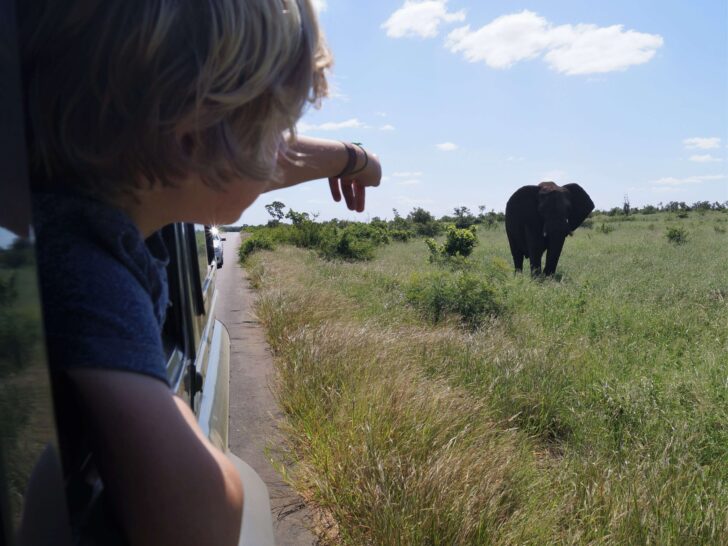
The African safari is perceived as one of life’s ultimate travel experiences. One that children won’t appreciate until they’re older, and too expensive for families. Plus aren’t there those stories about children being eaten by hungry wildlife on safari? Surely doing an African Safari with kids is irresponsible and pointless.
I hear things like this ALL THE TIME, and not surprisingly, after our 101 days self driving Africa with kids aged 2 and 4 years I don’t agree with a lot of these comments.
So lets debunk these crazy myths and share the truth about doing an African Safari with kids.
Join our ‘ Travel Africa with kids ‘ Facebook Group
The Lonely Planet Africa , and the Tracks4Africa Africa Southern Traveller’s Atlas were invaluable throughout our travels.

- Ham, Anthony (Author)
- English (Publication Language)
- 1120 Pages – 11/10/2017 (Publication Date) – Lonely Planet (Publisher)

- Tracks4Africa (Author)
- 142 Pages – 06/13/2017 (Publication Date) – Tracks4Africa (Publisher)
You can’t take young kids on an African safari
Yes this is true to some extent. Most organised game drives have a minimum age of 6, and there are a handful National Parks in Africa have an age restriction for entry.
But it’s free entry in many National Parks for kids under 6 if you are self-driving (ie. not going on a group tour). Self-drive is definitely the best way to do an African safari with kids as you can be flexible to your own schedule. If your little one needs a wee, well either drive to a designated rest stop, or get creative with a travel potty or bottle in your vehicle. Plus you can be armed with lots of snacks and not worry about disturbing other travellers whilst they munch on their biscuits.
This does mean that you don’t have a guide to find the wildlife for you, but we found out that we did pretty well without one.
Check out our tips for doing a safari with young kids .
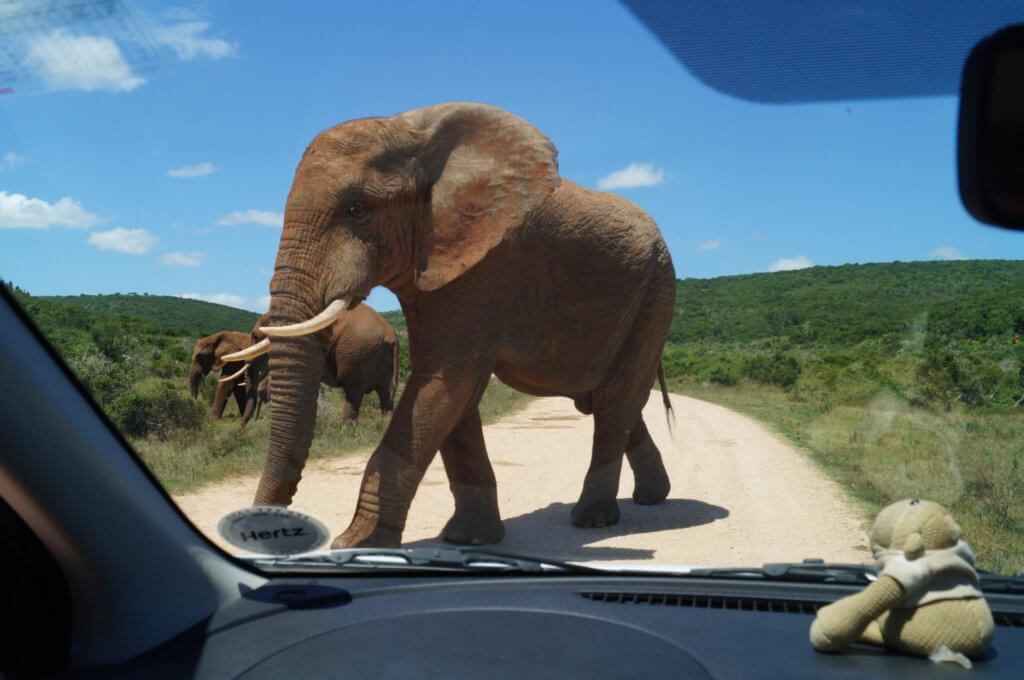
You can also pay to do a private game drive at most National Parks. Although this can be expensive, you are leaving the searching for wildlife up to an experienced guide.
Doing an African safari as a family is expensive
Yes it certainly can be. The fees for some of the East African parks are extortionate and was the reason we decided NOT to visit the Serengeti when travelling Tanzania with kids .
However, parks in Namibia and South Africa are MUCH more affordable. For instance in Etosha , Namibia, day entry for foreign adults is N$150 (£6.25), then N$50 per standard vehicle (£2) and children under 16 are FREE! Kruger in South Africa is also very good value. Check out our post which weighs up whether Kruger or Etosha is best .
There are then the extra costs of flights, car hire, visas and vaccinations. These can all add up. But the safari itself doesn’t have to be expensive and if you are planning an African family holiday, it’s likely that you will want to explore other aspects of a country, not just the safari.
It’s too dangerous to do an African safari with kids
Did you hear about the leopard that snatched and ate a toddler in Uganda? Read the Telegraph article here . A horrendously tragic story, which was unfortunately timed with our overland travels in Africa and plagued our families with worry.
However, this story and a few others like it are very few and far between. Millions of people visit Africa every year to go on safari, and have a safe and problem free visit. Where there have been incidents, it is usually because the animals have felt threatened.
Respect the space of wildlife you encounter. Keep your distance, especially if there are mothers with babies in a herd. If you are near lions or leopards, keep windows shut. Always stay on marked roads, and only get out of your car at designated rest stops.
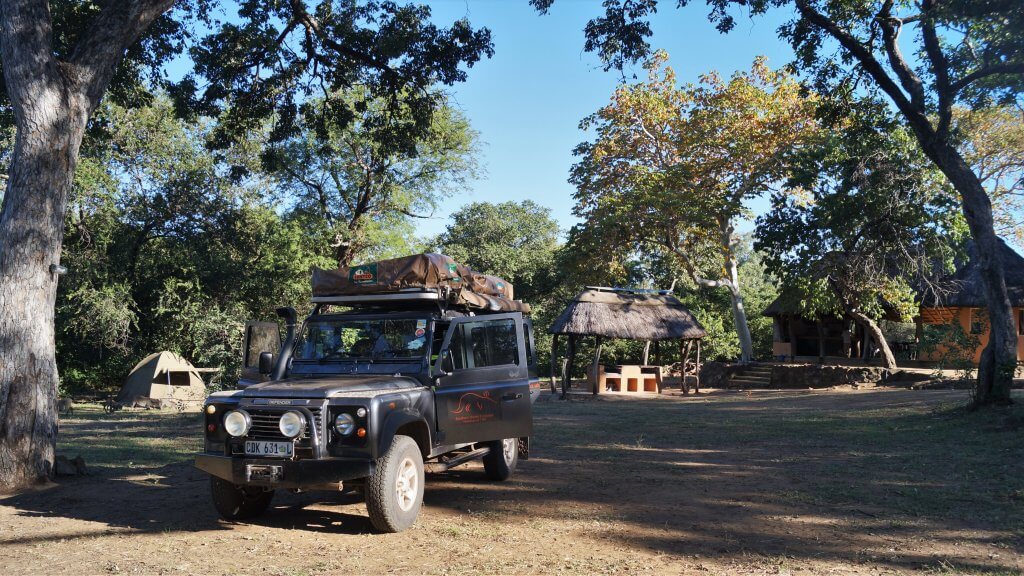
We chose to only stay at campsites in National Parks that were guarded or fenced. If it didn’t look safe, we left. This happened when we arrived at Ruaha National Park in Tanzania . There were a family of elephants in the campsite, no guard and no fence. With our boys being so young, we didn’t deem it safe and moved on. Use your common sense.
If you are venturing deep into the bush on dirt or sand tracks, consider taking a satellite phone with you. And always ensure you have enough food and water inside your vehicle.
You have to drive a 4×4 on dirt tracks
There are a handful of parks where you do not need a 4×4. Kruger National Park and Addo National Park, both in South Africa have tarred roads, and the salt roads around Etosha National Park in Namibia are very easy for a 2WD.
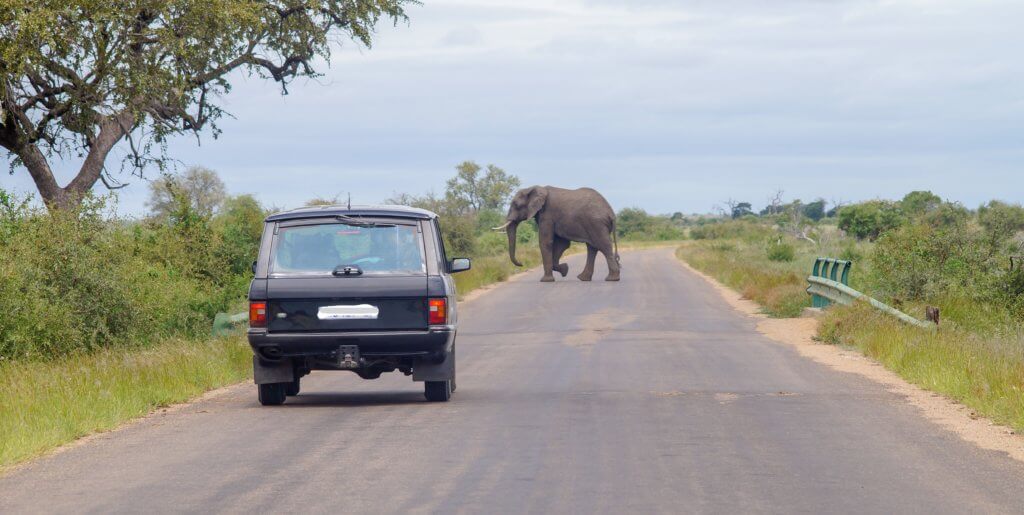
It’s not fair taking kids into a malaria zone
This is an understandable concern. Why take your kids to a malaria zone, especially little ones?
Well Etosha National Park in Namibia in one place where antimalarials aren’t required. It is technically in the ‘ malaria zone ‘. But if visiting in the dry season, mosquitoes are unable to breed as the land is so parched.
However, we did take our boys into a malaria zone, and so we gave them antimalaria tablets. Please DO NOT go into a malaria zone without them. Covering up with long sleeves and trousers, sleeping under a mossie net, and being liberal with mosquito repellent will deter mosquitoes, but these efforts DO NOT prevent malaria.
We all take antimalarials if visiting an malaria zone. You can check this on the NHS Fit For Travel website . We experienced no side-effects whatsoever, and our kids never knew they were taking them as we crushed the tablets in with a spoonful of Nutella and served on a biscuit.
Do consult a travel clinic (not your GP) for up to date advice on malaria and travel vaccinations required.
My kids will get bored
Yes they may do. It can be a long time between wildlife sightings.
If you are doing an African safari with kids under the age of 6, plan for just 3 hour game drives at a time. No more. Point out the detail in everything, and look for poo (this leads to LOTS of discussions about where animals could be and what they’ve eaten). We also look to stay at campsites in the national parks that have a swimming pool, which always makes for a good afternoon activity. You can stretch the length of game drives depending on the age of your kids.
Also, we found that 48 hours (spread over three days) is the maximum length of time you really want to be in a national park with kids.
However, we found that boredom rarely struck. Our boys absolutely loved their African safaris and have a strong affinity to the land and wildlife of Africa because of these experiences.
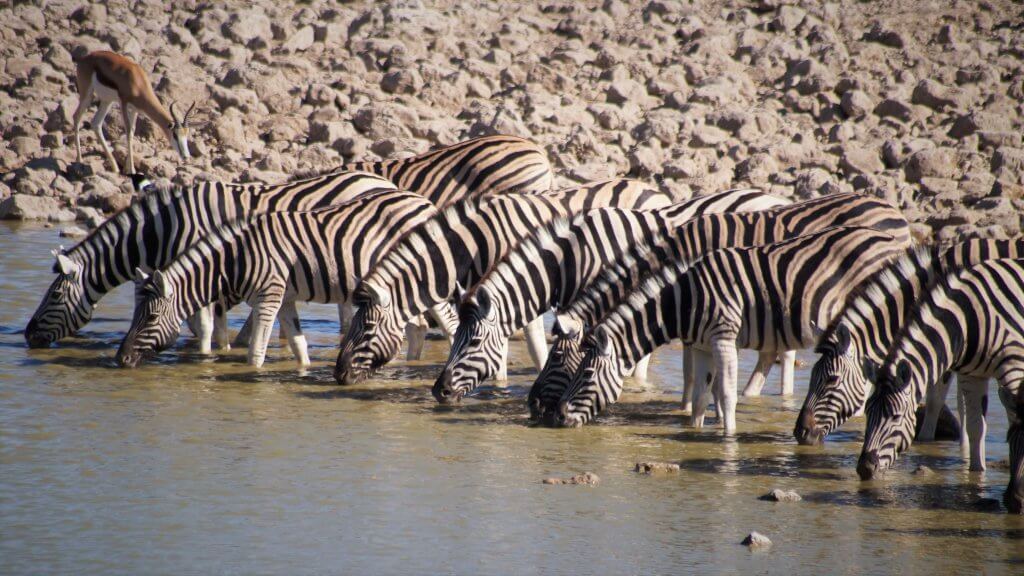
We all need to dress in khaki
Khaki is the signature colour of the African safari. However, it is not really necessary to dress the whole family in matching khaki, especially if you are self-driving and inside a vehicle.
The colours to actually steer clear of are blue and/or black colours as these colours attract tsetse flies, which have a nasty bite. Although in southern Africa, tsetse flies are not much of an issue.
I would also avoid white clothing (if you want to keep it white) and camouflage clothing (as this is often associated with military).
You may also like to read: Tips for a safari with kids under the age of 5 Is travelling Tanzania with kids worthwhile? Self drive Africa overland with kids: everything you need to know
- Search Please fill out this field.
- Manage Your Subscription
- Give a Gift Subscription
- Newsletters
- Sweepstakes
I Brought My Baby on an African Safari — Here's What I Learned on the Adventure of a Lifetime
It turns out a 10-month-old baby makes an incredible companion on a safari in South Africa — if only for the reminder to slow down and savor the wild moments.
When I imagined our first family safari , our 10-month-old daughter in tow, I never pictured releasing her onto the wild red Kalahari Desert sand to join a mob of 15 meerkats. (And yes, that's the proper term.) But there we were, watching Indah crawl curiously toward a trio of the diminutive mammals, reaching out her chubby hand in a choppy wave as they stared, frozen in myriad meerkat poses — one standing, leaned back on its kickstand-like tail, another crouched. With a longtime researcher overseeing the adorable interaction, she was so excited and they, too, were interested. This was the first human baby the clan had ever seen. We know this for a fact since they're habituated in Tswalu, a 111,000-hectare private reserve with a maximum of 28 guests.
I thought our guide, OB Medupe, was joking when he first mentioned we sit Indah amid all these funny little not-quite-foot-tall creatures. But he delivered, on that and so many more stunning moments while we lived our best lives at Tswalu, The Motse in January, followed by Sabi Sabi Bush Lodge — both in South Africa, a place with a seemingly universal love for babies. The adventure was planned in flawless detail by Extraordinary Journeys ' CEO, Elizabeth Gordon , and her team — several of them moms — using their encyclopedic knowledge of the most kid-friendly (not to mention low-malaria-risk) safari destinations on the African continent.
Before I continue, I'm aware that taking an infant on safari sounds out there. My past exploits were always hyper focused on wildlife photography, but I was eager to be more present and soak up the bush through fresh eyes. My husband, Keith, and I are adventurous travelers and wildlife lovers, and we want to expose our daughter, Indah, to the world early, layering in typical baby experiences with extraordinary ones, too. We feel it's important for her to hear other languages and accents, and be loved by others who are not her family. She won't remember waving at giraffes and jabbering at elephants, having her diaper changed 20 feet from a leopard, or eating biltong in the bush during sundowners, but I'm confident those experiences will wiggle into her subconscious and positively affect her world view and sense of connection.
In contrast to her small COVID bubble at home, Indah's safari sphere was infinite. The magic began the moment we touched down in Tswalu's sleek eight-seat aircraft and stepped into The Nest, living architecture where hundreds of sociable weaver birds flitted between their homes woven into the thatched roof. (The Fireblade Aviation hangar in Johannesburg was a lovely prelude, with a large kids' playroom, snacks, and wine.) They captivated our baby birder, her eyes dancing trying to follow them. We hopped into a Land Cruiser with OB and our tracker, Piet, who laughed when I joked that Indah had been waiting her whole life for this. "Her whole 10 months," cracked Keith. And with that, our safari — a Swahili word meaning journey — began, filled with rare species signature to the Kalahari Desert.
There, amid iconic orange sand with painterly layers of green, pink, and blue adding depth to the landscapes, we saw pygmy antelopes called steenbok, a slick black sable running like a mythical creature, and cheetah brothers, fur wet from the morning dew, walking coolly and sniffing around before stretching out on their backs in typical cat style. Our first giraffe sighting made a major impact, and Indah waved maniacally, pointed, and talked up a storm. These giant animals full of grace seemed to notice our tiny Dr. Dolittle, who spoke to them exuberantly.
The nickname stuck at Sabi Sabi, where our soft-spoken yet knowledgeable guide, Andries Ndlovu, responded to Indah's evocative chatter aimed at a sea of impalas with, "Who knows, they might understand you!" As a soon-to-be first-time dad, he loved her enthusiasm. But Indah's spirited full-body communication made us nervous at times, too, like while watching a thick-maned male lion nurse a fresh forehead wound. Andries knew from experience that this cat had no interest in us, but my heart nearly jumped out of my chest when he sat up just as Indah started voicing her hangry cues. I quickly begin nursing her as he walked past, a few nail-biting feet away. In contrast, I didn't worry at all when we rolled up on a maternal lioness that Andries called "a tough cookie" as she dozed in a sandy riverbed with her two girls.
Be prepared for your child to occasionally scare off wildlife, like when Indah's excited yelp frightened a beautiful cheetah before I could lift my camera. Overwhelmingly, however, she seemed to have little impact on the wild, though she made an impression on visitors surprised to spot a human baby. Animal babies weren't a rarity, though, like when we saw an elephant family of mamas, daughters, aunties, and sisters, the little ones running playfully and adults using their trunks to bathe in sand that looked like shimmering gold in the morning sun. I'd typically be all over that moment with my telephoto lens, but Indah was still waking up and I happily tended to her. A bonus? I got to take the magnificent parade in with my eyes instead of through a camera.
Our protective instincts flared up again amid an idyllic scene of dazzling zebras, wildebeest, a spectacular saddle-billed stork, and more elephants, including the animal world's version of a six-ton bodybuilder on steroids: a male musth. The strong earthy smell washed over us in the breeze, signaling an aggressive guy who moments later charged, looking positively ginormous beside another vehicle. In the excitement, Indah fell asleep, soothed somehow by the deafening cacophony of birds. She was still out when we met a leopard, legs and tail dangling from a high tree branch — the picture of chill yet amazingly alert with yellow eyes.
A monumental mama white rhino with her precious baby most engaged Indah as they grazed their way closer to us, munching on grass and clearly curious about this outrageously loud yet petite creature gesticulating and calling in a tiny Sabi Sabi safari hat. Rhinoceroses balance bad eyesight with superior smell and hearing, so when Indah did what babies do best, she played right into their senses. Mama, a mere 15 feet from our vehicle, actually jumped, turned, and trotted away. Yes, our child's number two ended this most intimate rhino encounter.
Fortunately, she didn't frighten away Tswalu's full-time baby whisperer (a.k.a. child minder), Sanna, a sweet South African Mary Poppins who Indah immediately hopped to like a lemur. It was a trip to have someone swing by and snag our baby, then return her smiling and clutching a flower or seed pod. On one occasion, when looking for our daughter, I was told, "Indah's in the spa having a treatment and Sanna says she's not done yet." I laughed and headed over to find Indah sitting on Sanna's lap eating a cookie, her feet being lovingly rubbed by a masseuse. Sanna's fun watch enabled Keith and I to get a massage, and also have the culinary adventure of a lifetime at Klein Jan , the surprising restaurant by Michelin-starred South African chef Jan Hendrik van der Westhuizen. A fellow diner aptly described it as the "James Bond of dining experiences."
At Sabi Sabi, our housekeeper, Busi, doubled as a babysitter. When we returned one night to our stunning suite — a two-bedroom with three bathtubs, including a pair in the glorious glass-encased primary bathroom — at 9 p.m., we were shocked and amused to find a dazed-looking baby tied around Busi's back. It was a hilarious cultural exchange moment for Indah, who'd apparently woken up hours earlier and didn't want to go back to sleep. (The concept of letting a baby fall back asleep unassisted does not seem to translate.)
Gordon had promised these properties would cater well to Indah, and she was spot on. Sabi Sabi has a vibrant, vast kids' camp, dubbed EleFun Centre. Chefs at both camps happily prepared special meals for Indah at the odd times we needed them — say 4 p.m. so she could eat dinner on the road. Our first attempt was somehow smoother than in a high chair, despite bumping along corduroy roads. (Pediatricians recommend babies have good head and neck stability for these rough rides, and sit in a rear-facing car seat.) We also stashed croissants and rusks for a mid-drive snack to keep Indah occupied.
A few more practical tips: Pack lots of layers for multiple seasons in one day. (We'd also sprayed Indah's clothes with permethrin in advance, and none of us got a single mosquito bite.) Give yourselves a few days before starting the safari to adjust to South Africa time. Four Seasons Hotel The Westcliff, Johannesburg — wonderful with baby amenities — makes a lovely first stop for resetting internal clocks and circadian rhythms plus spending relaxed days at the pool and lush grounds.
Above all, be comfortable with flexibility. It's amazing how a little one's enthusiasm for exciting newness can trump exhaustion. Our guides were adaptable to our timing, plus we had a private vehicle. And we alternated nights keeping Indah up later with ones where we put her down early with a sitter so we could have adults-only drives. The first evening, I tried putting her to sleep in the car seat while we spotted wildlife and a nest of sweet just-hatched birds, but she cried so loudly that OB said she sounded like a distressed cob. So, defeated, we stopped for gin and tonics as Indah sat in the tracker seat, jubilant despite her tired red eyes.
Even at 10 months, Indah seemed to come into her own in Africa, as so many adults do. Observing her being as social, trusting, and fearless toward animals, as she was with all the guides, trackers, hosts, servers, and housekeepers, was a pure joy. Her beautiful unbridled energy rubbed off on everyone, especially me — I actually found myself waving to a group of impalas when she wasn't around. "When you stop looking and just enjoy, it's like the animals come to you," Andries said at one point, enjoying our baby-led pace, too. It was a wonderfully chill vibe with less pressure than on previous safaris. I felt connected: to the wildlife, to the landscapes, to Africa, and to Indah, who nursed a ton and took incredible naps, including one for nearly two hours in my arms as we cruised through the Kalahari calmly looking for rhino tracks.
Being outside all day long in fresh air helped lull Indah into slumbers I know had to be filled with the fantastical wildlife we were seeing. And no, she won't recall actually seeing them, but I believe those memories will infiltrate her dreams for a long time to come. Mine, too.
Related Articles
Choose The Best African Safari Location With These Tips From Travelers Who Have Been There
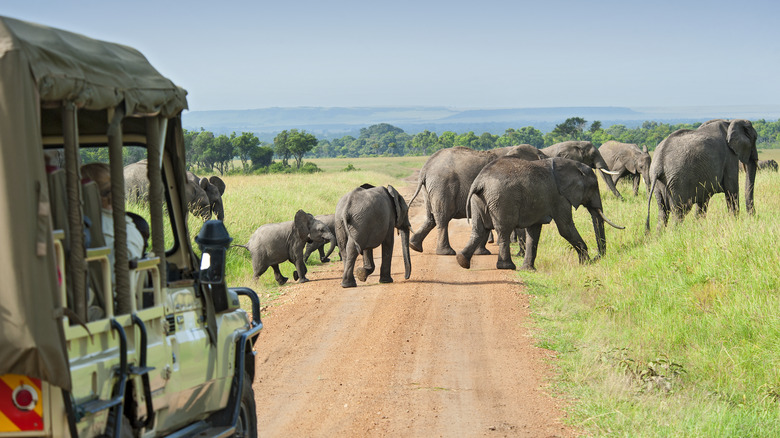
When we speak about African safaris, we tend to fall into the pit of discussing them the way we speak about the entire continent of Africa: lumping the continent's rich diversity into one pot. But, much like there are dozens of countries in Africa, each teeming with their own cultures, foods, and traditions, there are multiple safari locations that each offer their own set of wildlife, landscapes, and attractions. Each location has its own unique experience, making selecting the perfect safari spot a daunting task.
To help you plan your safari of a lifetime, we've gathered insights and recommendations from seasoned travelers who have explored the diverse landscapes and abundant wildlife of Africa's most iconic safari destinations. Whether you're in it just to see the Big Five, seeking a culturally-enriching experience, or limited by budget, these insider tips will guide you in choosing the best African safari location for your next adventure.
When envisioning an African safari, most people undoubtedly think of Kenya — and for good reason. Kenya is home to all of The Big Five: lion, leopard, elephant, buffalo, and rhino. Across Kenya's multiple game reserves, you have incredible chances of spotting these beasts. Of these reserves, the Maasai Mara is famed for the Great Migration every July to October. During this period, over 1.5 million wildebeests and hundreds of thousands of zebras and gazelles migrate from the Serengeti in Tanzania in search of fresh graze. This migration offers a truly spectacular sight, often regarded as one of the Seven Natural Wonders of Africa.
After witnessing the safari powerhouses, you can travel to Lake Nakuru National Park, where majestic fuchsia-pink flamingos scatter over the lake's surface. But beyond the incredible wildlife viewing opportunities, Kenya also offers stunning landscapes. Amboseli National Park is known for its large elephant herds that amble against the breathtaking backdrop of Mount Kilamanjaro, a mountain you can climb for some ethereal views from above the clouds.
Despite its fame and well-developed tourism infrastructure, Kenya's safaris have maintained their "timeless" feel. According to Audley Travel , Kenya is the location for you if you want to experience nature in its raw form. Moreover, you can experience Kenya's natural beauty without breaking the bank, as per Haydar Experiences . In this regard, Kenya's popularity may actually be a boon, since there are so many tour operators available to work with. However, if crowds seriously irk you, you're better off choosing another location from this list.
In terms of major attractions, northern Tanzania is pretty on par with Kenya, with opportunities to witness the Big Five at Ngorongoro Crater, which, according to Hayard Experiences, lucky travelers could see "all in one day." Tanzania also offers sight of the beginning of the Great Migration through Serengeti National Park. However, for safari-goers who'd like to avoid peak season, there is another unparalleled experience in the Serengeti during the winter months, from January to March. This is calving season, when visitors can witness the miracle of life as thousands of young animals are born. From Tanzania, you can also gape at Mount Kilimanjaro, albeit, not from the same angle as in Kenya.
Traveling south, Tanzania offers several lesser-known parks and reserves, including Ruaha National Park and the Selous Game Reserve. Selous (now known as Nyerere National Park) stands as one of the largest protected areas in Africa. Here, safari-goers can hop out of their vans and ATVs wan walk along the park or boat through the waterways, offering a refreshing perspective on the ecosystem.
Rich cultural experiences are also a hallmark of Tanzanian safaris. Visitors can engage with the Maasai people or visit the Hadzabe tribe, one of the last hunter-gatherer groups in Africa. Like Kenya, Tanzania offers a wide range of accommodations, as well as a diverse range of tour packages. But, Tanzania's road infrastructure makes travel within the country super easy. This combination of convenience and unique wonder is why Hayard Experiences lists Tanzania as the top choice for first-time safari-goers.
Though Zimbabwe is a lesser-travelled location for safari due to myths and misconceptions of political instability, it actually offers some of the best chances of witnessing The Big Five. Zimbabwe's Hwange National Park, the largest game reserve in the country, is renowned for its large elephant herds, lions, leopards, buffalo, and rhinos, so you can see these large beasts with less crowds around you. This factor is quite appealing for those seeking a more adventurous experience, since Zimbabwe's Mana Pools National Park offers walking safaris and canoeing experiences, which can become dangerous if there is too much foot traffic. This park, situated along the Zambezi River, lets visitors get up closed and personal with wildlife so they witness water species such as hippos and crocodiles which are hard to come by on land-based safari locations.
In addition to its rich wildlife, Zimbabwe is home to one of the world's largest and most spectacular waterfalls, Victoria Falls. The falls are most impressive during the wet seasons, from April to May, when the Zambezi River is at its fullest, creating a breathtaking display of water and mist.
If you're looking for a more rugged experience, and are open to traveling through a country whose tourism sector is still developing, then Zambia is the location for you, according to Elite Voyage . Though the infrastructure is not as developed as Kenya's or Tanzania's, Zambia's unique walking and canoe safaris, and lesser crowds make for intimate and special nature expeditions.
South Africa
South Africa's high season for safari is a little earlier in the year, from May to September, which lines up well with summer vacations for those planning to travel with families. This time of year is when it is slightly cooler, making for a comfortable experience, and when game viewing is at its best. The country's most popular game reserve is Kruger National Park, offers diverse landscapes ranging from savannas to woodlands to riverine forests. Adjacent to Kruger is the Sabi Sands Game Reserve, known for its luxury lodges and high chances of leopard sightings. If you're keen on seeing majestic elephants, Addo Elephant National Park is famous for its elephant conservation efforts, and home to one of the densest African elephant populations on the continent.
One of the unique aspects of a South African safari is the ability to self-drive, allowing you to take control of your own safari experience. This gives you the freedom to explore at your own pace, which is a draw for those who don't like to be rushed or feel that they are being controlled by a tour operator's itinerary. Of course, if you are by yourself, make sure you know what to do if you encounter dangerous animals, like snakes up close.
Another drawing factor about South Africa is that it is home to bustling cities like Johannesburg and Cape Town. If you're someone who'd like a well-rounded trip that doesn't limit you only to the wilderness, then South Africa may be the location for you, per Elite Voyage.
Last but not least on our comparison list is Botswana, a destination renowned for its unspoiled wilderness and commitment to conservation. Botswana is home to the Okavango Delta, a unique inland delta that floods annually, creating a lush, water-rich habitat teeming with wildlife from the renowned giraffe and antelope, to lesser-known unusual animals like the lechwe and topi. The best time to visit the Okavango Delta is from June to October, during the flood season, when wildlife congregates around the water and the scenery is at its most spectacular. Outside of the Delta, Botswana also boasts large elephant populations, particularly at Chobe National Park, where you can see four of the Big Five (the rhinoceros is hard to come by here due to poaching in the past).
If you're conscious about leaving no trace and want to participate in low-impact tourism, Botswana is the location for you. Though it will cost you a pretty penny, Botswana's safari expeditions are committed to ensuring their pristine environments are preserved now. The trade-off for these higher prices is that tourists are fewer in this part of the continent, allowing for a more exclusive, intimate experience at the lodges and camps, which for Audley Travel creates a truly immersive wilderness experience unlike any other.
Recommended
Travel | May 17, 2024
Get a Taste of South Africa Through These 15 Photos of Stunning Wildlife and Vibrant Communities
From desert landscapes to glittering beaches, see what this country has to offer
:focal(1200x903:1201x904)/https://tf-cmsv2-smithsonianmag-media.s3.amazonaws.com/filer_public/e7/31/e7312d75-0aa3-49af-a029-12102cc22222/1-opener.jpg)
Text by Tracy Scott Forson
Photographs selected by Jeff Campagna
With nearly 20 national parks across the country, South Africa has more than enough beautiful landscapes and wild fauna to attract naturalists, conservationists and animal lovers. Safari tours are common, and travelers are able to see everything from antelopes to zebras. Add to that the waterfalls, distinct vegetation and scenic oceans, and you have an unforgettable journey to one of the most beautiful countries in the world. See for yourself.
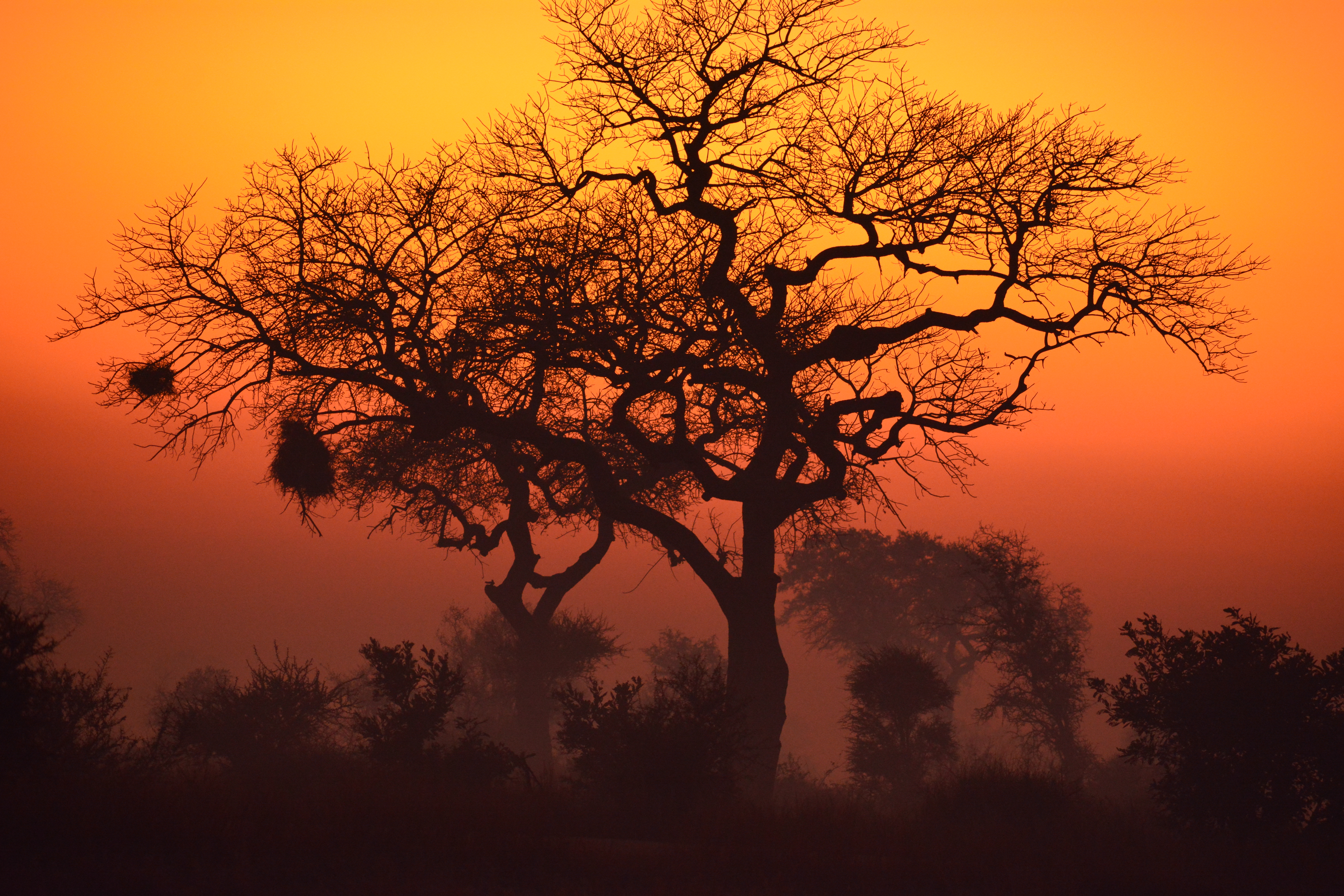
Get the latest Travel & Culture stories in your inbox.
Tracy Scott Forson | READ MORE
Tracy Scott Forson is a senior editor at Smithsonian magazine.
/https://tf-cmsv2-smithsonianmag-media.s3.amazonaws.com/accounts/headshot/Jeff-Campagna-240.jpg)
Jeff Campagna | | READ MORE
Jeff Campagna is a photo editor at Smithsonian magazine. You can follow him on Instagram at @jeffcampagna .

Safari Clothing For Boys & Girls
Uncompromising outdoor & safari clothing range for boys and girls which offers high levels of sun protection and insect defence for your kids for everywhere from the back garden to a safari in Africa. Dress them for exciting days on your family outings in clothing made from technical fabrics and kit them out with accessories for the young explorer.
- Safari Clothing
- Boys & Girls Safari Clothing
- Boys & Girls x
- Trousers & Shorts
- Jackets & Fleeces
- Safari Hats
- Beanies & Scarves
- Dresses & Skorts
- Shoes & Boots
- Socks & Ankle Gaiters
- Holdalls & Duffle Bags
- Weekenders & Carry-ons
- Backpacks, Satchels & Small Bags
- Toiletry Bags for Travel
- Totes & Champagne Coolers
- Business bags
- Luggage Trolley
- Pannier Bags
- Pet Feeders
- Locks & Scales
- Gift Vouchers
- Books & Maps
- Multi-tools
- Insect Repellent
- Torches (flashlights)
- Straps & Mounts
- Trophy Cameras
- Binocular Photography
- Cleaning Kits
- Essential Accessories
- Travel Essentials
- Travel Adaptors
- Evenings, Outdoor & Travel Clothing
- Outdoor, Travel & More
- Safe drinking water
- Rufiji™
- Mara&Meru™
- Barmah Hats
- Thusk™
Technologies
- Insect Protection
- Sun Protection
- Anti-bacterial
- Wicking & QuickDry
- BUGTech™
- Bonded Fleece
- Security Pocket
- Roll-up sleeve tabs
- MaraTech™
- Blister Protection
- Protect Yourself
Boys & Girls Safari Shirts Read our Boys & Girls Safari Shirts Advice Guide
The advice below is a summary. If you are looking for more information & expert advice then please click here for our full safari shirt advice section
- It is important that you pack safari-suitable shirts for your children on safari which also offer maximum protection from the elements and defence from most biting insects.
- Pack children's safari shirts in neutral, natural tones such as shades of khaki, brown, and green.
- We recommend long-sleeved safari shirts for children with roll-up sleeve tabs over short-sleeved shirts. These enable boys and girls to roll their sleeves up and down to stay cool, keep warm, or to avoid sunburn on their arms. It also increases defence from most biting insects when sleeves are rolled down, which is further increased when the fabric is treated with insect repellent.
- Kids' safari shirts with a collar also give your kids added protection from sunburn - and, again, from insect bites.
- Look for children's safari shirts which have the following key characteristics: the ability to wick moisture to keep them cool, high level of sun protection (SPF50+ is best), and an anti-insect fabric finish assists in reducing bites from most flying and biting insects.
- Pack more children's safari shirts made from man-made fibres (polyamide) than natural fibres (such as cotton). Man-made fibres are better at wicking moisture from the skin - and it is this movement of moisture which will keep them cool.
Number of children's safari shirts to pack for their safari: Up to 4-day safari: x 2; Up to 8-day safari: x 4; Up to 12-day safari: x 6
Boys' & Girls' BUGTech Anti-Insect Safari Shirt in Katavi Khaki
Boys' & girls' bugtech anti-insect safari shirt in willow, girls' young rangers club v-neck t-shirt in desert olive, boys' young rangers club round-neck t-shirt in safari kudu, boys' & girls' adventure trek long-sleeved shirt in dark khaki, boys & girls safari trousers & shorts read our boys & girls safari trousers & shorts advice guide.
- When packing safari trousers for your children, pack children's safari pants made from safari-suitable colours (shades of green, khaki, and brown) and lightweight, strong fabric. Nothing beats the feeling they will get when they wear safari trousers worthy of a great conservationist or early explorer.
- Children's safari zip-off/convertible trousers are the simplest safari trousers to pack for children as they allow for maximum versatility. By removing or adding the legs, you are able to convert them from trousers when cool to shorts when hot. Children's convertible zip-off safari pants also save on valuable packing space by being two garments in one. The legs on the children's safari convertible pants also give added protection from the sun and defence from most biting insects - even more so when their safari trousers are treated with built-in sun protection and anti-insect treatment.
- The ideal children's safari trousers and safari shorts should offer the perfect blend of the following functionality: lightweight with built-in ripstop for added strength, a high level of built-in sun protection (SPF50+ is best), and an anti-insect finish.
- Children's safari trousers which are made from man-made fibres (such as polyamide) are preferred over those made from natural fibres (such as cotton) to keep your children cool while on safari. These fabrics also allow your child to dry off faster should their safari trousers get wet from a rain shower or from mucking about in a stream (a crocodile- and hippo-free stream of course).
- What is more, you will be able to wash and dry your kid's safari trousers much faster when made from man-made fibres such as polyamide.
Boys' & Girls' BUGTech Zip-Off Safari Trousers in Baobab
Boys' & girls' bugtech zip-off safari trousers in willow, boys' & girls' bugtech zip-off safari trousers in katavi khaki (new fit leg), boys' & girls' bugtech zip-off safari trousers in willow (new fit leg), boys' & girls' maratech™ zip-off safari trousers in serengeti stone, boys' & girls' maratech™ zip-off safari trousers in okavango olive, boys & girls safari hats read our boys & girls safari hats advice guide.
The advice below is a summary . If you are looking for more information & expert advice then please click here for our full safari hat advice guide .
- Keep your kid's faces out of the sun on safari activities by packing a wide-brimmed safari hat.
- With average high temperatures reaching mid-20 to mid-30 degrees Celsius on most safaris and with safari areas in Kenya, Tanzania, Botswana, and Zambia high above sea level, protecting your children on safari is important as the effects of the sun will be pronounced and the risk of being burnt by the sun will be high. As a wide-brimmed safari hat sits on your children's head, it is their most important first line of defence against a hot midday African sun. Always remember to pack sunscreen though too.
- When it pours with rain on safari and your kid's want to splash about in puddles - or if you are caught out in downpour while on a safari activity, their wide-brimmed safari hat will help keep their face and neck dry - and the rain drops out of their eyes.
- Colour is key when choosing a safari hat for your boy(s) or girl(s) - with neutral shades such as khaki, green, or brown the best. Looking the part will also get your children into the theme of their incredible family safari too.
- Modern wide-brimmed safari hats are conveniently packable too and so do not lose their shape when you take them out of your luggage. If they have lost a bit of shape - or your children have accidentally stomped on their hat - you are usually easily able to manipulate their safari hat back into shape. Never crush your safari hat under a hard object - such as shoes or binoculars - when packing, or let your children sit on their safari hat.
Number of wide-brimmed children's safari hats to pack for your safari: 1 x wide-brimmed safari hat per child. *Don't forget to also pack a safari beanie to keep their heads warm for the African winter - or high altitude safari.
Please note that for the main product images we have not shown kids - only adults - wearing our hats. As the head grows faster than the rest of the body we have found that kids will always fit into "adult" hats so please shop from the products below, and use our size charts to get the correct fit for your kids.
Men's Explorer Canvas Safari Hat (Adjustable) in Meerkat
Men's explorer canvas safari hat (adjustable) in khaki, men's explorer leather safari hat (adjustable) in driftwood, adventurer hat in khaki, adventurer hat in olive, women's indie safari hat in winter grass, women's serengeti safari hat in tawny, removable, adjustable chin strap for hats in olive, men's panama safari hat (adjustable) in tawny, squashy leather oiled safari hat in dark brown, foldaway leather suede safari hat in hickory, foldaway bronco full grain leather safari hat in dark brown, barmah hats waterproofing and conditioning spray – 150ml pump spray (suitable for leather & suede), boys & girls safari jackets & fleeces read our boys & girls safari jackets & fleeces advice guide.
- Children feel the cold faster than adults and so it is important when going on safari to pack a children's safari fleece to keep them warm and snug on early morning and evening game drives and through the African winter.
- Pack a kid's safari fleece which is made from safari-friendly colours such as brown, greens, and khaki.
- Pack a safari-coloured waterproof layer for each child if you are travelling over the rainy season for your safari.
- Having lived in Africa through the rains we are also able to advise that the daytime temperature goes from very hot before the rains start, to much cooler once the rains have settled in. The difference may be as much as 10 to 15 degrees celsius below the average temperatures and so again we advise that a fleece or jacket is packed to keep you warm.
Number of boys' and girls' safari jackets or safari fleeces to pack for your safari: 1 x safari fleece or jacket; 1 x waterproof safari jacket should you be travelling over the rainy season.
Boys' & Girls' SafariElite Bonded Safari Fleece in Safari Sage & Sand
Waterproof packaway safari jacket for kids in safari green, essential waterproof safari poncho in khaki, boys & girls safari socks & ankle gaiters read our boys & girls safari socks & ankle gaiters advice guide.
- Walking in the bush while on safari is the quintessential experience. We recommend it to all who go to Africa.
- Whether you go for a short nature walk with your guide or a multi-day walking safari, please ensure that you pack safari-coloured safari socks which offer a double layer for blister protection. Bad blisters ruin good walks.
- Ankle gaiters are ideal for walking in the bush as they offer both your ankles and socks more protection from thorns, wet grass, grass seeds, and anything scurrying around at ankle level. A must-have for longer walking safaris, but useful on any bush walk.
Number of blister-proof socks to pack for your safari: Up to 4-day safari: x 2; Up to 8-day safari: x 3; Up to 12-day safari: x 4.
Number of Ankle Gaiters to pack for your safari: Pack 1 x Pair per person.
Mara&Meru Ultimate Anti-Blister Socks (Active, Everyday, Safari) in Olive Green
Rufiji™ safari canvas gaiters (unisex) in safari tan, rufiji™ safari suede gaiters (unisex), boys & girls safari beanies & scarves read our boys & girls safari beanies & scarves advice guide.
- Pack a multi-functional Head&Neck scarf for just about all outdoor adventures, including safari. Head&Neck Scarves keep your neck and head out of the sun when it is hot, and provide an element of warmth too when it starts to get cold. They offer maximum versatility.
- Pack children's garments and accessories for your safari which protect them from the cold and which keep them cosy and warm. Safari scarves, safari beanies, and safari gloves for children should be considered a packing essential over the African winter - and may also be required for some mornings on summer safaris too.
- At the very least we recommend packing a safari beanie for your kids on any safari as a safari beanie is so small and light to carry in their luggage, yet have a big effect on how warm you are able to keep your children should it get cold. Keep their safari beanie in your or their small bag which you take on game drives.
- Further to the point above, for the African summer pack a safari beanie for your kids just in case the mercury drops. For the most part their wide-brimmed safari hat should keep them warm enough, but why take the risk? Please do take note too of the altitude of the area in which you are going on safari. The Ngorongoro Crater in Tanzania, as an example, is over 2000 metres above sea level and most camps are on the rim of the crater and so may have cold temperatures (morning and evenings in particular) and precipitation throughout the year and we would recommend taking warmer safari accessories just in case.
- Pack safari scarves, safari beanies, and safari gloves in safari colours.
Number of children's safari scarves, safari beanies, and safari gloves to pack for your safari: 1 x safari scarf; 1 x safari beanie; 1 x kid's safari gloves - although your kids should be able to keep warm by tucking their hands into their children's safari jacket or fleece.
Please note that we do not yet have images of kids wearing our beanies and scarves range - but they will fit as the head grows faster than the rest of the body - so please shop from the products below.
Thusk™ Zulu Knitted Headband in Winter Sand
Vintage print tubular head&neck scarf in giraffe, vintage print tubular head&neck scarf in zebra, vintage print tubular head&neck scarf in giraffe&zebra, vintage print tubular head&neck scarf in zebra olive, vintage print tubular head&neck scarf in giraffe&zebra olive, vintage print tubular head&neck scarf in lion, vintage print tubular head&neck scarf in buffalo, vintage print tubular head&neck scarf in buffalo olive, thusk™ zulu cable knit beanie in winter sand, thusk™ zulu cable knit beanie in winter sage, thusk™ zulu knitted button-scarf in winter sage, thusk™ zulu knitted bow-scarf in winter sand, thusk™ zulu rib knit beanie in winter sage, thusk™ zulu rib knit beanie in winter sand.
This website uses cookies for it's shopping basket, you must have cookies enabled in order to use this site.

Choose The Best African Safari Location With These Tips From Travelers Who Have Been There
W hen we speak about African safaris, we tend to fall into the pit of discussing them the way we speak about the entire continent of Africa: lumping the continent's rich diversity into one pot. But, much like there are dozens of countries in Africa, each teeming with their own cultures, foods, and traditions, there are multiple safari locations that each offer their own set of wildlife, landscapes, and attractions. Each location has its own unique experience, making selecting the perfect safari spot a daunting task.
To help you plan your safari of a lifetime, we've gathered insights and recommendations from seasoned travelers who have explored the diverse landscapes and abundant wildlife of Africa's most iconic safari destinations. Whether you're in it just to see the Big Five, seeking a culturally-enriching experience, or limited by budget, these insider tips will guide you in choosing the best African safari location for your next adventure.
Read more: The 13 Most Breathtaking Places To Camp In The United States
When envisioning an African safari, most people undoubtedly think of Kenya — and for good reason. Kenya is home to all of The Big Five: lion, leopard, elephant, buffalo, and rhino. Across Kenya's multiple game reserves, you have incredible chances of spotting these beasts. Of these reserves, the Maasai Mara is famed for the Great Migration every July to October. During this period, over 1.5 million wildebeests and hundreds of thousands of zebras and gazelles migrate from the Serengeti in Tanzania in search of fresh graze. This migration offers a truly spectacular sight, often regarded as one of the Seven Natural Wonders of Africa.
After witnessing the safari powerhouses, you can travel to Lake Nakuru National Park, where majestic fuchsia-pink flamingos scatter over the lake's surface. But beyond the incredible wildlife viewing opportunities, Kenya also offers stunning landscapes. Amboseli National Park is known for its large elephant herds that amble against the breathtaking backdrop of Mount Kilamanjaro, a mountain you can climb for some ethereal views from above the clouds.
Despite its fame and well-developed tourism infrastructure, Kenya's safaris have maintained their "timeless" feel. According to Audley Travel , Kenya is the location for you if you want to experience nature in its raw form. Moreover, you can experience Kenya's natural beauty without breaking the bank, as per Haydar Experiences . In this regard, Kenya's popularity may actually be a boon, since there are so many tour operators available to work with. However, if crowds seriously irk you, you're better off choosing another location from this list.
In terms of major attractions, northern Tanzania is pretty on par with Kenya, with opportunities to witness the Big Five at Ngorongoro Crater, which, according to Hayard Experiences, lucky travelers could see "all in one day." Tanzania also offers sight of the beginning of the Great Migration through Serengeti National Park. However, for safari-goers who'd like to avoid peak season, there is another unparalleled experience in the Serengeti during the winter months, from January to March. This is calving season, when visitors can witness the miracle of life as thousands of young animals are born. From Tanzania, you can also gape at Mount Kilimanjaro, albeit, not from the same angle as in Kenya.
Traveling south, Tanzania offers several lesser-known parks and reserves, including Ruaha National Park and the Selous Game Reserve. Selous (now known as Nyerere National Park) stands as one of the largest protected areas in Africa. Here, safari-goers can hop out of their vans and ATVs wan walk along the park or boat through the waterways, offering a refreshing perspective on the ecosystem.
Rich cultural experiences are also a hallmark of Tanzanian safaris. Visitors can engage with the Maasai people or visit the Hadzabe tribe, one of the last hunter-gatherer groups in Africa. Like Kenya, Tanzania offers a wide range of accommodations, as well as a diverse range of tour packages. But, Tanzania's road infrastructure makes travel within the country super easy. This combination of convenience and unique wonder is why Hayard Experiences lists Tanzania as the top choice for first-time safari-goers.
Though Zimbabwe is a lesser-travelled location for safari due to myths and misconceptions of political instability, it actually offers some of the best chances of witnessing The Big Five. Zimbabwe's Hwange National Park, the largest game reserve in the country, is renowned for its large elephant herds, lions, leopards, buffalo, and rhinos, so you can see these large beasts with less crowds around you. This factor is quite appealing for those seeking a more adventurous experience, since Zimbabwe's Mana Pools National Park offers walking safaris and canoeing experiences, which can become dangerous if there is too much foot traffic. This park, situated along the Zambezi River, lets visitors get up closed and personal with wildlife so they witness water species such as hippos and crocodiles which are hard to come by on land-based safari locations.
In addition to its rich wildlife, Zimbabwe is home to one of the world's largest and most spectacular waterfalls, Victoria Falls. The falls are most impressive during the wet seasons, from April to May, when the Zambezi River is at its fullest, creating a breathtaking display of water and mist.
If you're looking for a more rugged experience, and are open to traveling through a country whose tourism sector is still developing, then Zambia is the location for you, according to Elite Voyage . Though the infrastructure is not as developed as Kenya's or Tanzania's, Zambia's unique walking and canoe safaris, and lesser crowds make for intimate and special nature expeditions.
South Africa
South Africa's high season for safari is a little earlier in the year, from May to September, which lines up well with summer vacations for those planning to travel with families. This time of year is when it is slightly cooler, making for a comfortable experience, and when game viewing is at its best. The country's most popular game reserve is Kruger National Park, offers diverse landscapes ranging from savannas to woodlands to riverine forests. Adjacent to Kruger is the Sabi Sands Game Reserve, known for its luxury lodges and high chances of leopard sightings. If you're keen on seeing majestic elephants, Addo Elephant National Park is famous for its elephant conservation efforts, and home to one of the densest African elephant populations on the continent.
One of the unique aspects of a South African safari is the ability to self-drive, allowing you to take control of your own safari experience. This gives you the freedom to explore at your own pace, which is a draw for those who don't like to be rushed or feel that they are being controlled by a tour operator's itinerary. Of course, if you are by yourself, make sure you know what to do if you encounter dangerous animals, like snakes up close.
Another drawing factor about South Africa is that it is home to bustling cities like Johannesburg and Cape Town. If you're someone who'd like a well-rounded trip that doesn't limit you only to the wilderness, then South Africa may be the location for you, per Elite Voyage.
Last but not least on our comparison list is Botswana, a destination renowned for its unspoiled wilderness and commitment to conservation. Botswana is home to the Okavango Delta, a unique inland delta that floods annually, creating a lush, water-rich habitat teeming with wildlife from the renowned giraffe and antelope, to lesser-known unusual animals like the lechwe and topi. The best time to visit the Okavango Delta is from June to October, during the flood season, when wildlife congregates around the water and the scenery is at its most spectacular. Outside of the Delta, Botswana also boasts large elephant populations, particularly at Chobe National Park, where you can see four of the Big Five (the rhinoceros is hard to come by here due to poaching in the past).
If you're conscious about leaving no trace and want to participate in low-impact tourism, Botswana is the location for you. Though it will cost you a pretty penny, Botswana's safari expeditions are committed to ensuring their pristine environments are preserved now. The trade-off for these higher prices is that tourists are fewer in this part of the continent, allowing for a more exclusive, intimate experience at the lodges and camps, which for Audley Travel creates a truly immersive wilderness experience unlike any other.
Read the original article on Outdoor Guide


IMAGES
VIDEO
COMMENTS
Safari Kimanzi (or Kimanthi ), best known as just "Safari" (born 20 August 1993), is a Kenyan who as a six-year-old boy received extensive plastic surgery over the course of 12 months to correct disfigurement of his face, neck, shoulder and hand caused by severe burns when he was an infant in Kenya. He was operated on by a team of volunteers at ...
Accommodation is typically free for children under 5, so the only costs are park fees and flights. Slow it down: Consider four nights in each safari camp to give your kids some time to warm up to ...
African Safari with Kids Where to Go on An African Safari with Kids. For Kaleya's first safari trip, we chose to travel South Africa, Swaziland (now known as Eswatini) and Lesotho for several reasons: . Firstly, South Africa is one of the best wildlife destinations in the world, and chances of seeing the Big Five are very high.Some parts of southern Africa are free from malaria and safe to ...
47 shares. An Africa safari with kids was on our bucket list to experience as a family, and it was honestly one of the best things we could have done in South Africa. We explored Kruger National Park with the kids, saw the Big 5 animals, spent days on safaris and had an experience that was beyond expected in Africa.
Most organized safari trips have some kind of meal included. Usually, the guide will stop the vehicle in a safe area, set the table outside, and you will have an unforgettable meal in an African savannah. Most guided safaris will include water and other drinks. But you should always take some water with you.
We took mid-range guided safaris in Tanzania and Kenya and a luxury safari holiday in the Okavango Delta in Botswana. In our opinion, the best African countries to visit for a safari with young children are South Africa and Namibia for a few reasons. they offer great wildlife viewing in national parks where you can self-drive.
Green means go. While every luxury safari offers unforgettable wildlife encounters, there are plenty of options to consider. High-end African trips and settings vary hugely in their atmosphere and ...
Kenya. Kenya family safari holidays are ideal for teenagers who adore wildlife and conservation. The country has achieved some wonderful successes over recent decades, particularly in the field of rhino preservation. Horse riding at Lewa Wilderness, Kenya. Kenya also has a fantastic array of unique experiences that can't be found elsewhere.
That's why it's best to dress in layers and pack some warm clothing items like beanies, gloves, warm socks or thermal pajamas. Light thermal vests (sleeveless or short-sleeved) is another safari essential. Generally, this is the best thing you should know on your early stage of planning your African safari for kids.
Africa; Africa Safari Tours & Holidays; Take a walk on the wild side on an African safari. The word "safari" means "journey" in Swahili. And a safari in Africa is all about the journey. While seeing a leopard munch on a freshly caught gazelle or spying a curious lion cub venture away from its mother's protective embrace will be ...
South Africa for Families . With its first world infrastructure and world-class national parks, South Africa is the obvious choice for a family safari. There are game-viewing destinations for every budget, ranging from exclusive private reserves like Shamwari and Ulusaba to national parks like Kruger and Addo.The latter are a great option for families on a budget, as they allow self-driving ...
1 Week in Kenya with Kids. Days 1 - 3: Nairobi. Days 3 - 5: Lake Nakuru. Days 5 - 7: Maasai Mara National Reserve. *TIP: Maasai Mara is the best reserve in Kenya, but it's a 6-hour drive from Nairobi and Lake Nakuru. To go somewhere nearer, the best alternative is Amboseli National Park, a 4-hour drive away.
I believe in the old African proverb "The eye never forgets what the heart has seen". A phrase that best describes the feeling one gets after visiting Africa ... Bush to Beach Safari; Masai Mara Migration Safari; 10-day Uganda Safari; Kenya Horizon Safari; Flamingos and Elephant Safari; Trekking Mt Kilimanjaro; Destinations. Kenya; Uganda ...
Remember where you are. Do due diligence. Double check the age limits at your intended safari lodge before you book. Not all lodges allow small children on game drives for many of the reasons ...
Yes, we have wheelchairs available to rent for $5.00 and wagons available to rent for $8 at our Safari Bazaar Gift Shop, located underneath Kenya Gate! With each rental, a security deposit is applied, and refunded when the rental is returned. All rentals will be cleaned and sanitized before each use. More FAQs.
This serves as your guide to key considerations when going on your first African safari. With over 25 years of experience, we are well-equipped to provide you with invaluable insights. Venturing to Africa for the first time is an indescribable journey. It is a continent overflowing with enchantment - from its breathtakingly diverse landscapes ...
1. Lion cubs. Lionesses will give birth to a litter of one - four cubs and we were lucky to find this litter of four (though you can only spot three in the photo). An elephant herd is made up of mothers and aunts, along with the calves. 2. Elephant calf.
Photographic safari in Sabi Sands Game Reserve, South Africa. A safari (/ s ə ˈ f ɑːr i /; from Swahili safari 'journey' originally from Arabic Safar 'to journey') is an overland journey to observe wild animals, especially in Southeast Africa. The so-called "Big Five" game animals of Africa - lion, leopard, rhinoceros, elephant, and Cape buffalo - particularly form an important part of ...
For very small children, childminders will ensure they are fed, cleaned and have their naps while you are out on a game drive. 6. Add on a Beach Destination. Africa's most popular beach destination - the island of Mauritius - has plenty of child-friendly accommodation and under-twos are widely catered for.
As the trip name implies, Lion World Travel's 10-day Best of Cape Town & Botswana vacation package combines sightseeing in Cape Town, South Africa, with a classic safari in Botswana. During the ...
Unlimited admission to African Lion Safari during the 2024 season. 20% off food and non-alcoholic beverages at all on-site food service locations (excluding vending carts) 20% off gift shop merchandise at all on-site Safari Gift Shops (excluding batteries or sale items) Discounts to select off-season events, hosted by our onsite catering ...
The drinking age may be 18. In many countries, including South Africa, the legal age to drink alcohol is 18 and your teen's room may have a mini-bar in it. If the legal age is 21 back home, discuss how you will handle this (you can ask for all alcohol to be removed).
Heading to the Serengeti or Kruger National Park? African safaris are an incredible experience for anyone who is fortunate enough to visit. There is not a lo...
Doing an African safari as a family is expensive. Yes it certainly can be. The fees for some of the East African parks are extortionate and was the reason we decided NOT to visit the Serengeti when travelling Tanzania with kids.. However, parks in Namibia and South Africa are MUCH more affordable. For instance in Etosha, Namibia, day entry for foreign adults is N$150 (£6.25), then N$50 per ...
It turns out a 10-month-old baby makes an incredible companion on a safari in South Africa — if only for the reminder to slow down and savor the wild moments. By Kathryn Romeyn Published on ...
When envisioning an African safari, most people undoubtedly think of Kenya — and for good reason. Kenya is home to all of The Big Five: lion, leopard, elephant, buffalo, and rhino. Across Kenya's multiple game reserves, you have incredible chances of spotting these beasts. Of these reserves, the Maasai Mara is famed for the Great Migration ...
With nearly 20 national parks across the country, South Africa has more than enough beautiful landscapes and wild fauna to attract naturalists, conservationists and animal lovers. ... Safari tours ...
The Ngorongoro Crater offers a once-in-a-lifetime safari experience. As you descend into the world's largest inactive, intact, and unfilled volcanic caldera, you'll find an abundance of ...
Uncompromising outdoor & safari clothing range for boys and girls which offers high levels of sun protection and insect defence for your kids for everywhere from the back garden to a safari in Africa. Dress them for exciting days on your family outings in clothing made from technical fabrics and kit them out with accessories for the young explorer.
Kenya. When envisioning an African safari, most people undoubtedly think of Kenya — and for good reason. Kenya is home to all of The Big Five: lion, leopard, elephant, buffalo, and rhino. Across ...